 |
| In the Adventures of Buck Danny placed during the 60s and the 70s several famous US military aircraft are shown . Mostly of these are US Naval Aviation aircraft even if some US Air force aircraft and foreign aircraft are also present. |
|
Mikoyan-Gourevitch MIG-21 "Fishbed" |
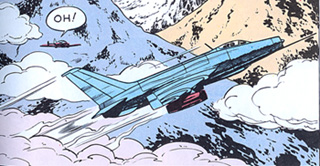
| A misterious MIG-21F-13 "Fishbed-C" is attacking Sonny Tuckson's aircraft in the story TOP SECTRET. |
Some MIG-21F-13 of the fantasy Central American Republic of Inagua are well depicted in the story ALERTE A CAP KENNEDY. |
 |
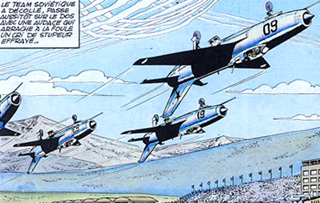
| The MIG-21 of the Russian Aerobatic Team flying by beautifull female pilots are shown in the adventures LES ANGES BLEUS and LE PILOTE AU MASQUE DE CUIR. |
A Vietnam war image with a MIG-21 shooting down an F-105 is shown in the story LES AGRESSEURS.
|
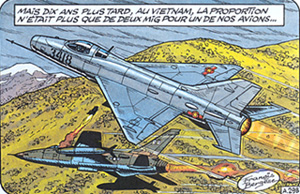 |
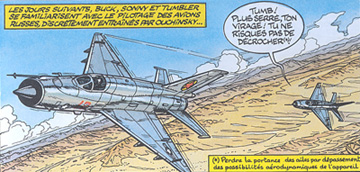 |
Always in the story LES AGRESSEURS
an advanced variant of the MIG-21, more likely a MIG-21PFM "Fishbed-F" belong to the USAF Agressor squadron of Nellis AFB is well depicted.
|
A couple of North Korean MIG-21 are also visible in the story LA NUIT DU SERPENT.
|
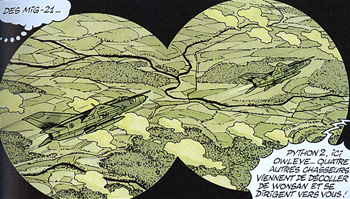 |
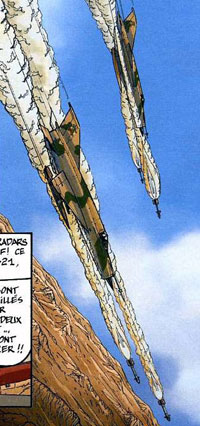 |
Some MIG-21 are also depicted in the story COBRA NOIR.
|
Some MIG-21 are also depicted by Arroyo in the Buck Danny classic #5 and #6 OPERATION RIDEAU DE FER and ALERTE ROUGE.
| 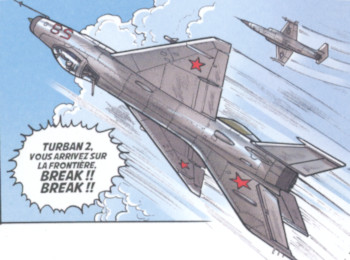 |
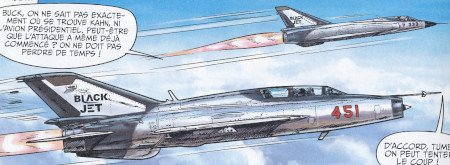 |
A two seat MIG-21 of the private company Balck Jet is well represented by Formosa in the story AIR FORCE ONE.
|
Some MIG-21 from Vietnamese Air Force are also depicted by Philippe in the Buck Danny album #61 TRAQUE E HAUTE ALTITUDE.
| 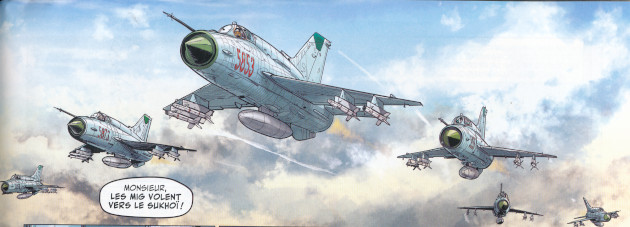 |
The Mikoyan-Gurevich MiG-21 (NATO reporting name "Fishbed") is a supersonic jet fighter aircraft, designed and built by the Mikoyan-Gurevich Design Bureau in the Soviet Union. Some 50 countries over four continents have flown the MiG-21, and it still serves many nations a half-century after its maiden flight. The fighter has the distinction of holding a number of aviation records, including 1) most produced supersonic jet aircraft in aviation history, 2) most produced combat aircraft since World War II, and 3) longest production run of a combat aircraft. It has been estimated that more than 10,000 MiG-21s were built.
| 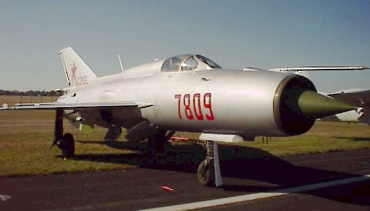 |
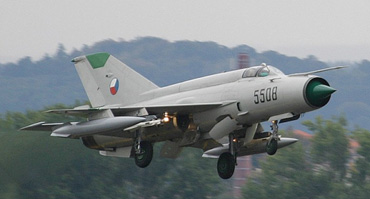 |
Its armament consisted of: One centerline twin-barrelled GSh-23 23 mm cannon , 200 rounds (PFM, MF, SMT, and bis variants) or one single-barrelled NR-30 cannon ,60 rounds (F-13 variant).
Up to 2,000 kg (4,400 lb) of air-to-air and air-to-ground weapons on two or four underwing hardpoints, depending on the variant. Early machines carried two Vympel K-13 (AA-2 Atoll) air-to-air missiles under the wing pylons. Late models carried two K-13 and two fuel tanks under the wing pylons or combinations of four K-13 infrared- and radar-guided missiles. The Molniya R-60 (NATO reporting name AA-8 Aphid) was also used on multiple pylons and six of them could be carried. Most aircraft carried a single 450 L (119 US gal) fuel tank on the centerline pylon.
|
|
Mc Donnell F-4 Phantom II |
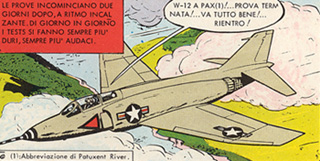 |
A Mc Donnell XF4H-1 is shown in the story PROTOTYPE FX-13. In this adventure the very early Phantom II prototype variant is tested at NAS Patuxent River with the fantasy designation of Mac Dougall XF-12.
|
A Mc Donnell YF4H-1 is one of the prototypes tested by the Buck Danny's ZZ Squadron on board of the USS Saratoga in the story LE RETOUR DES TIGRES VOLANTS. |
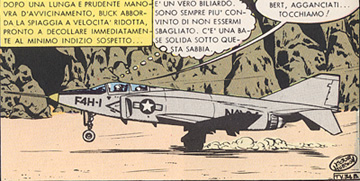 |
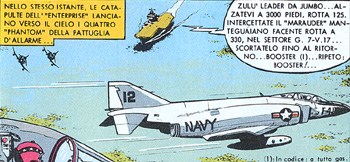 |
Some F-4B Phantom II from USS Enterprise are depicted in the story L'ESCADRILLE DE LA MORT |
A couple of F-4B are also shown in the first image of the story LES ANGES BLEUS
| 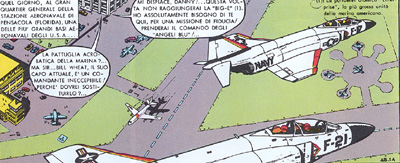 |
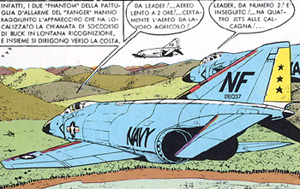 |
Some F-4J Phantom II from USS Ranger are depicted in the stories LA VALLEE DE LA MORT VERTE and REQUINS EN MER DE CHINE |
Two USAF F-4E Phantom II are well represented in the story OPERATION "APOCALYPSE" |
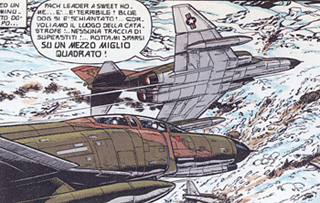 |
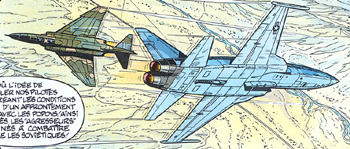 |
Another USAF F-4E is shown during a "Red Flag" dog fight against an Aggressor F-5E in the story LES AGRESSEURS
|
An USAF F-4C Phantom II "gate guardian" of Hickam AFB headquarter is represented in the story LA NUIT DU SERPENT |
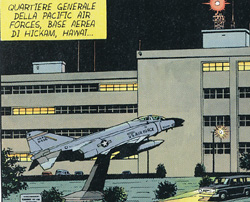 |
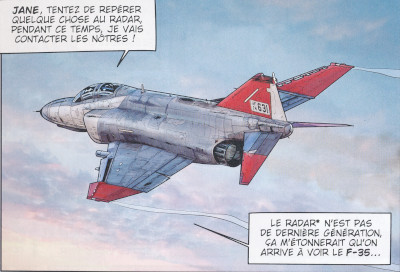 |
In the story LE PACTE! Buck Danny and Lady X are flying on an old USAF F-4F
|
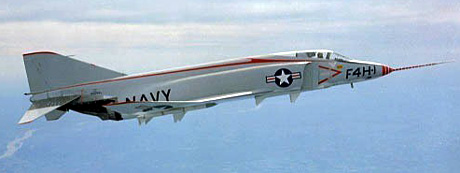 |
The McDonnell Douglas F-4 Phantom II is a two-seat, twin-engined, all-weather, long-range supersonic interceptor jet fighter/fighter-bomber originally developed for the U.S. Navy. Proving highly adaptable, it became a major part of the air wings of the U.S. Navy, U.S. Marine Corps, and U.S. Air Force. It was used extensively by all three of these services during the Vietnam War, serving as the principal air superiority fighter for both the Navy and Air Force, as well as being important in the ground-attack and reconnaissance roles by the close of U.S. involvement in the war.
|
The F-4 Phantom II was designed as a fleet defense fighter for the U.S. Navy, and first entered service in 1960. By 1963, it had been adopted by the U.S. Air Force for the fighter-bomber role. When production ended in 1981, 5,195 Phantom IIs had been built, making it the most numerous American supersonic military aircraft. Despite the imposing dimensions and a maximum takeoff weight of over 60,000 pounds (27,000 kg), the F-4 had a top speed of Mach 2.23 and an initial climb of over 41,000 ft per minute (210 m/s). Shortly after its introduction, the Phantom set 15 world records.
|
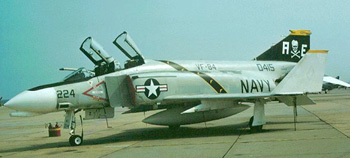 |
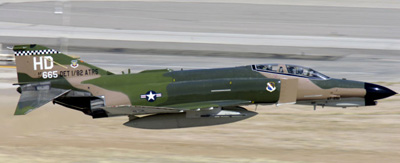 |
The F-4 can be armed with: Up to 18,650 lb (8,480 kg) of weapons on nine external hardpoints, including general purpose bombs, cluster bombs, TV- and laser-guided bombs, rocket pods, air-to-ground missiles, anti-runway weapons, anti-ship missiles, targeting pods, reconnaissance pods, and nuclear weapons. Baggage pods may also be carried. External fuel tanks of 370 US gal (1,420 L) capacity for the outer wing hardpoints and either a 600 or 610 US gal (2,310 or 2,345 L) fuel tank for the centerline station can be fitted to extend the range.
|
|
North American A3J (A-5) / RA-5 Vigilante |
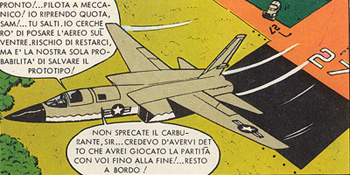 |
In the stories PROTOTYPE FX-13 and ESCADRILLE ZZ, Buck Danny and his comrades are involved at NAS Patuxent River in the preliminary flight test of a couple of Prototyes. The general design of one of these aircraft identified with the fantasy name of FX-13 is based on the North American A3J Vigilante |
Three North American RA-5C Vigilante are used by Buck Danny, Jerry Tumbler, and Sonny Tuckson in the story ALERTE A CAP KENNEDY.
|
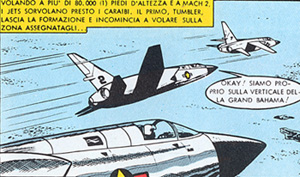 |
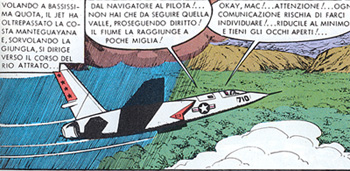 |
A nuclear strike bomber A-5A Vigilante from USS Enterprise is well depicted in the story ALERTE ATOMIQUE. |
The North American A-5 Vigilante was a powerful, highly advanced carrier-based supersonic bomber designed for the United States Navy. Its service in the nuclear strike role to replace the A-3 Skywarrior was very short. Its main armament was carried a B28 or B43 freefall nuclear bomb in a novel linear bomb bay between the engines in the rear fuselage which was intended to make bomb delivery safer and more accurate.
|
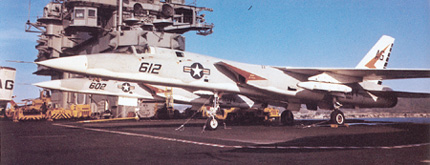 |
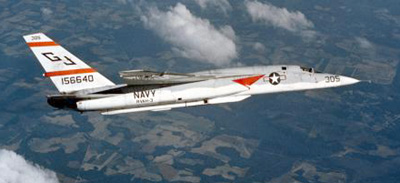 |
The reconnaissance version of the Vigilante, the RA-5C, had slightly greater wing area and added a long canoe-shaped fairing under the fuselage for a multi-sensor reconnaissance pack. This added an APD-7 side-looking airborne radar (SLAR), AAS-21 infrared linescanner, and camera packs, as well as improved ECM. An AN/ALQ-61 electronic intelligence system could also be carried. The RA-5C retained the AN/ASB-12 bombing system, and could, in theory, carry weapons, although it never did in service. |
|
Cessna T-41 Mescalero / 172 Skyhawk |
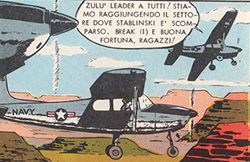 |
Some single-engine tricycle landing gear aircraft, more likely the military version of the Cessna 172 Skyhawk named T-41 Mescalero, are shown in the story ESCADRILLE ZZ. |
Another Cessna T-41 Mescalero in the the colour of the "new Flying Tigers" is used by Sonny Tuckson and Dave Stirling in the story LES TIGRES VOLANTS A LA RESCOUSSE.
In these representations Hubinnon made a mixture of similar airplane: Cessna 170 and 180 (for the tail and the shape behind the wings) and the landing gear of the Cessna 172 (T-41).
|
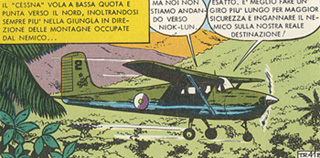 |
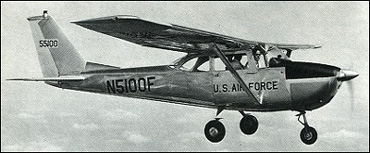 |
The T-41 Mescalero, a short-range, high-wing trainer aircraft, is the military version of the Cessna 172 Skyhawk. It is used primarily for pilot candidate screening. The T-41 trainer is equipped with avionics and other equipment consistent with military missions. A total of 855 T-41 aircraft were built. The Air Force began replacing the T-41 with a more advanced aircraft capable of aerobatics beginning in 1993.
|
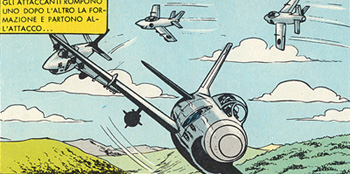 |
Some early variant of the FIAT G.91R are used by the Lady X mercenary pilots in the stories LE RETOUR DES TIGRES VOLANTS, LES TIGRES VOLANTS A LA RESCOUSSE and TIGRES VOLANTS CONTRE PIRATES.
|
The Fiat G.91, nicknamed Gina, was an Italian fighter aircraft that was intended to serve as standard equipment for NATO air forces in the 1960s. It was eventually only adopted by three - the Italian Air Force, West Germany's Luftwaffe, and the Portuguese Air Force. It was armed with 4× 12.7 mm (0.50 in) M2 Browning machine guns; or 2× 30 mm (1.18 in) DEFA cannons (Luftwaffe G.91R/3 only)
Hardpoints : 4× under-wing pylon stations holding up to maximum of 1,814 kg/4,000 lb of payload for G.91Y, 680 kg/1,500 lb for G.91R/3 & R/4 and 500 kg/1,100 lb for G.91R/1
|
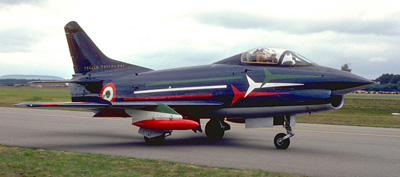 |
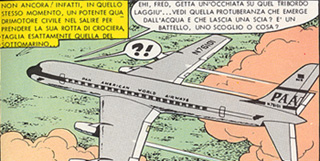 |
A Douglas DC-8 is shown in the story LES VOLEURS DE SATELLITE. |
The Douglas DC-8 is a four-engined jet airliner, manufactured from 1958 to 1972. Launched later than the competing Boeing 707, the DC-8 nevertheless established Douglas in a strong position in the airliner market, and remained in production until 1972 when much larger designs, including the DC-10, made the DC-8 obsolete. Relegated to second-line duties, details of the DC-8 design allowed it to hold slightly more cargo than the 707; hundreds of re-engined examples remain in freighter service to this day, while commercial 707 service had largely ended by 2000.
|
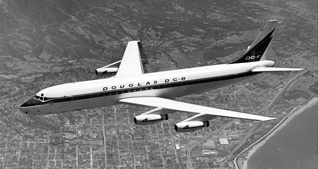 |
In the story X-15 Buck Danny and Jerry Tumbler are passengers in an Airline flight to Washington DC on board of a Boeing 707
|
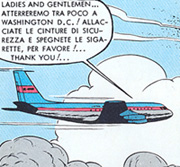 |
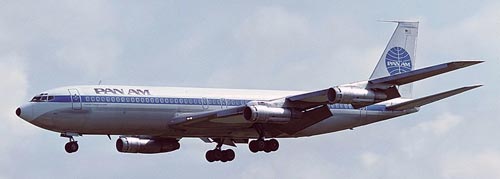 |
The Boeing 707 is a jet airliner. It was made by Boeing Commercial Airplanes from 1958 until 1979. It only has two rows of seats, which means it is a narrow-body plane. It also has four engines. The name is often said as "Seven Oh Seven". There are many different types of 707, and they can hold from 140 to 189 passengers. They can also fly from 2,500 to 5,750 nautical miles (4,630 to 10,650 km).
The Boeing 707 was Boeing's first jet airliner. It was the most common plane in the 1960s and it was still used a lot during the 1970s. The 707 was the first jet to have a lot of passengers fly on it. The 707 was not the first jet airliner, but it was the first one to make a lot of money. It made Boeing one of the biggest makers of airliners. It also started the group of planes with "7x7" names. The Boeing 727, Boeing 737 and Boeing 757 have some parts of the 707's design.
The 707's design came from the Boeing 367-80, which was a prototype jet. The very first 707, the 707-120, had Pratt & Whitney JT3C turbojet engines. Pan American World Airways started using the 707 on October 26, 1958. Other types of 707 are the 707-138 and the 707-320. Both of these started being used in 1959. A smaller version, the Boeing 720, was made in 1960. The 707-420 had Rolls-Royce Conway 508 turbofan engines. It was made in 1960.
|
|
Convair Astronautics Atlas LV-3B |
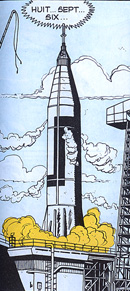 |
A Mercury Atlas rocket (Atlas LV-3B) is launched by Cape Canaveral in the story OPERATION MERCURY. In this adventure the Atlas LV-3B is the launch Vehicle for the Mercury III capsule of the Astronaut Dayton (finction name) for his first orbital flight. |
The Mercury Atlas rocket (officially designated the Atlas LV-3 B). It is an Atlas D missile modified for Project Mercury launches. It was a liquid-fuel rocket burning LOX and RP-1 in three engines configured in an unusual "stage-and-a-half" or "Parallel Staging" design: two of its three engines were jettisoned during ascent, but its fuel tanks and other structural elements were retained.
The Atlas D was the first operational Atlas ICBM. Its first launch attempt (a failure) was on April 14th of 1959, at Complex 13. The first Mercury Atlas launch (MA-1, an unmanned mission) took place on July 29th of 1960 from Complex 14. It also failed, exploding nearly a minute into the flight. A total of nine Mercury Atlases (including four manned) were flown, of which two unmanned failed. The final flight of the Mercury Atlas was MA-9 (Faith 7, flown by Gordon Cooper).
|
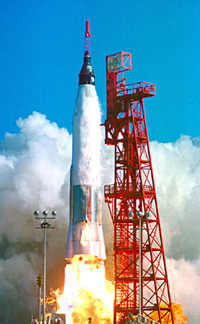 |
|
McDonnell Mercury capsule |
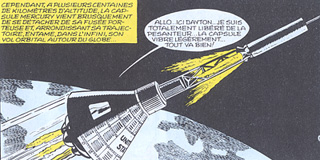 |
A Project Mercury capsule is well depicted in the adventures OPERATION MERCURY and LES VOLEURS DE SATELLITE. In these stories the Mercury III capsule of the Astronaut Dayton (fiction name), after an orbital mission, is stollen by an international criminal organisation. |
Project Mercury was the first human spaceflight program of the United States. It ran from 1959 through 1963 with the goal of putting a human in orbit around the Earth. The Mercury-Atlas 6 flight on 20 February 1962 was the first Mercury flight to achieve this goal. Early planning and research was carried out by the National Advisory Committee for Aeronautics, and the program was officially conducted by the newly created NASA. NASA ordered 20 production spacecraft, numbered 1 through 20, from McDonnell Aircraft Company. Five of the twenty spacecraft, #10, 12, 15, 17, and 19, were not flown. Spacecraft #3 and #4 were destroyed during unmanned test flights. Spacecraft #11 sank and was recovered from the bottom of the Atlantic Ocean after 38 years. Four non-human primates (Sam, Miss Sam, Ham, Enos) and six Astronauts (Shepard, Grissom, Glenn, Carpenter, Schirra, Cooper) flew on board of the Mercury capsule.
|
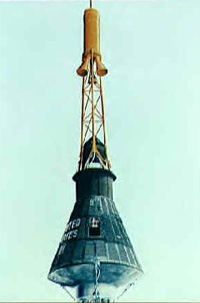 |
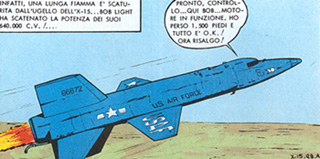 |
The Research rocket-powered aircraft North American X-15 tested during the 60s at Edwards AFB is well depicted in the story X-15 |
The North American X-15 rocket-powered aircraft was part of the X-series of experimental aircraft, initiated with the Bell X-1, that were made for the USAF, the NASA, and the USN. The X-15 set speed and altitude records in the early 1960s, reaching the edge of outer space and returning with valuable data used in aircraft and spacecraft design. It currently holds the world record for the fastest speed ever reached by a manned aircraft.
During the X-15 program, 13 of the flights (by eight pilots) met the USAF spaceflight criteria by exceeding the altitude of 50 miles (80.47 km. 264,000ft.), thus qualifying the pilots for astronaut status; some pilots also qualified for NASA astronaut wings.
Of all the X-15 missions, two flights (by the same pilot) qualified as space flights, per the international FAI definition of a spaceflight by exceeding a 100 kilometer.
|
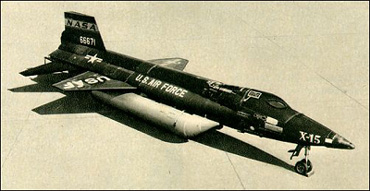 |
|
Lockheed F-104 Starfighter |
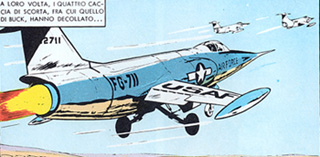 |
Some Lockheed F-104A based at Edwards AFB and used to escort the X-15 are shown in the story X-15. |
In the same story and before the flight on the Research rocket-powered aircraft X-15 Buck Danny and his comrades are trained in the early two seat version of the Starfighter the F-104B.
|
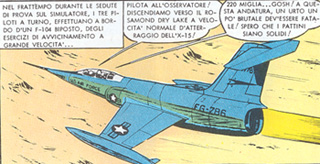 |
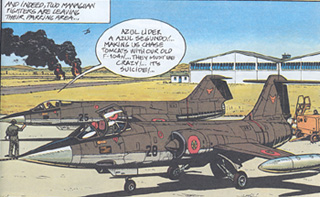 |
In the story OPERATION "APOCALYPSE" a couple of F-104G from the fantasy state of Managua are shown. |
The Managuan Air Force F-104G are also well depicted in the adventures ZONE INTERDITE and TONNERRE SUR LA CORDILLERE.
|
 |
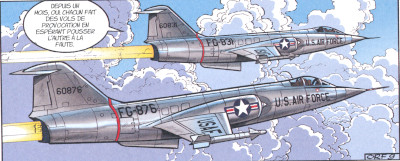 |
Some USAF F-104A are also depicted by Arroyo in the Buck Danny classic #5 OPERATION RIDEAU DE FER.
|
In the Buck Danny classic #6 ALERTE ROUGE.The Buck Danny b>F-104A has been modified with a special JATO rocket package in order to increase its velocity to intercet the Russian prototype Tsybin RSR flyied by Lady X
|
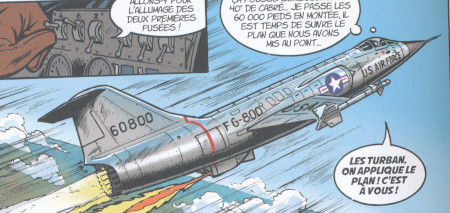 |
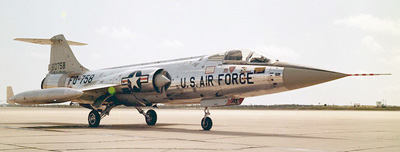 |
The Lockheed F-104 Starfighter was an American single-engined, high-performance, supersonic interceptor aircraft that served with the United States Air Force (USAF) from 1958 until 1967. The National Aeronautics and Space Administration (NASA) flew a small mixed fleet of F-104 types in supersonic flight tests and spaceflight programs until they were retired in 1994. Several two-seat trainer versions were produced, the most numerous being the TF-104G.
|
The F-104 featured a radical wing design. Most jet fighters of the period used a swept-wing or delta-wing planform. This allowed a reasonable balance between aerodynamic performance, lift, and internal space for fuel and equipment. Lockheed's tests, however, determined that the most efficient shape for high-speed, supersonic flight was a very small, straight, mid-mounted, trapezoidal wing.
|
 |
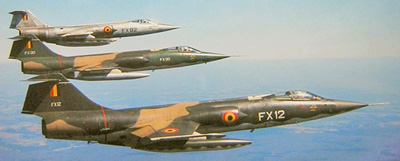 |
It was armed with Guns: 1× 20 mm (0.787 in) M61 Vulcan gatling gun, 725 rounds Hardpoints: 7 with a capacity of 4,000 lb (1,800 kg), with provisions to carry combinations of: Missiles: 4× AIM-9 Sidewinder Other: Bombs, rockets, or other stores. The Italian Air Force most advanced versions of the Starfighter the F-104S and F-104ASA were also armed with AIM-7 Sparrow missiles.
|
|
Boeing B-52 Stratofortress |
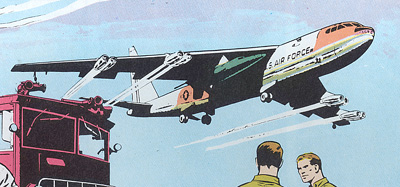 |
One of the two Boeing NB-52A which was the special version of the B-52 converted to carry the X-15 and, later, other experimental vehicles, is shown in the story X-15.
|
An USAF B-52G of the Startegic Air Command is well depicted in the story OPERATION "APOCALYPSE".
|
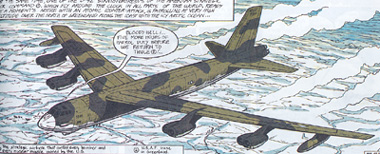 |
 |
Three USAF B-52H are also shown in one image of the story LES SECRET DE LA MER NOIRE.
|
The Boeing B-52 Stratofortress is a long-range, subsonic, jet-powered, strategic bomber operated by the United States Air Force (USAF) since 1955.
Beginning with the successful contract bid on 5 June 1946, the B-52 went through several design steps; from a straight wing aircraft powered by six turboprop engines to the final prototype YB-52, with eight turbojet engines. The USAF has had B-52s in active service since 1955, initially with the Strategic Air Command (SAC), with all aircraft later absorbed into the Air Combat Command (ACC) following SAC's disestablishment in 1992.
|
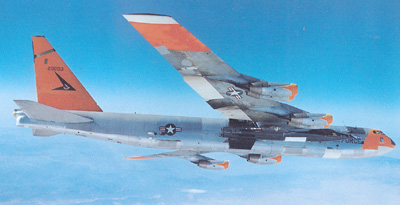 |
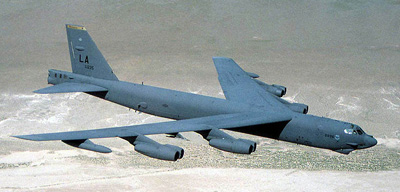 |
The USAF continues to rely on the B-52 because it remains an effective and economical heavy bomber, particularly in the type of missions that have been conducted since the end of the Cold War, mainly against nations that have limited air defense capabilities. The B-52's capacity to "loiter" for extended periods over (or even well outside) the battlefield, while delivering precision standoff and direct fire munitions, has been a valuable asset in conflicts such as Operation Enduring Freedom in Afghanistan. It is armed with Guns: 1× 20 mm M61 Vulcan cannon in a remote controlled tail turret now decommissioned and removed from all operational aircraft
Bombs: Approximately 70,000 pounds (31,500 kg) mixed ordnance - bombs, mines, missiles, in various configurations.
|
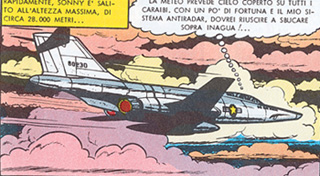 |
In the story ALERTE A CAP KENNEDY Sonny Tuckson is flying on a reconnaissance variant of the McDonnel F-101B Voodoo. In this case the aircraft is not well represented being its image a mix between the two seats RF-101B but with the typical nose design of the single seat RF-101A or RF-101C. |
A Canadian Air Force CF-101 is piloted by Dan Cooper during an Air Show in the story LE PILOTE AU MASQUE DE CUIR
|
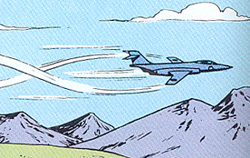 |
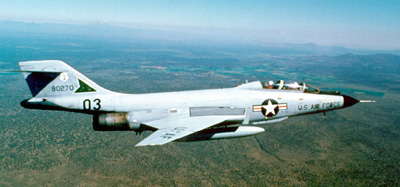 |
The McDonnell F-101 Voodoo was a supersonic military fighter flown by the USAF and the RCAF. Initially designed as a long-range bomber escort (known as a penetration fighter) for the Strategic Air Command (SAC), the Voodoo served in a variety of other roles, including that of an all-weather interceptor aircraft with the Air Defense Command / Aerospace Defense Command (ADC) and fighter bomber and photo reconnaissance roles with the Tactical Air Command (TAC).
|
Along with the Air Force U-2 and Navy RF-8 Crusaders, the RF-101 reconnaissance variant of the Voodoo was instrumental during the Cuban Missile Crisis and saw extensive service during the Vietnam War. It was armed with 4 × AIM-4 Falcon -or- 2 × AIM-4 Falcon and 2×AIR-2 Genie nuclear rockets.
|
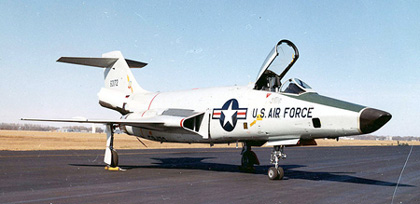 |
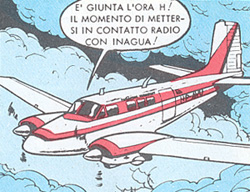 |
Buck Danny and his comrades are flying on a Beechcraft 65 Queen Air during their secret mission over the fantasy state of Inagua in the story ALERTE A CAP KENNEDY. |
The Beechcraft Queen Air is a twin engined light aircraft produced by Beechcraft in several different versions from 1960 to 1978. Based upon the Twin Bonanza, with which it shared key components such as wings, engines, and tail surfaces, but featuring a larger fuselage, it served as the basis for the highly successful King Air series of turboprop aircraft. It is often used as a private aircraft, a utility, or a small commuter airliner. Production ran for the best part of two decades.
|
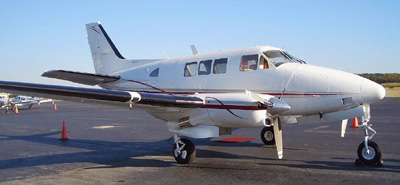 |
|
Yakovlev Yak-27K "Flashlight-C" |
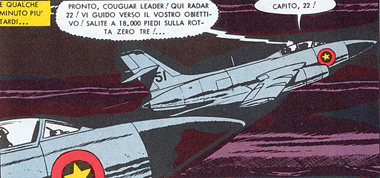 |
A couple of Inaguan Yakovlev Yak-27K "Flashlight-C" are shown in the story ALERTE A CAP KENNEDY.
In the reality this version of the Yak-27 did not enter service
|
The Yakovlev Yak-27 (NATO reporting name "Flashlight-C") was a family of Soviet supersonic aircraft developed in 1958 from the Yak-121 prototype. The most built variant was the tactical reconnaissance Yak-27R (NATO reporting name "Mangrove").
The Yak-27R entered service with the Soviet Air Force in 1960 and was intended to replace the subsonic Ilyushin Il-28 reconnaissance aircraft. However, despite the greater speed and ceiling, it had less range. The Yak-27R also had some operational limitations and was flown at supersonic speed only by the most experienced pilots. The low position of the engines made them prone to foreign object ingestion from unimproved forward-base runways. With the increasing coverage of anti-aircraft missiles over Europe, the high-altitude Yak-27R was often more limited than the Il-28. The Yak-27R was withdrawn from operational service in the early 1970s, and was replaced by the Yak-28R and the MiG-25R. The Yak-27K was the Interceptor version of Yak-27, armed with two K-8 missiles, but did not enter service.
|
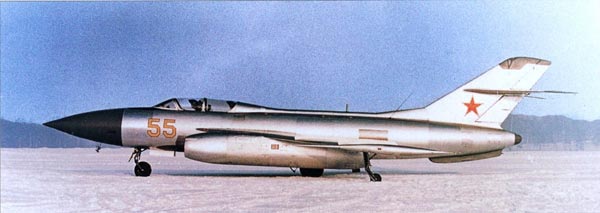 |
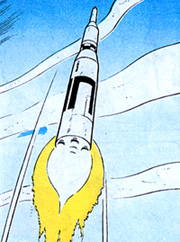 |
A rocket, which seems to be a Saturn I, is shown during a flight test at Kennedy Space Center in the story ALERTE A CAP KENNEDY. |
The Saturn family of rockets were developed by a team of mostly German rocket scientists led by Wernher von Braun to launch heavy payloads to Earth orbit and beyond. Originally proposed as a military satellite launcher, they were adopted as the launch vehicles for the Apollo program. The two most important members of the family were the Saturn IB and the Saturn V.
Ultimately, the members of the Saturn family that made it to the launch pad were:
Saturn I - ten rockets flown to evaluate the S-I and, in later flights, the S-IV stages.
Saturn IB - nine launches, a refined version of the Saturn I with a more powerful first stage (designated the S-IB) and using the Saturn V's S-IVB as a second stage.
These carried the first crewed Apollo flights into orbit, and later provided the boosters for the Skylab and Apollo-Soyuz flights.
Saturn V - 12 launches, the Moon rocket that carried Apollo astronauts to the Moon.
Saturn INT-21 - one launch, used to place the Skylab space station in orbit.
|
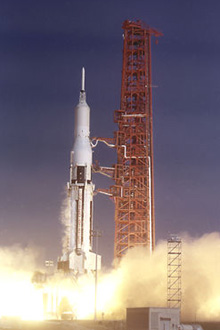 |
|
Martin Marietta Titan rocket |
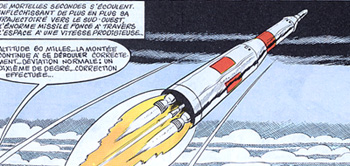 |
A rocket, which seems to be a Titan I, is also shown during a flight test at Kennedy Space Center in the story ALERTE A CAP KENNEDY. |
Titan was a family of U.S. expendable rockets used between 1959 and 2005. A total of 368 rockets of this family were launched.
The Titan I was the first version of the Titan family of rockets. It began as a backup ICBM project in case the Atlas was delayed. It was a two-stage rocket powered by RP-1 and Liquid Oxygen. It was operational from early 1962 to mid-1965. Most of the Titan rockets were the Titan II ICBM and their civilian derivatives for NASA. The Titan II used a hypergolic combination of nitrogen tetroxide and hydrazine for its oxidizer and fuel. The Titan III was a modified Titan II with optional solid rocket boosters. It was developed by the U.S. Air Force as a heavy-lift satellite launcher to be used mainly to launch U.S. military payloads such as DSP early-warning, intelligence (spy), and defense communications satellites.The Titan IV is a "stretched" Titan III with non-optional solid rocket boosters. It could be launched either with the Centaur upper stage, with the IUS (Inertial Upper Stage) or without any upper stage. It was almost exclusively used to launch U.S. Military payloads, though it was also used to launch NASA's Cassini probe to Saturn in 1997
|
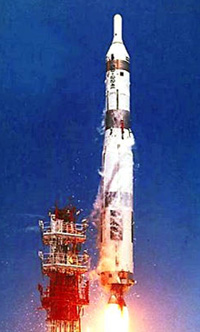 |
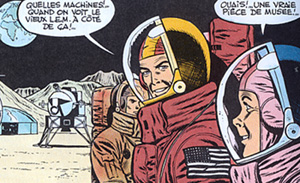 |
A Lunar Module, similar to the ones used for the Apollo project, is depicted in the humoristic story MISSION SPECIALE. This "imagined" story is published in the volume TOUT BUCK DANNY n. 7 |
The Apollo Lunar Module was the lander portion of the Apollo spacecraft built for the US Apollo program by Grumman to achieve the transit from cislunar orbit to the surface and back. The module was also known as the LM from the manufacturer designation.
The module was designed to carry a crew of two and rested on four landing legs. It consisted of two stages, the descent stage and the ascent stage. The total mass of the module was 15,264 kg, with the majority (10,334 kg) in the descent stage. Initially unpopular because the many delays in its development significantly stretched the projected timeline of the Apollo program, the LM eventually became the most reliable component of the Apollo/Saturn system, the only one never to suffer any failure that significantly impacted a mission, and in at least one instance (LM-7 Aquarius) greatly exceeded its design requirements.
.
|
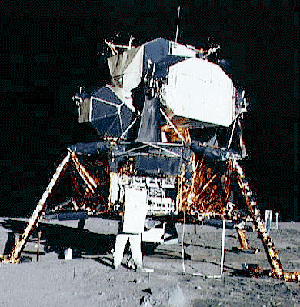 |
|
Lockheed A-12 Oxcart; YF-12 and SR-71 Blackbird |
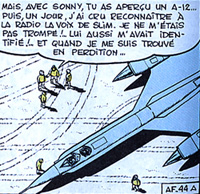 |
Some "secret" Manned Interceptor Lockheed YF-12 are well depicted in the story LE MYSTERE DES AVIONS FANTOMES |
The Strategic Reconnaissance jet aircraft SR-71 Blackbird are shown by Bergese and Le Bras in the two albums of the adventure LES OISEAUX NOIRS .
|
 |
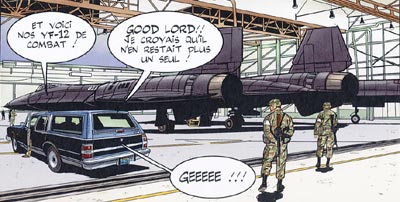 |
The Manned Interceptor Lockheed YF-12 is also shown by Le Bras in the second episode of the adventure LES OISEAUX NOIRS .
|
A modified spy jet aircraft A-12 Oxcart is also shown by Le Bras in the second episode of the adventure LES OISEAUX NOIRS .
|
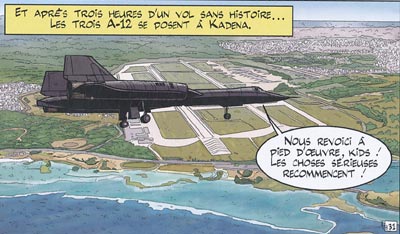 |
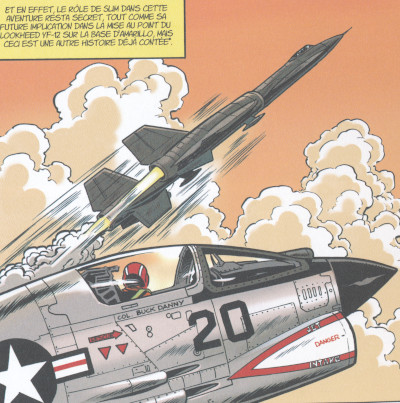 |
The Manned Interceptor Lockheed YF-12 is also shown by Arroyo in the classic adventure #6 ALERTE ROUGE .
|
The Lockheed A-12 was a reconnaissance aircraft built for the United States Central Intelligence Agency (CIA) by Lockheed's Skunk Works, based on the designs of Clarence "Kelly" Johnson. The aircraft was designated A-12, the 12th in a series of internal design efforts for "Archangel", the aircraft's internal code name. It competed in the CIA's "Oxcart" program against the Convair Kingfish proposal in 1959, and won for a variety of reasons.
CIA's representatives initially favored Convair's design for its smaller radar cross-section, but the A-12's specifications were slightly better and its projected cost was much less. The companies' respective track records proved decisive. Convair's work on the B-58 had been plagued with delays and cost overruns, whereas Lockheed had produced the U-2 on time and under budget. In addition, Lockheed had experience running a "black" project.[1]
The A-12 was produced from 1962 to 1964 and operated from 1963 to 1968. It was the precursor to the twin-seat U.S. Air Force YF-12 prototype interceptor, M-21 launcher for the D-21 drone, and the SR-71 Blackbird, a slightly longer variant able to carry a heavier fuel and camera load. The A-12's final mission was flown in May 1968, and the program and aircraft retired in June. The program was officially revealed in the mid-1990s.[2]
A CIA officer later wrote, "OXCART was selected from a random list of codenames to designate this R&D and all later work on the A-12. The aircraft itself came to be called that as well." The crews named the A-12 the Cygnus, suggested by pilot Jack Weeks to follow the Lockheed practice of naming aircraft after celestial bodies.
|
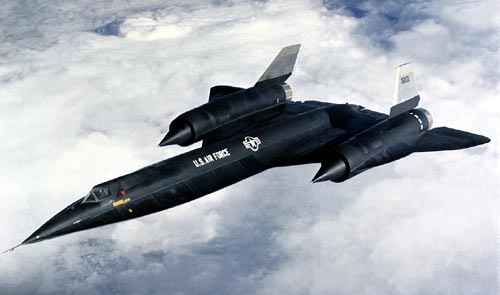 |
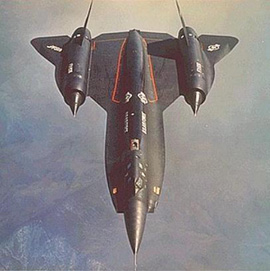 |
The Lockheed YF-12 was an American prototype interceptor aircraft, which the United States Air Force evaluated as a development of the highly-secret Lockheed A-12 that also spawned the now-famous SR-71 Blackbird. During flight tests the YF-12As set a speed record of 2,070.101 mph (3,331.505 km/h) and altitude record of 80,257.86 ft (24,462.6 m), both on 1 May 1965, and demonstrated promising results with their unique weapon system. Six successful firings of the AIM-47 missiles were completed. The last one launched from the YF-12 at Mach 3.2 at an altitude of 74,000 ft (22,677 m) to a JQB-47E target drone 500 ft (152 m) off the ground.
The program was abandoned following the cancellation of the production F-12B, but the YF-12s continued flying for many years with the USAF and with NASA as research aircraft.
. |
The Lockheed SR-71 was an advanced, long-range, Mach 3 strategic reconnaissance aircraft developed from the Lockheed A-12 and YF-12A aircraft by the Lockheed Skunk Works as a Black project. The SR-71 was unofficially named the Blackbird, and called the Habu by its crews, referring to an Okinawan species of pit viper. Clarence "Kelly" Johnson was responsible for many of the design's innovative concepts. A defensive feature of the aircraft was its high speed and operating altitude, whereby, if a surface-to-air missile launch were detected, standard evasive action was simply to accelerate. The SR-71 line was in service from 1964 to 1998, with 12 of the 32 aircraft being destroyed in accidents, though none were lost to enemy action.
|
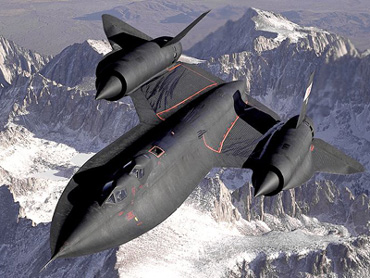 |
|
Lockheed U-2 / TR-1A Dragon Lady |
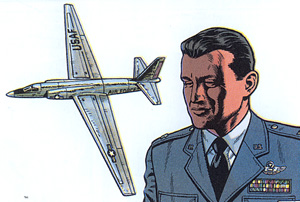 |
The Spy plane Lockheed U-2 of Francis Gary Powers is shown in the story LES OISEAUX NOIRS. This adventure has been partially published in the volume TOUT BUCK DANNY n. 14 and then completed in the special album for the 70th anniversary of the Buck Danny adventures. |
One of the most advanced version of this spy plane (U-2R or TR-1A) is also shown in the stories LES OISEAUX NOIRS and OPERATION CHECKMATE.
|
 |
The TR-1A variant with the satellite communication instrument radome is also well represented by Bergese in the same adventures LES OISEAUX NOIRS and OPERATION CHECKMATE.
|
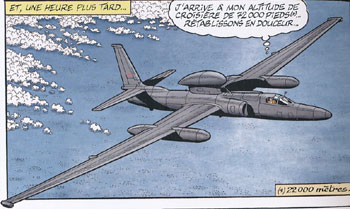 |
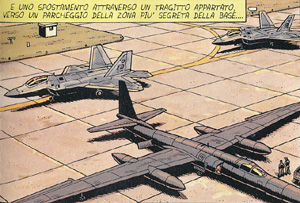 |
An U-2R or TR-1A from Kadena AFB is also well depicted in one frame of the story LA NUIT DU SERPENT
|
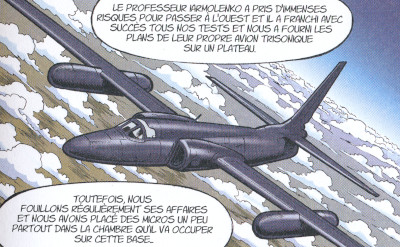 |
A TR-1A is also represented by Arroyo in the Buck Danny calssic #5 OPERATION RIDEAU DE FER. Because the adventures is placed during the 1961 this version of the U-2 is too much modern for that period.
|
The Lockheed U-2, nicknamed Dragon Lady, is a single-engine, very high-altitude aircraft flown by the United States Air Force and previously flown by the Central Intelligence Agency. It provides day and night, very high-altitude (70,000 feet/21,000 meters), all-weather surveillance. The aircraft is also used for electronic sensor research and development, satellite calibration, and satellite data validation.
| 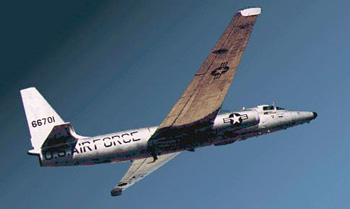 |
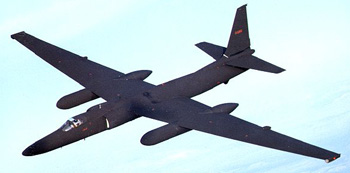 |
The U-2R, first flown in 1967, is significantly larger and more capable than the original aircraft. A tactical reconnaissance version, the TR-1A, first flew in August 1981. A distinguishing feature of these aircraft is the addition of a large instrumentation "superpod" under each wing. Designed for standoff tactical reconnaissance in Europe, the TR-1A was structurally identical to the U-2R. The 17th Reconnaissance Wing, Royal Air Force Station Alconbury, England used operational TR-1As from 1983 until 1991. The last U-2 and TR-1 aircraft were delivered to the Air Force in October 1989. In 1992 all TR-1s and U-2s (all U-2Rs) were designated U-2Rs. The two-seat trainer variant of the TR-1, the TR-1B, was redesignated as the TU-2R. After upgrading with the F-118-101 engine, the former U-2Rs were designated the U-2S Senior Year.
|
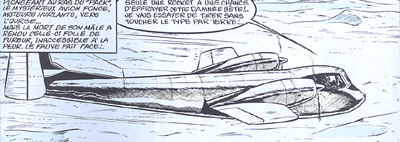 |
In the story LE MYSTERE DES AVIONS FANTOME a Grumman OV-1 Mohawk is well represented. |
The Grumman OV-1 Mohawk is an armed military observation and attack aircraft, designed for battlefield surveillance and light strike capabilities. It is of twin turboprop configuration, and carried two crewmembers with side by side seating. The Mohawk was intended to operate from short, unimproved runways in support of Army maneuver forces.
|
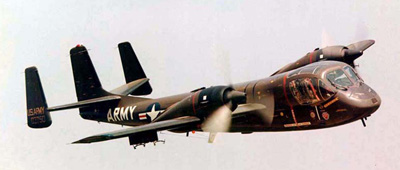 |
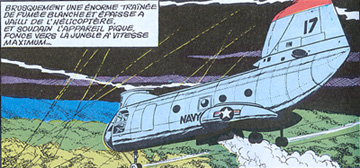 |
A Boeing CH-46 Sea Knight is shown during a night mission in the story ALERTE ATOMIQUE. |
A US Marines Boeing CH-46 Sea Knight is also well depicted in the story LE FEU DU CIEL. |
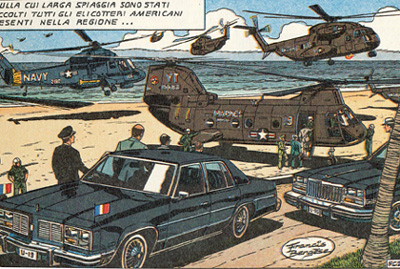 |
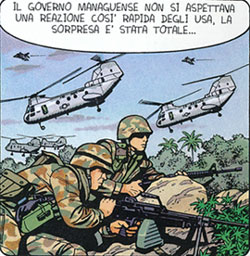 |
Some US Marines Boeing CH-46 Sea Knight are also shown in the story TONNERRE SUR LA CORDILLERE. |
The Boeing CH-46 Sea Knight is a medium-lift tandem rotor cargo helicopter, used by the US Navy and United States Marine Corps (USMC) to provide all-weather, day-or-night assault transport of combat troops, supplies and equipment. Assault Support is its primary function, and the movement of supplies and equipment is secondary. Additional tasks include combat support, search and rescue, support for forward refueling and rearming points, CASEVAC and Tactical Recovery of Aircraft and Personnel (TRAP).
|
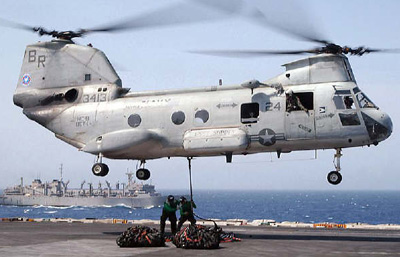 |
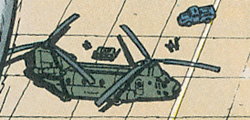 |
A Boeing CH-47 Chinook is shown on the airfield of the Area 51 in the story LES AGRESSEURS. |
Some Boeing CH-47 Chinook of the Managua Army are shown on in the story TONNERRE SUR LA CORDILLÈRE. |
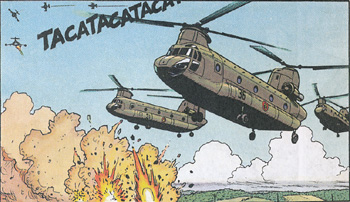 |
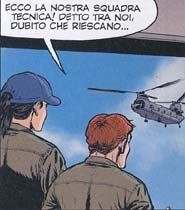 |
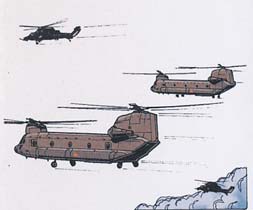 |
an US Army and two Spanish Army Boeing CH-47 Chinook are also shown in the story COBRA NOIR. |
The Boeing CH-47 Chinook is a twin-engine, tandem rotor heavy-lift helicopter. Its top speed of 170 knots (196 mph, 315 km/h) was faster than contemporary utility and attack helicopters of the 1960s. It is one of the few aircraft of that era, such as the C-130 and the UH-1 "Huey", that is still in production and front line service with over 1,179 built to date. Its primary roles include troop movement, artillery emplacement and battlefield resupply. It has a wide loading ramp at the rear of the fuselage and three external-cargo hooks.
The Chinook was designed and initially produced by Boeing Vertol in the early 1960s. The helicopter is now produced by Boeing Defense, Space & Security. Chinooks have been sold to 16 nations.
| 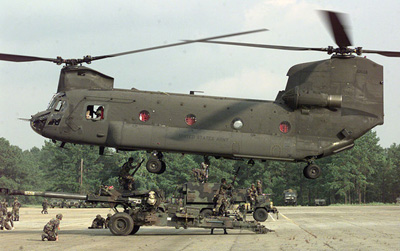 |
|
Lockheed C-130 / L-100 Hercules |
A lockheed MC-130E equipped with the Fulton recovery system "skyhook" is shown in the story ALERTE ATOMIQUE. |
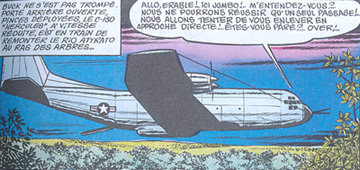 |
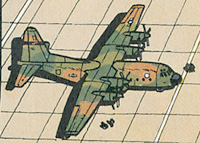 |
A lockheed C-130 on the airfield of the Area 51 is also shown in the story LES AGRESSEURS. |
A lockheed C-130H of the Greek Air Force is well depicted in the story L'ESCADRILLE FANTOME .
|
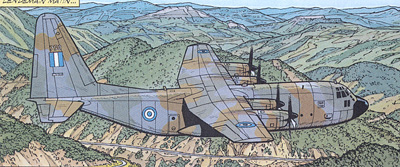 |
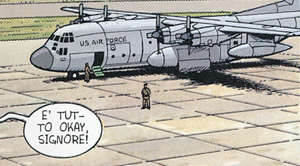 |
An USAF C-130 Hercules is also shown in the story LA NUIT DU SERPENT. |
The USAF parachutists demonstration Team are jumping from a C-130 Hercules during the Air Show in the story SABOTAGE AU TEXAS. |
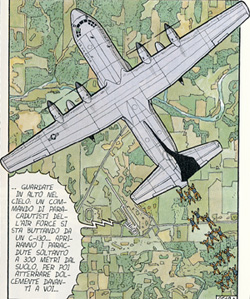 |
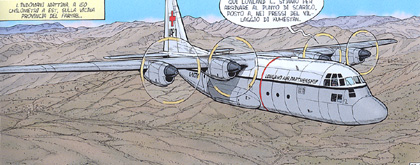 |
Buck Danny and his friends are flying some C-130 Hercules during their secret mission over the Afghanistan in the story PORTE DISPARU. |
A LC-130J is visible in the story VOSTOK NE REPOND PLUS and OPERATION VEKTOR. |
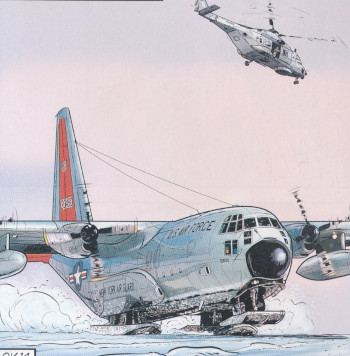 |
 |
A civilian L-100 belong to Lady X is well represented by Formosa in the story VOSTOK NE REPOND PLUS . |
Some decommissioned C-130 are visible in the story LE PACTE!. |
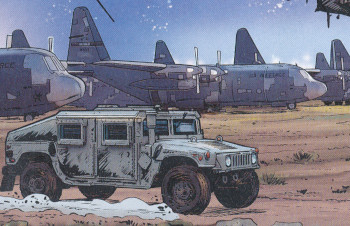 |
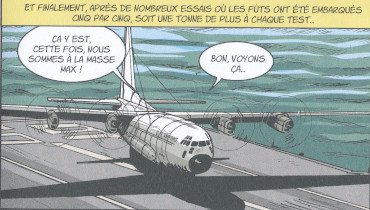 |
A C-130 landing and taking off from USS Forresta in 1958 is well represented by Le Bras in the Buck Danny classic#9 LE VOL DU RAPIER.
An Hercules C-130 actually perform landig and take off from the USS Forrestal but during the early 60s not in 1958. |
The same C-130 modified in order to look like a russian aircraft "Illyushin style" is used by Buck Danny and his friend for a secret mission inside the Russian territory in the story MOLOTOK-41 NE REPOND PLUS. |
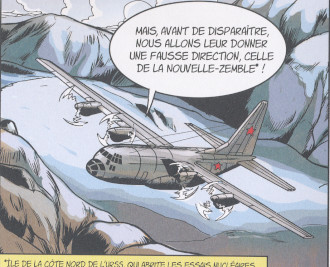 |
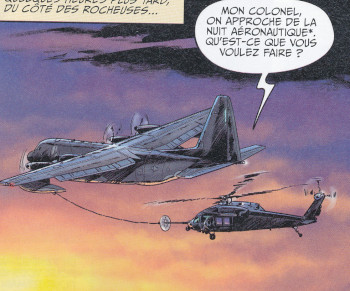 |
A C-130 is refeuling a Black Hawk in the adventure AIR FORCE ONE. |
The Lockheed C-130 Hercules is a four-engine turboprop military transport aircraft built by Lockheed. It is the main tactical airlifter for many military forces worldwide. Over 40 models and variants of the Hercules serve with more than 50 nations. In December 2006 the C-130 became the fifth aircraft—after the English Electric Canberra, B-52 Stratofortress, Tupolev Tu-95, and KC-135 Stratotanker—to mark 50 years of continuous use with its original primary customer, in this case, the United States Air Force. The C-130 is also the only military aircraft to remain in continuous production for 50 years with its original customer, as the updated C-130J Super Hercules.
| 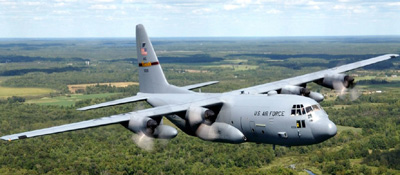 |
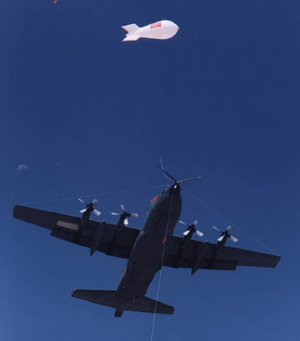 |
The Fulton surface-to-air recovery system (STARS) is a system used by the United States Air Force and United States Navy for retrieving persons on the ground from a MC-130E Combat Talon I aircraft. It involves using an overall-type harness and a self-inflating balloon which carries an attached lift line. An MC-130E engages the line with its V-shaped yoke and the individual is reeled on board. Red flags on the lift line guide the pilot during daylight recoveries; lights on the lift line are used for night recoveries. Recovery kits were designed for one and two-man recoveries.
This system was developed by inventor Robert Edison Fulton, Jr. for the Central Intelligence Agency in the early 1950s. It was an evolution from a similar system that was used during World War II by American and British forces.
|
The Lockheed L-100 Hercules is the civilian variant of the prolific C-130 Hercules military transport aircraft made by the Lockheed Corporation. Its first flight occurred in 1964. Longer L-100-20 and L-100-30 versions were developed. L-100 production ended in 1992 with 114 aircraft delivered. An updated variant of the model, LM-100J, has completed its first flight in Marietta, Georgia on May 25, 2017, and is set to start production in 2018-2019.
| 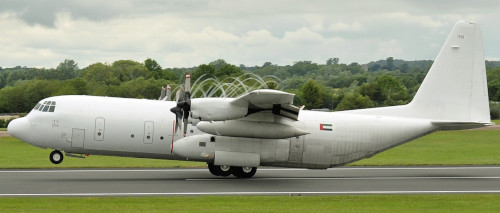 |
|
SNCASO S.O.4050 Vautour IIB |
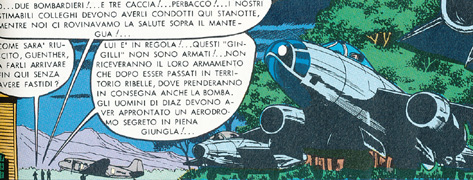 |
A french built bomber and attack aircraft Vautour IIB is depicted on a single frame in the story ALERTE ATOMIQUE. |
The Sud Aviation (SNCASO) S.O. 4050 Vautour II was a two jet engines powered French bomber, interceptor, and attack aircraft used by the Armée de l'Air (AdA). Later, 28 of these aircraft were used by the Israeli Heyl Ha'Avir (Air Force). Vautour is the French word for the vulture bird of prey.
It was armed with: 4x 30mm DEFA cannons with 100 rounds per gun
Internal weapons bay for maximum of 2,725 kg (6,000 lb) of bombs (typically six 450 kg (1,000 lb) bombs), pack of 116x 68 mm (2.7 in) rockets, camera pack, or two 1,500 liter (400 U.S. gal) fuel tanks
Four underwing pylons each rated at 1,500 kg (3,300 lb) (inboard) and 500 kg (1,100 lb) (outboard) for total external load of 4,000 kg (8,800 lb); maximum practical weapons load (internal and external) 4,400 kg (9,700 lb) of bombs, rockets, missiles, or napalm tanks |
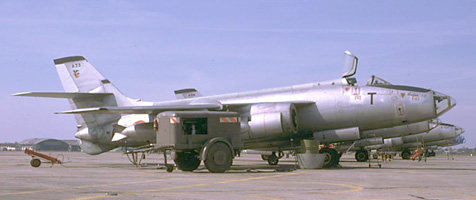 |
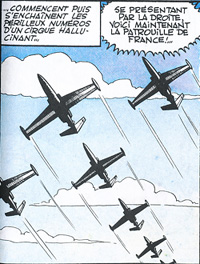 |
The Fougar Magister of the french aerobatic team are well depicted in the story LE PILOTE AU MASQUE DE CUIR. |
The Fouga Magister (company designation CM.170) is a French two-seat jet trainer. The related CM.175 Zéphyr was a carrier-capable version for the French Navy.
Although it is often lauded as the first purpose built two-seat turbojet-powered trainer aircraft, similar claims are made for the Fokker S.14 Machtrainer whose first flight, production, and service entry were all about year earlier. However, the Magister was much more successful than the Machtrainer, being produced in far greater numbers and being exported to many nations.
|
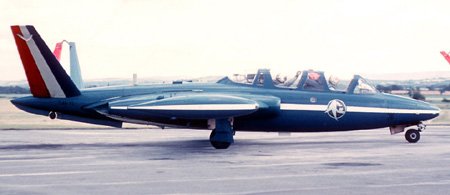 |
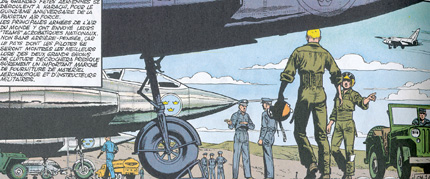 |
The Saab 35 Draken of the Swedish aerobatic team are shown in the story LE PILOTE AU MASQUE DE CUIR
|
A "pirate" group of Saab Draken flying by mercenary pilots are shown in the trilogy LA VALLÈE DE LA MORT VERTE, REQUINS EN MER DE CHINE and GHOST QUEEN. |
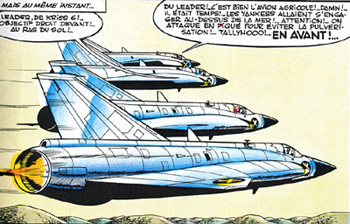 |
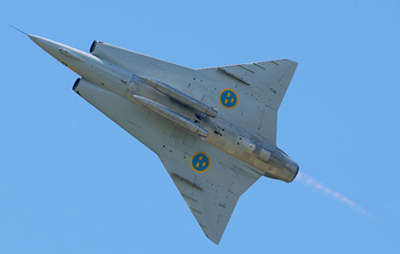 |
The Saab 35 Draken (Swedish: kite or dragon) is a fighter aircraft manufactured by Saab between 1955 and 1974. The Draken was built to replace the Saab J 29 Tunnan and, later, the fighter variant (J 32B) of the Saab 32 Lansen. The indigenous J 35 was an effective supersonic Cold War fighter that was also successful as an export product. |
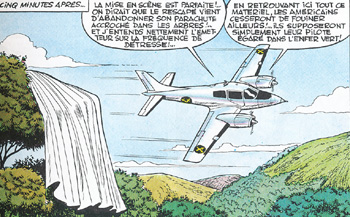 |
A possible two engines Cessna 310 flying by mercenary pilots is shown in the story LA VALLÈE DE LA MORT VERTE. |
The Cessna 310 was a common charter aircraft for the many air taxi firms that sprang up in the general aviation boom that followed World War II. The advantages to the Cessna 310 over its contemporaries, such as the Piper Aztec, were its speed, operating costs and after market modifications such as the Robertson STOL kits which made it popular world wide for its bush flying characteristics. It could access short fields while at the same time carrying a large useful load of 2,000 lb (910 kg). or more at high speeds for a twin engine piston aircraft. As of 2006, many Cessna 310s are in operation in air taxi service world wide.
|
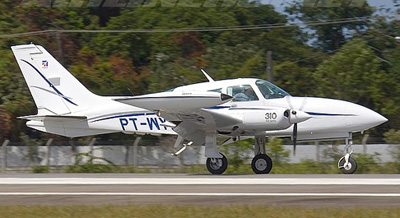 |
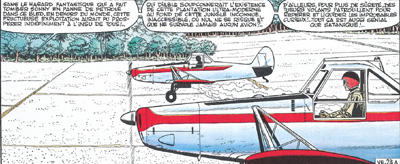 |
Some agricultural aircraft Piper PA-25 Pawnee flying by mercenary pilots are shown in the trilogy LA VALLÈE DE LA MORT VERTE, REQUINS EN MER DE CHINE and GHOST QUEEN. |
The PA-25 Pawnee was an agricultural aircraft produced by Piper Aircraft between 1959 and 1982. It remains a widely used aircraft in agricultural spraying and is also used as a tow plane, or tug, for launching gliders or for towing banners. On April 15, 1998, The New Piper Aircraft, Inc. officially sold the PA-25 series aircraft to Latino Americana de Aviación S.A in Argentina. The sale included all drawings, engineering data, parts inventory, tools, catalogs, and manuals. All support of any nature became the responsibility of the new owners
|
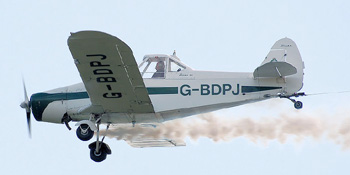 |
|
Lockheed YO-3A "Quite Star" |
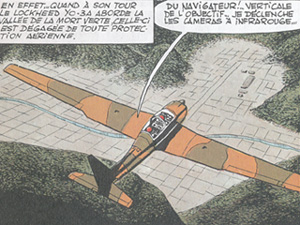 |
A single engine observation aircraft Lockheed YO-3A is shown in the story REQUINS EN MER DE CHINE. |
A NASA single engine observation aircraft Lockheed YO-3A is also shown on the airfield of the Area 51 in the story LES AGRESSEURS. |
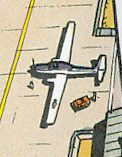 |
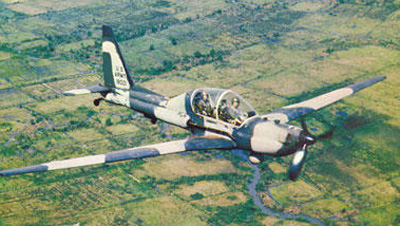 |
The Lockheed YO-3 "Quiet Star" was an American single-engined, propeller-driven monoplane that was developed for battlefield observation during the Vietnam war. It was designed to be as quiet as possible, and was intended to observe troop movements in near-silence during hours of darkness.The YO-3A was designed to a U.S. Army specification of 1968, which called for an observation aircraft that would be acoustically undetectable from the ground when flying at an altitude of 1,200 feet at night.
|
|
Ling-Temco-Vought A-7 Corsair II |
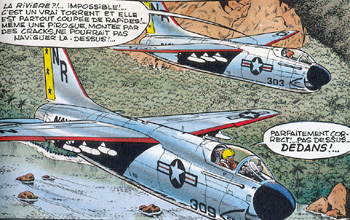 |
The Attack jet aircraft A-7 Corsair II are shown in the stories REQUINS EN MER DE CHINE and GHOST QUEEN. |
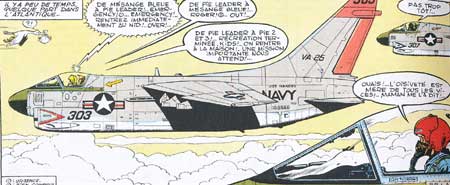 |
The Attack jet aircraft A-7 Corsair II are also shown in the surreal and funny story MISSION IMPOSSIBLE published as "inedit" in the colllection serie tout buck danny n. 11 |
The A-7 Corsair II of VA-72 on board of USS John Kennedy are well depicted by Bergese in the adventures LES PILOTES DE L'ENFER and LE FEU DU CIEL.
|
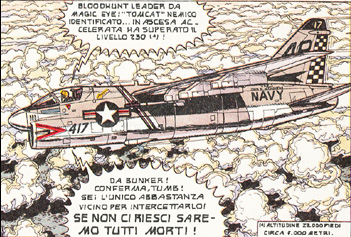 |
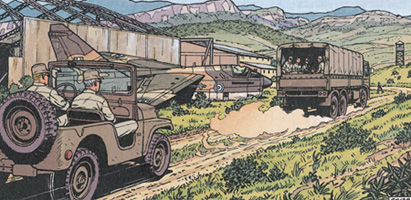 |
An old A-7H Corsair II of Greek Air Force is shown in the stories L'ESCADRILLE FANTOME. |
The Ling-Temco-Vought A-7 Corsair II is a carrier-based subsonic light attack aircraft introduced to replace the United States Navy's A-4 Skyhawk, initially entering service during the Vietnam War. The Corsair was later adopted by the United States Air Force, to include the Air National Guard, to replace the A-1 Skyraider, F-100 Super Sabre and F-105 Thunderchief. The aircraft was also exported to Greece in the 1970s, and Portugal and Thailand in the late 1980s. The A-7 airframe design was based on the successful supersonic F-8 Crusader produced by Chance Vought. It was one of the first combat aircraft to feature a head-up display (HUD), an inertial navigation system (INS), and a turbofan engine.
|
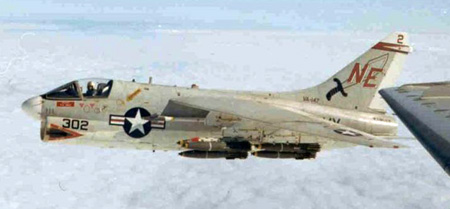 |
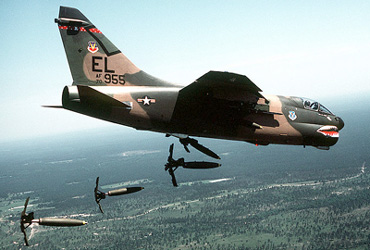 |
Its armament includes Guns: 1× 20 mm (0.787 in) M61 Vulcan gatling gun with 1,030 rounds Hardpoints: 6× under-wing plus 2× fuselage pylon stations (for mounting AIM-9 Sidewinder AAMs only) holding up to 15,000 lb (6,800 kg) of payload. Rockets: 4× LAU-10 rocket pods (each with 4× 127 mm Mk 32 Zuni rockets). Air-to-air missiles: 2× AIM-9 Sidewinder. Air-to-surface missiles: 2× AGM-45 Shrike Anti-radiation missile (ARM); or 2× AGM-62 Walleye TV-guided Glide bomb; or 2× AGM-65 Maverick; or
2× AGM-88 HARM; or 2× GBU-15 electro-optically guided Glide bomb.
Bombs: Up to 30× 500 lb (227 kg) Mark 82 bombs or any combination of the following;
Mark 80 series of unguided bombs (including 3 kg and 14 kg practice bombs)
Paveway series of laser-guided bombs Up to 4× B28 nuclear bomb/B57 nuclear bomb/B61 nuclear bombs. |
|
Sikorsky CH-53 Sea Stallion/CH-53E Super Stallion/MH-53 Pawe Low |
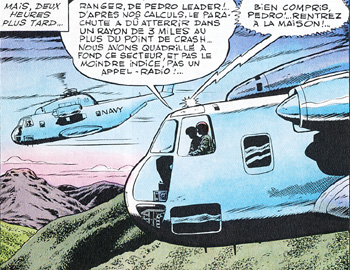 |
A couple of heavy-lift helicopters CH-53 Sea Stallion of US Navy are shown in the story REQUINS EN MER DE CHINE. |
Some CH-53 Sea Stallion of US Marines are well depicted by Bergese in the adventure LE FEU DU CIEL.
|
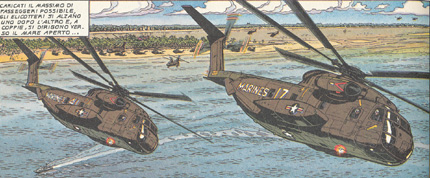 |
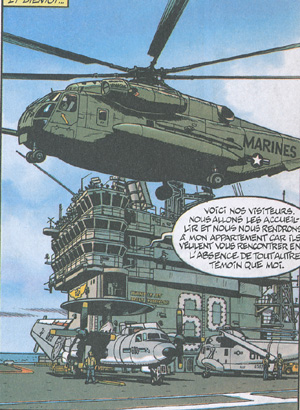 |
A heavy-lift helicopters CH-53E Super Stallion of US Marines is also depicted in the story ZONE INTERDITE and TONNERRE SUR LA CORDILLERE. |
Some Some MH-53 Pawe Low of the US Air Force Special Operations Command are shown by Bergese in the adventure LA NUIT DU SERPENT.
|
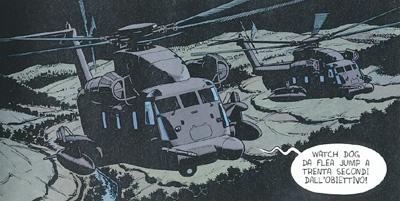 |
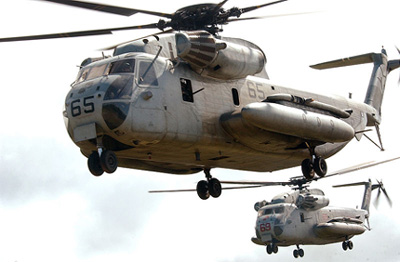 |
The CH-53 Sea Stallion is the most common name for the Sikorsky S-65 family of heavy-lift transport helicopters. Originally developed for use by the United States Marine Corps, it is also in service with Germany, Iran, Israel, and Mexico. The United States Air Force operated the HH-53 "Super Jolly Green Giant" during the late- and post-Vietnam War era, updating most of them as the MH-53 Pave Low.
|
The Sikorsky CH-53E Super Stallion is the largest and heaviest helicopter in the United States military. As the Sikorsky S-80 it was developed from the CH-53 Sea Stallion, mainly by adding a third engine, adding a seventh blade to the main rotor and canting the tail rotor 20 degrees. It was built by Sikorsky Aircraft for the United States Marine Corps. The less common MH-53E Sea Dragon fills the United States Navy's need for long range minesweeping or Airborne Mine Countermeasures (AMCM) missions, and perform heavy-lift duties for the Navy. Under development is the CH-53K King Stallion, which will be equipped with new engines, new composite material rotor blades, and a wider aircraft cabin.
|
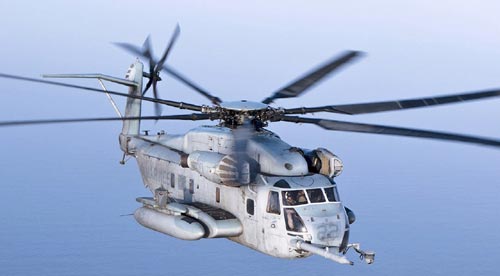 |
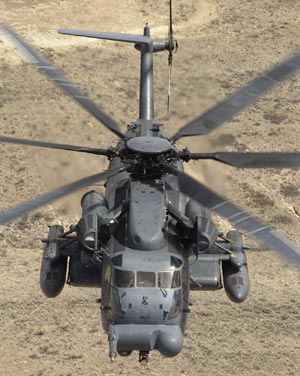 |
The Sikorsky MH-53 Pave Low series is a long-range combat search and rescue (CSAR) helicopter for the United States Air Force. The series was upgraded from the HH-53B/C, variants of the Sikorsky CH-53 Sea Stallion. The HH-53 "Super Jolly Green Giant" was initially developed to replace the HH-3E "Jolly Green Giant". The helicopters later transitioned to Special Operations missions. The U.S. Air Force's MH-53J/M fleet was retired in September 2008
|
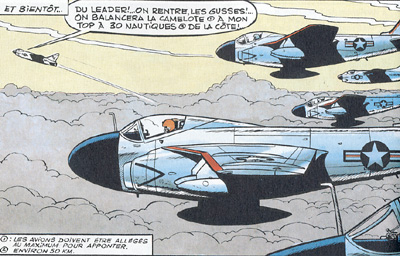 |
Some Grumman A-6 Intruder are shown in the story REQUINS EN MER DE CHINE. |
Some Grumman A-6 Intruder on the flight deck of the USS John Kenndy are shown by Bergese in the adventure LE FEU DU CIEL.
|
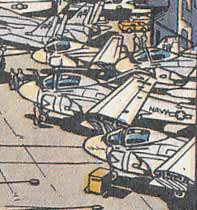 |
A group of Grumman A-6 Intruder are well depicted by Bergese in the adventure LES SECRETS DE LA MER NOIRE.
|
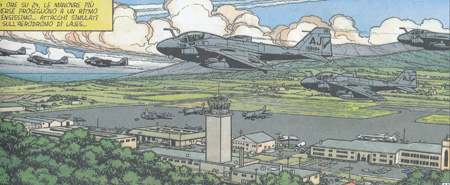 |
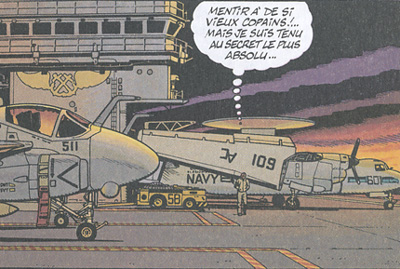 |
Another Grumman A-6 Intruder on the fligt deck of the USS Dwight D. Eisenhower is also depicted in the story L'ESCADRILLE FANTOME. |
A Grumman A-6 Intruder is also shown by Bergese in the adventure ZONE INTERDITE.
|
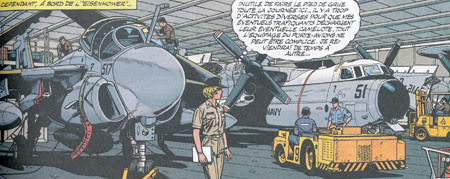 |
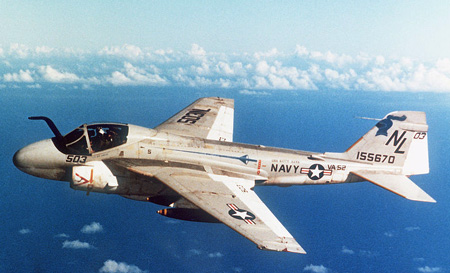 |
The Grumman A-6 Intruder was a twin jet-engine, mid-wing attack aircraft built in the United States by Grumman Aerospace. In service with the U.S. Navy and U.S. Marine Corps between 1963 and 1997, the Intruder was designed as an all-weather replacement for the piston-engined A-1 Skyraider medium attack aircraft. A specialized electronic warfare derivative, the EA-6B Prowler, remains in service as of 2010. As the A-6E was slated for retirement, its precision strike mission was taken over by the now retired F-14 Tomcat equipped with LANTIRN pod.
The A-6 was intended for replacement by the A-12 Avenger II, but that program was canceled due to cost overruns. The Intruder remained in service for a few more years before being retired in favor of the LANTIRN equipped F-14 Tomcat, which was in turn replaced by the F/A-18E/F Super Hornet. The last Intruders were retired on 28 February 1997. |
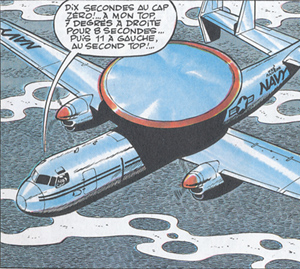 |
A Grumman E-2B Hawkeye is shown in the stories REQUINS EN MER DE CHINE and GHOST QUEEN. |
Some E-2C Hawkeye are well depicted by Bergese in the adventures LES PILOTES DE L'ENFER and LE FEU DU CIEL.
|
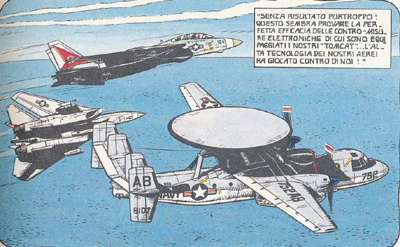 |
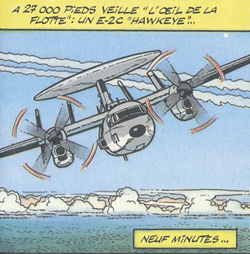 |
Another E-2C Hawkeye is also depicted in the story LES SECRETS DE LA MER NOIRE. |
A E-2C Hawkeye is also shown by Bergese in the adventure L'ESCADRILLE FANTOME.
|
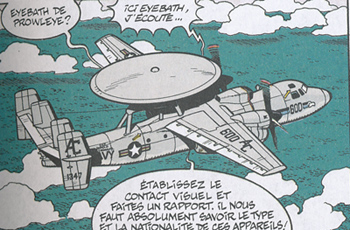 |
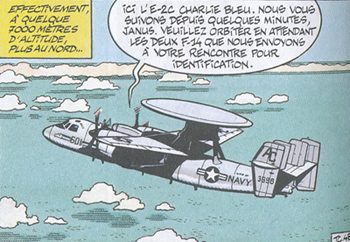 |
Some E-2C Hawkeye are also shown in the stories ZONE INTERDITE and TONNERRE SUR LA CORDILLERE. |
Both French and US Navy E-2C Hawkeye are well depicted by Bergese in the adventure MYSTERE EN ANTARCTIQUE.
|
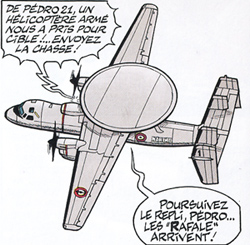 |
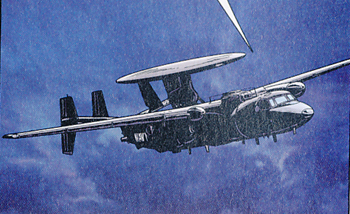 |
An E-2C Hawkeye is also well represented by Formosa in the story LA NUIT DU SPECTRE. |
An US Navy E-2C Hawkeye is well depicted by Philippe in the adventure TRAQUE EN HAUTE ALTITUDE.
|
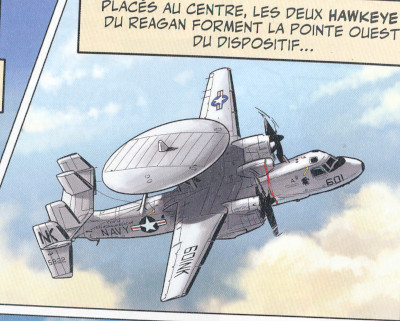 |
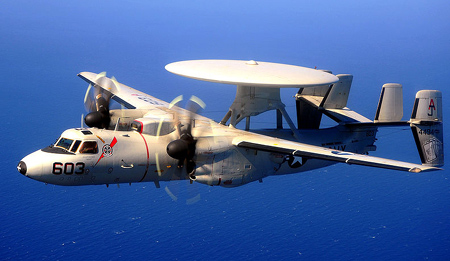 |
The Grumman E-2 Hawkeye is an American all-weather, aircraft carrier-capable tactical airborne early warning (AEW) aircraft. This twin-turboprop airplane was designed and developed during the late 1950s and early 1960s by the Grumman Aircraft Company for the United States Navy as a replacement for the earlier E-1 Tracer, which was rapidly becoming obsolete. E-2 performance has been upgraded with the E-2B, and E-2C versions, where most of the changes were made to the radar and radio communications due to advances in electronic integrated circuits and other electronics. The fourth version of the Hawkeye is the E-2D, which first flew in 2007.
The E-2 also received the nickname "Super Fudd" because it replaced the E-1 Tracer "Willy Fudd". In recent decades, the E-2 has been commonly referred to as the "Hummer" because of the distinctive sounds of its turboprop engines, quite unlike that of turbojet and turbofan jet engines. The E-2 and its sister, the C-2 Greyhound, are currently the only propeller airplanes that operate from aircraft carriers. In addition to U.S. Navy service, smaller numbers of E-2s have been sold to the armed forces of Egypt, France, Israel, Japan, Singapore and Taiwan.
|
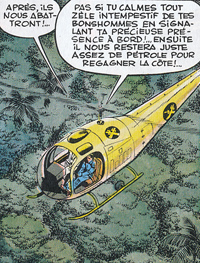 |
An helicopter Bell 47J Ranger is shown in the story REQUINS EN MER DE CHINE. |
The Bell 47J Ranger is a two-bladed, single engine, light helicopter manufactured by Bell Helicopter. It is based on the highly successful Bell 47.
Two UH-13Js were purchased from Bell Helicopter in March 1957. They were specially modified versions of the Bell 47J Ranger, purchased for use as the first presidential helicopters. On July 13, President Dwight D. Eisenhower became the first U.S. president to fly in a helicopter when he took off from the White House lawn in the first UH-13J.
On March 1, 1962, the two aircraft were reassigned to Bolling Air Force Base on the outskirts of Washington, D.C. where they were used for the next five years to transport high-ranking United States Department of Defense personnel and foreign dignitaries. They were retired in July 1967. |
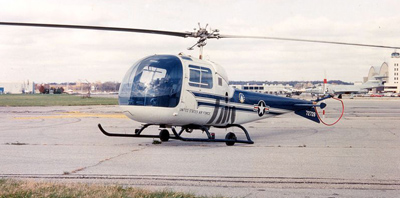 |
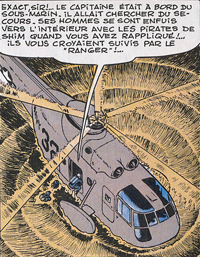 |
A Sikorsky SH-3 Sea King is shown in the story GHOST QUEEN. |
The Sikorsky SH-3 Sea King is also well depicted by Bergese in the adventures LES PILOTES DE L'ENFER and LE FEU DU CIEL.
|
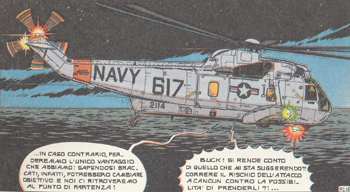 |
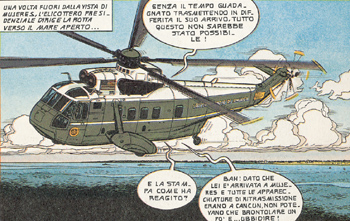 |
in the story LE FEU DU CIEL the Sikorsky VH-3D Sea King "Marine One" used by the President Ronald Reagan is also well depicted. |
A Sikorsky SH-3 Sea King is also shown by Bergese in the adventure LES SECRETS DE LA MER NOIRE.
|
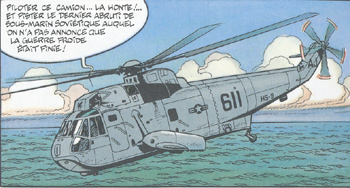 |
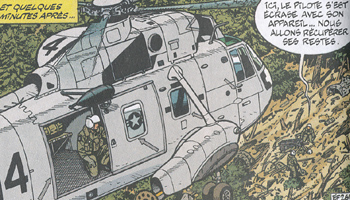 |
A Sikorsky SH-3 Sea King is also shown in the story L'ESCADRILLE FANTOME. |
The Sikorsky SH-3 Sea King is also present in few images of the adventure ZONE INTERDITE and TONNERRE SUR LA CORDILLERE.
|
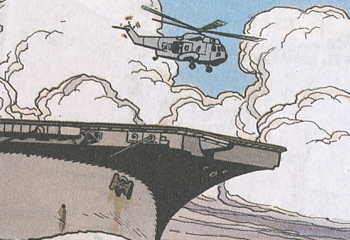 |
Another Sikorsky SH-3 Sea King is represented by Le Bras in the second episode of the the adventure LES OISEAUX NOIRS .
|
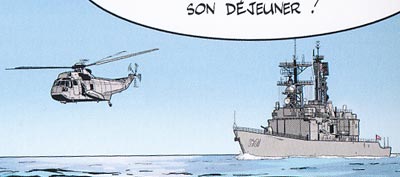 |
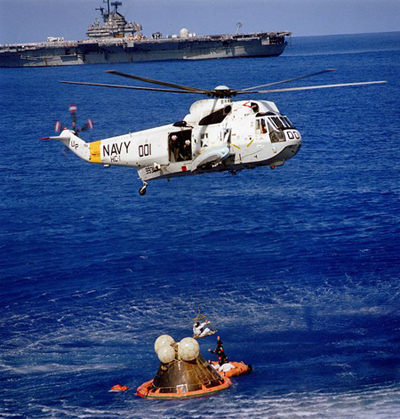 |
The Sikorsky SH-3 Sea King (company designation S-61) is a twin-engined anti-submarine warfare (ASW) helicopter. It served with the United States Navy and other forces, and continues to serve in many countries around the world. The Sea King has been built under license in Italy and Japan, and in the United Kingdom as the Westland Sea King. The major civil versions are the S-61L and S-61N.
The Sea King first flew on 11 March 1959; it became operational with the United States Navy in June 1961 as the HSS-2. The designation for the aircraft was changed with the introduction of the unified aircraft designation system in 1962 to the SH-3A. It was used primarily for anti-submarine warfare, but also served in anti-ship, search and rescue, transport, communications, executive transport and Airborne Early Warning roles. Aircraft carriers always deployed the Sea King as the first aircraft in the air and the last to land serving in air operations as plane guard and SAR for the fixed winged aircraft. An SH-3A, operating from the USS New Orleans amphibious assault ship, was used in the February 1971 Apollo 14 recovery mission.
In the US Navy, it was replaced in the ASW and SAR roles by the SH-60 Sea Hawk during the 1990s, but continues in service for other roles, for ASW in the reserves, and around the world. All H-3 aircraft in US Navy service are used in the logistics support, range support, Search and Rescue, test, and VIP transport roles. The H-3 was finally retired on 27 January 2006 in a Final Flight ceremony in NAS Norfolk, Virginia, by Helicopter Combat Support Squadron 2 (HC-2), the Fleet Angels. HH-3 variants based on the SH-3 airframe were built for the US Air Force.[1]
Sea Kings are used as one of the official helicopters of the President of the United States and are operated by the United States Marine Corps. Sea Kings use the call sign Marine One when the president is aboard.
|
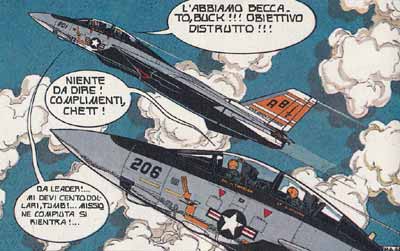 |
Buck Danny and his friends are flying the Grumman F-14A Tomcat on board of USS John Kennedy in the stories OPERATION APOCALYPSE, LES PILOTES DE L'ENFER and LE FEU DU CIEL. |
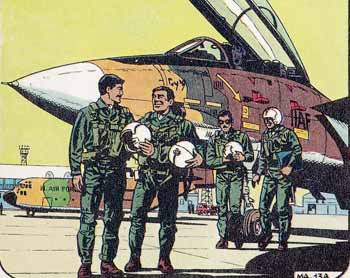 |
In the first of these adventures are also shown the F-14 Tomcat in the colour of the Iranian Air Force. |
Some F-14A Tomcat are also well depicted by Bergese in the adventure LES SECRETS DE LA MER NOIRE.
|
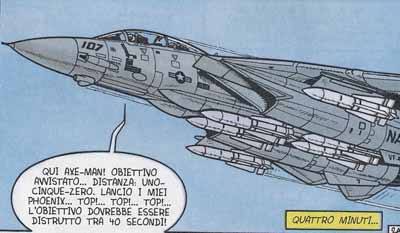 |
In the same story an former Iranian Air Force F-14A Tomcat used as "Agressor" by the Russian Navy is shown in the hangar of the Russian Aircraft Carrier. Kusnetzov
|
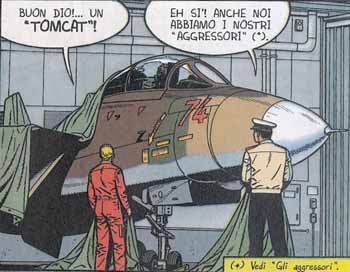 |
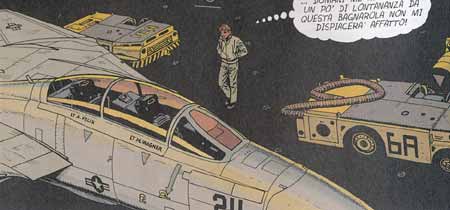 |
in the story L' ESCADRILLE FANTOME a Tomcat is represented on board of USS Eisenhower. |
A couple of F 14A Tomcat are also shown in the adventure TONNERRE SUR LA CORDILLERE.
|
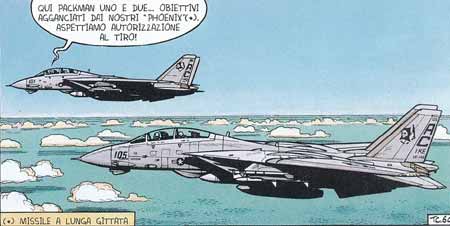 |
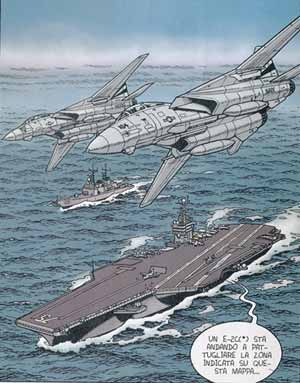 |
Two F-14 Tomcat are also shown in the story MYSTÈRE EN ANTARCTIQUE. |
The Grumman F-14 Tomcat is a supersonic, twin-engine, two-seat, variable-sweep wing fighter aircraft. The Tomcat was developed for the United States Navy's Naval Fighter Experimental (VFX) program following the collapse of the F-111B project. The F-14 was the first of the American teen-series fighters which were designed incorporating the experience of air combat against MiG fighters during the Vietnam War.
The F-14 first flew in December 1970 and made its first deployment in 1974 with the U.S. Navy aboard USS Enterprise (CVN-65), replacing the McDonnell Douglas F-4 Phantom II. The F-14 served as the U.S. Navy's primary maritime air superiority fighter, fleet defense interceptor and tactical reconnaissance platform. In the 1990s, it added the Low Altitude Navigation and Targeting Infrared for Night (LANTIRN) pod system and began performing precision ground-attack missions. The Tomcat was retired from the active U.S. Navy fleet on 22 September 2006, having been supplanted by the Boeing F/A-18E/F Super Hornet. As of 2012, the F-14 was only in service with the Islamic Republic of Iran Air Force, having been exported to Iran in 1976, when the U.S. had amicable diplomatic relations with the then government of Shah Mohammad Reza Pahlavi.
The F-14 was designed to combat highly maneuverable aircraft as well as the Soviet cruise missile and bomber threats. The Tomcat was to be a platform for the AIM-54 Phoenix, but unlike the canceled F-111B, it could also engage medium and short range threats with other weapons. The F-14 was an air superiority fighter, not just a long-range interceptor. Over 6,700 kg (15,000 lb) of stores could be carried for combat missions on several hardpoints under the fuselage and under the wings. Commonly, this meant a maximum of two–four Phoenixes or Sparrows on the belly stations, two Phoenixes/Sparrows on the wing hardpoints, and two Sidewinders on the wing hardpoints. The F-14 was also fitted with an internal 20 mm M61 Vulcan Gatling-type cannon.
Operationally, the capability to hold up to six Phoenix missiles was never used, although early testing was conducted; there was never a threat requirement to engage six hostile targets simultaneously and the load was too heavy to recover aboard an aircraft carrier. During the height of Cold War operations in the late 1970s and 1980s, the typical weapon loadout on carrier-deployed F-14s was usually only one AIM-54 Phoenix, augmented by two AIM-9 Sidewinders, two AIM-7 Sparrow IIIs, a full loadout of 20 mm ammunition and two drop tanks. The Phoenix missile was used twice in combat by the U.S. Navy, both over Iraq in 1999, but the missiles didn't score any kills.
|
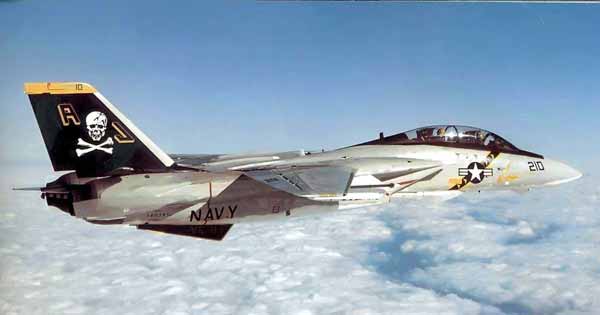 |
|
Aerospatiale-BAC Concorde |
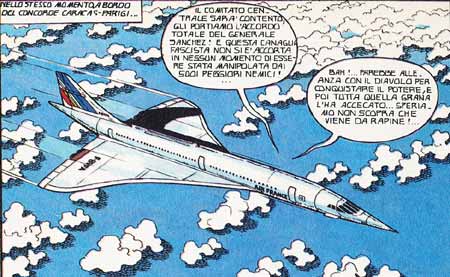 |
The Supersonic (Mach 2) passenger aircraft Concorde of the Air France is depicted in the story OPERATION APOCALYPSE. |
Aérospatiale-BAC Concorde is a retired turbojet-powered supersonic passenger airliner or supersonic transport (SST). It was a product of a Franco-British government treaty, combining the manufacturing efforts of Aérospatiale and the British Aircraft Corporation. First flown in 1969, Concorde entered service in 1976 and continued commercial flights for 27 years.
Among other destinations, Concorde flew regular transatlantic flights from London Heathrow (British Airways) and Paris-Charles de Gaulle Airport (Air France) to New York JFK and Washington Dulles, profitably flying these routes at record speeds, in less than half the time of other airliners.
With only 20 aircraft built, their development represented a substantial economic loss, in addition to which Air France and British Airways (BA) were subsidised by their governments to buy them. As a result of the type’s only crash on 25 July 2000 and other factors, its retirement flight was on 26 November 2003.
|
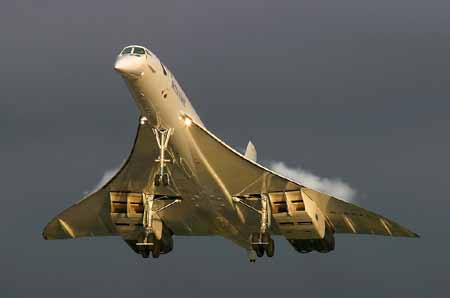 |
|
Bell UH-1 Iroquois "Huey" |
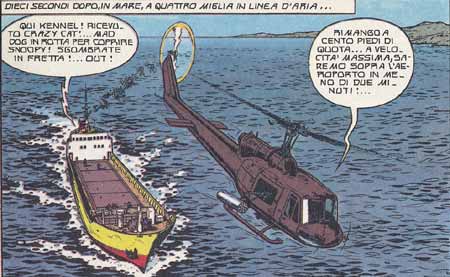 |
Lady X is flying an helicopter UH-1C Huey in the story OPERATION APOCALYPSE. |
An UH-1 Huey is also visible in the story LES SECRETS DE LA MER NOIRE
|
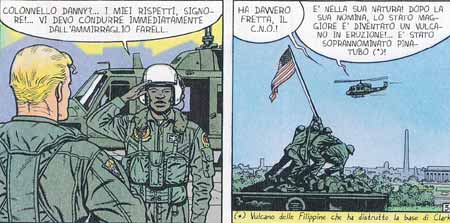 |
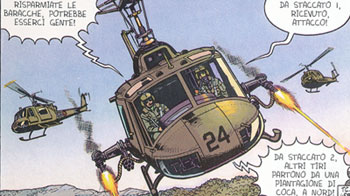 |
Several UH-1 Huey are also depicted in the story TONNERRE SUR LA CORDILLERE
|
The Bell UH-1 Iroquois is a military helicopter powered by a single, turboshaft engine, with a two-bladed main rotor and tail rotor. The helicopter was developed by Bell Helicopter to meet the United States Army's requirement for a medical evacuation and utility helicopter in 1952, and first flew on 20 October 1956. Ordered into production in March 1960, the UH-1 was the first turbine-powered helicopter to enter production for the United States military, and more than 16,000 have been produced worldwide.
The first combat operation of the UH-1 was in the service of the U.S. Army during the Vietnam War. The original designation of HU-1 led to the helicopter's nickname of Huey. In September 1962, the designation was changed to UH-1, but Huey remained in common use. Approximately 7,000 UH-1 helicopter saw service in Vietnam.
|
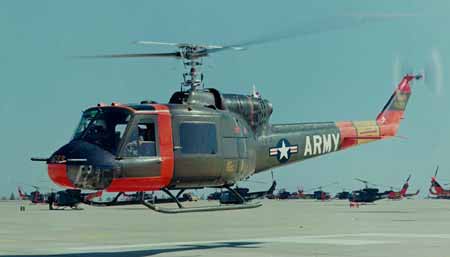 |
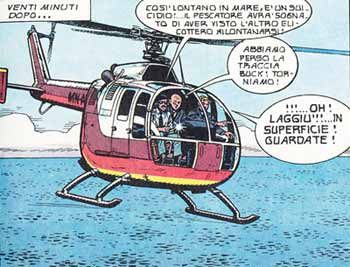 |
An helicopter MBB Bo-105 is well represented in the story OPERATION APOCALYPSE. |
The Messerschmitt-Bölkow-Blohm Bo 105 is a light, twin-engine, multi-purpose utility helicopter developed by Bölkow of Stuttgart, Germany. Production began under Messerschmitt-Bölkow-Blohm (MBB), which became a part of Eurocopter in 1991. Eurocopter continued to produce the Bo 105 until 2001, when it was replaced in the product line by the EC 135.
|
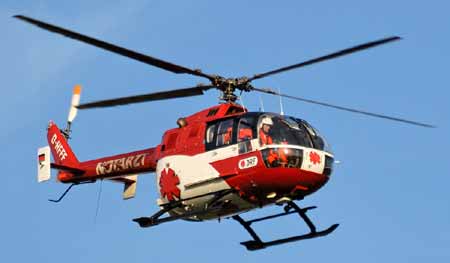 |
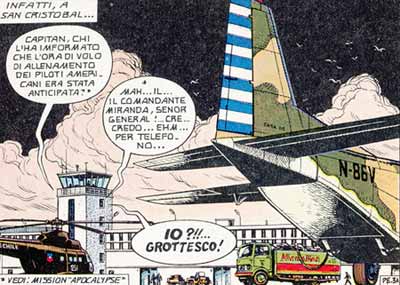 |
The tail of what seems to be a transport aircraft CASA C-212 is visible in the story LES PILOTES DE L'ENFER. |
The CASA C-212 Aviocar is a turboprop-powered STOL medium transport aircraft designed and built in Spain for civil and military use. C-212s are also produced under licence in Indonesia by Indonesian Aerospace, formerly called IPTN but now known as IAe. The design was initially marketed under the name of Aviocar, but EADS-CASA no longer uses that name in referring to the C-212.
A total of 478 C-212s of all variants had been delivered through the end of 2008 by EADS-CASA. EADS-CASA predicts that an additional 85 aircraft will be delivered in the 2007–2016 time period. EADS-CASA currently builds only the C-212-400, which received Spanish certification in 1998. The C-212-200 is currently built in Indonesia, and IAe is also reportedly preparing to begin assembly of -400 models
|
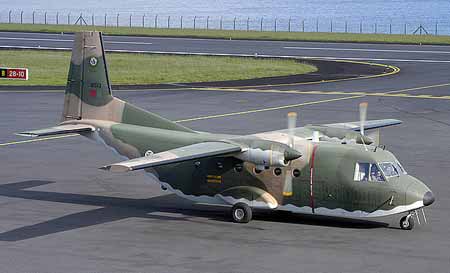 |
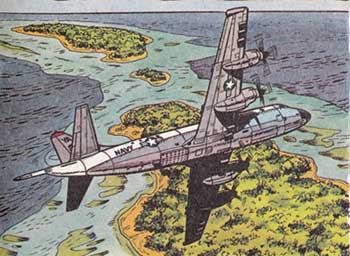 |
An anti-submarine and maritime surveillance aircraft P-3 Orion is visible in the story LE FEU DU CIEL. |
The AEW&C version of the P-3 named "Blue Sentinel" is represented in the story ZONE INTERDITE.
|
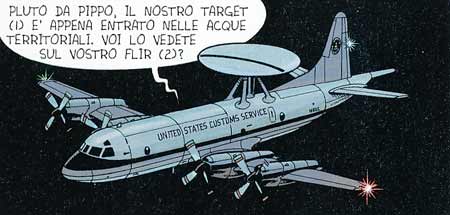 |
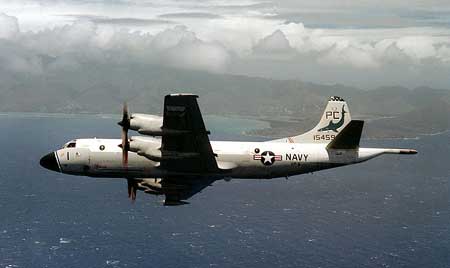 |
The Lockheed P-3 Orion is a four-engine turboprop anti-submarine and maritime surveillance aircraft developed for the United States Navy and introduced in the 1960s. Lockheed based it on the L-188 Electra commercial airliner. The aircraft is easily recognizable from the Electra by its distinctive tail stinger or "MAD Boom", used for the magnetic detection of submarines.
Over the years, the aircraft has seen numerous design advancements, most notably to its electronics packages. The P-3 Orion is still in use by numerous navies and air forces around the world, primarily for maritime patrol, reconnaissance, anti-surface warfare and anti-submarine warfare. A total of 734 P-3s have been built, and during 2012, it joined the handful of military aircraft including the Boeing B-52 Stratofortress and Boeing KC-135 Stratotanker that have served 50 years of continuous use by the United States military. The U.S. Navy's remaining P-3C aircraft will eventually be replaced by the P-8A Poseidon.
|
Originally nicknamed "Sentinel". Eight P-3B aircraft were converted into Airborne Early Warning and Control aircraft. In the early 90s, "Control" was dropped from the official designation along with the corresponding "C", renaming the model "P-3-AEW". This made it more easily differentiated from the E-3-AWACS operated by the U.S.Air Force. The P-3-AEWs are used by U.S. Customs and Border Protection's Office of Air and Marine for drug interdiction and homeland security missions. "P-3-LRT" (Long Range Tracker), previously known as "Slicks", also operated by CBP, are modified P-3 aircraft with an optical sensor turret in the nose and tracking radar which often work with the AEW ships. The mission using both types of aircraft in a single mission is called "Double Eagle".
|
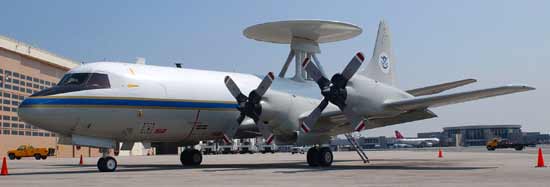 |
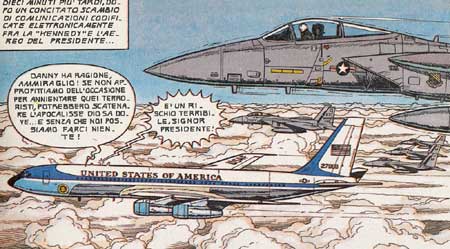 |
The C-137 VIP transport aircraft of the President Ronald Reagan is shown in the story LE FEU DU CIEL. |
A C-137 VIP transport aircraft is also well depicted in the story LES OISEAUX NOIRS . |
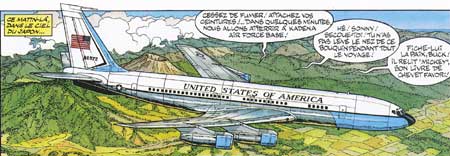 |
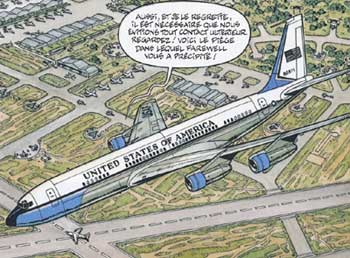 |
Another C-137 VIP transport aircraft is shown in the story LES SECRETS DE LA MER NOIRE. |
The Boeing C-137 Stratoliner was a VIP transport aircraft derived from the Boeing 707 jet airliner used by the United States Air Force. Other nations also bought both new and used 707s for military service, primarily as VIP or tanker transports. In addition, the 707 served as the basis for several specialized versions, such as the E-3 Sentry AWACS aircraft. The designation C-18 covers several later variants based on the 707-320B/C series.
|
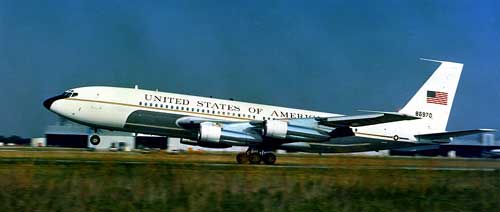 |
|
McDonnell Douglas F-15 Eagle |
 |
Some F-15 Eagle escorting the Ronal Reagan's VIP transport aircraft are shown in the story LE FEU DU CIEL. |
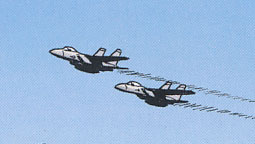 |
Two F-15 are barelly visible in a frame of the story LES OISEAUX NOIRS |
An F-15 Eagle is also show by Bergese in the story LA NUIT DU SERPENT. |
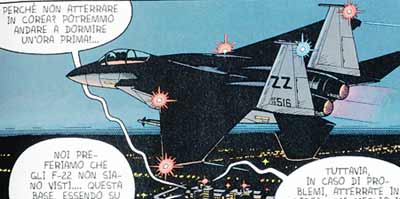 |
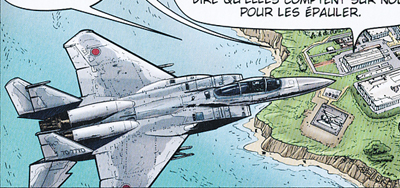 |
An F-15 Eagle of the Japanese Air Force is well depicted by Formosa in the story LA NUIT DU SPECTRE. |
The McDonnell Douglas (now Boeing) F-15 Eagle is a twin-engine, all-weather tactical fighter designed by McDonnell Douglas to gain and maintain air superiority in aerial combat. It is among the most successful modern fighters, with over 100 aerial combat victories with no losses in dogfights. Following reviews of proposals, the United States Air Force selected McDonnell Douglas' design in 1967 to meet the service's need for a dedicated air superiority fighter. The Eagle first flew in July 1972, and entered service in 1976.
Since the 1970s, the Eagle has been exported to Israel, Japan, Saudi Arabia, and other nations. The F-15 was originally envisioned as a pure air superiority aircraft. Its design included a secondary ground-attack capability that was largely unused. The design proved flexible enough that an all-weather strike derivative, the F-15E Strike Eagle, was later developed, and entered service in 1989. The F-15 Eagle is expected to be in service with the U.S. Air Force past 2025. F-15 versions are still being produced for foreign users, with the F-15 production line set to end in 2019, 47 years after the type's first flight.
|
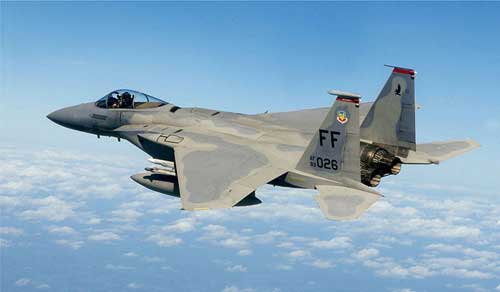 |
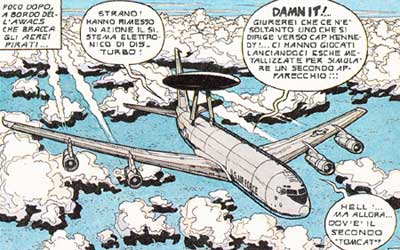 |
A Boeing E-3 Sentry,AWACS, is well depicted in the story LE FEU DU CIEL . |
Another Boeing E-3 Sentry,AWACS, is shown in the story LES AGRESSEURS. |
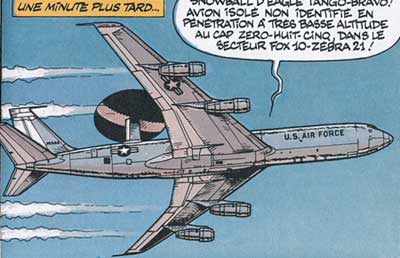 |
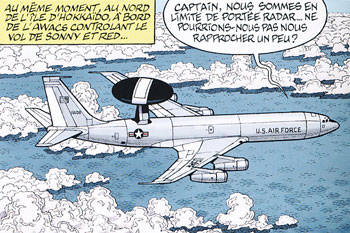 |
A Boeing E-3 Sentry AWACS is also well represented by Bergese the story LES OISEAUX NOIRS. |
A Boeing E-3 Sentry,AWACS, is shown in the story L'ESCADRILLE FANTOME. |
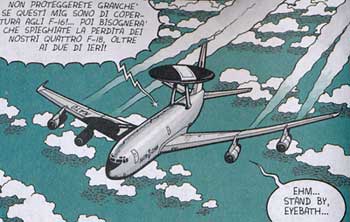 |
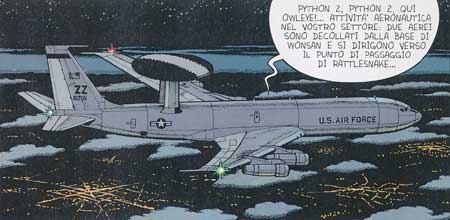 |
A Boeing E-3 Sentry AWACS is also shown in the story LA NUIT DU SERPENT. |
A Boeing E-3 Sentry,AWACS, is also shown in the story LE PACTE!. |
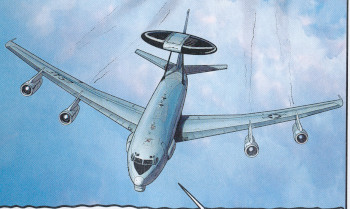 |
A Boeing E-3 Sentry,AWACS, is also shown in the story TRAQUE EN HAUTE ALTITUDE. |
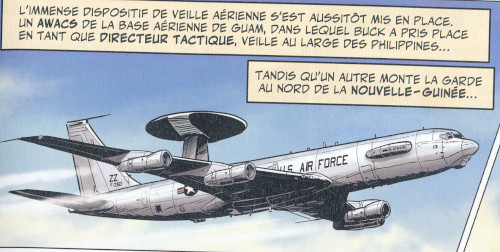 |
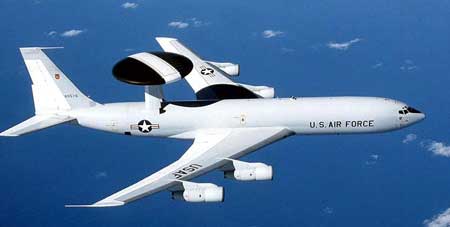 |
The Boeing E-3 Sentry, commonly known as AWACS, is an airborne early warning and control (AEW&C) aircraft developed by Boeing as the prime contractor. Derived from the Boeing 707, it provides all-weather surveillance, command, control and communications, and is used by the United States Air Force (USAF), NATO, Royal Air Force (RAF), French Air Force and Royal Saudi Air Force. The E-3 is distinguished by the distinctive rotating radar dome above the fuselage. Production ended in 1992 after 68 aircraft had been built.
The first USAF E-3 was delivered in March 1977, and during the next seven years, a total of 34 aircraft were manufactured. NATO, as a single identity, also had eighteen aircraft manufactured, basing them in Germany. The E-3 was also sold to the United Kingdom (seven) and France (four) and Saudi Arabia (five, plus eight E-3 derived tanker aircraft). In 1991, by which time the last aircraft had been delivered, E-3s participated in Operation Desert Storm, playing a crucial role of directing Coalition aircraft against the enemy. Throughout the aircraft's service life, numerous upgrades were performed to enhance its capabilities. In 1996, Westinghouse Electric was acquired by Northrop before being renamed Northrop Grumman Electronic Systems, which currently supports the E-3's radar.
|
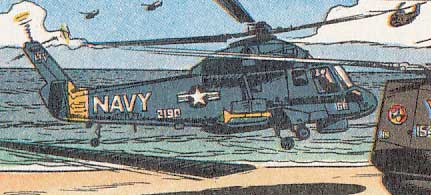 |
A US Navy ship-based helicopter Kaman SH-2 Seasprite is shown in the story LE FEU DU CIEL. |
A US Navy ship-based helicopter Kaman SH-2 Seasprite is also shown by Bergese in the story LES OISEAUX NOIRS. |
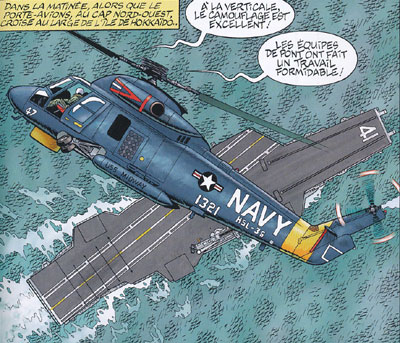 |
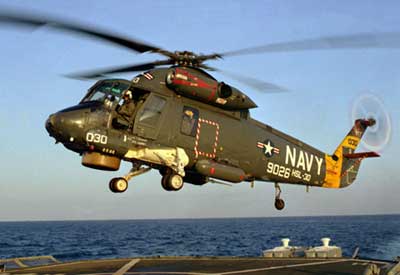 |
The Kaman SH-2 Seasprite is a ship-based helicopter, originally developed in the late 1950s as a fast utility helicopter for the United States Navy. In the 1970s, anti-submarine, anti-surface threat capabilities were added to the design, including over-the-horizon targeting, resulting in modifying most existing UH-2 models to the SH-2 Seasprite.
This aircraft extends and increases shipboard sensor and weapon capabilities against several types of enemy threats, including submarines of all types, surface ships and patrol craft that may be armed with anti-ship missiles. It served with the U.S. Navy from the 1960s until the last SH-2G helicopters were retired in 2001.
|
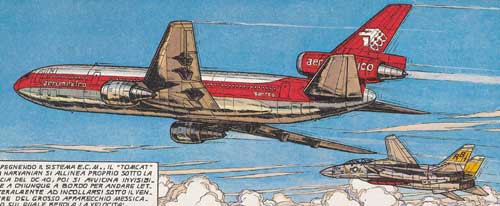 |
A civilian aircraft DC-10 of the AEROMEXICO is shown in the story LE FEU DU CIEL. |
The McDonnell Douglas DC-10 is a three-engine wide-body jet airliner manufactured by McDonnell Douglas. The DC-10 has range for medium- to long-haul flights, capable of carrying a maximum of 380 passengers. Its most distinguishing feature is the two turbofan engines mounted on underwing pylons and a third engine at the base of the vertical stabilizer. The model was a successor to McDonnell Douglas's DC-8 for long-range operations, and competed in the same markets as the Lockheed L-1011 TriStar, which has a similar layout to the DC-10.
Production of the DC-10 ended in 1989 with 386 delivered to airlines and 60 to the U.S. Air Force as air-to-air refueling tankers, designated the KC-10 Extender. The largest operator of the DC-10 is U.S. cargo airline FedEx Express. The DC-10 was succeeded by the related McDonnell Douglas MD-11. Boeing, which merged with McDonnell Douglas in the 1990s, conducted an upgrade program for DC-10s, equipping several with a glass cockpit, leading to their re-designation as MD-10s.
|
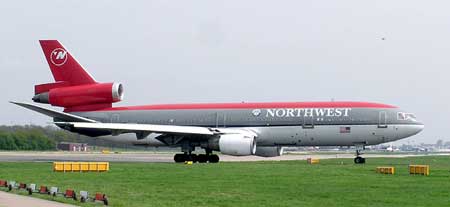 |
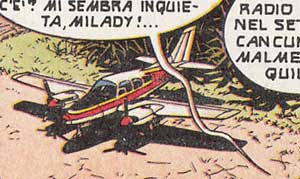 |
A civilian aircraft Beechcraft 55 Baron of Lady X is shown in the story LE FEU DU CIEL. |
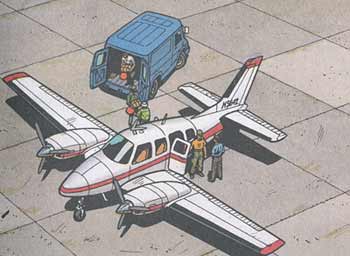 |
Another civilian aircraft Beechcraft 55 Baron also belong to Lady X is show by Bergese in the story ZONE INTERDITE. |
The Beechcraft Baron is a light, twin-engined piston aircraft developed by Beechcraft. The Baron is a variant of the Travel Air, and was introduced in 1961.
The early Baron 55, A55 and B55 were fitted with 260 hp (194 kW) Continental IO-470 engines and had gross weights of 4880 to 5100 lb (2,200 to 2,300 kg). These had a typical cruise speed of 190 knots (350 km/h) at 7000 ft (2100 m), and came with 116 or 136 US gallon (440 or 515 L) fuel tanks.
The C55, D55 and E55 models had an increased cruise speed of 200 knots (370 km/h) due to the 285 hp (213 kW) Continental IO520s. The gross weights of these later models increased to 5300 lb (2400 kg). They were about a foot (0.3 m) longer than the B55 Barons, and came with 136, 142, or 166 US gallon (515 or 628 L) fuel tanks.
Model 55 Barons were produced from 1961 to 1983, and some 3155 were produced.
|
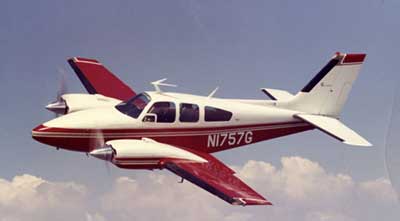 |
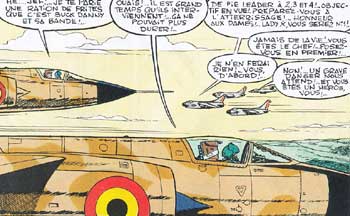 |
Two Dassault Mirage F1 seem represented in the funny and surreal story MISSION IMPOSSIBLE published as "inedit" in the colllection serie tout buck danny n. 11 . |
A Dassault Mirage F1 of the private company Black Jet is shown by Formosa in the story AIR FORCE ONE .
|
 |
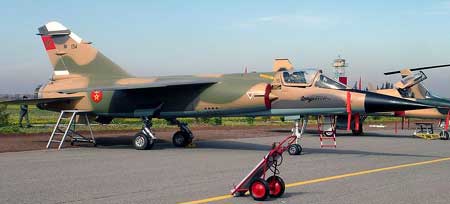 |
The Dassault Mirage F1 is a French air-superiority fighter and attack aircraft designed and built by Dassault Aviation as a successor of the Mirage III family. The Mirage F1 entered service in the French Air Force (Armée de l'Air) in the 1974. Powered by a single SNECMA Atar turbojet providing about 7 tonnes-force (69 kN; 15,000 lbf) of thrust, the F1 has been used as a light multipurpose fighter and has been exported to about a dozen nations. More than 720 F1s have been produced.
|
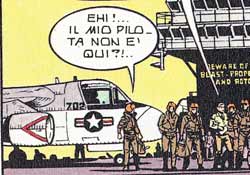 |
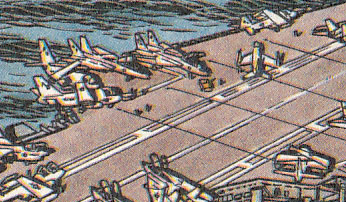 |
Some S-3 Viking are visible on the flight deck of the USS John Kennedy in the stories MISSION APOCALYPSE and LE FEU DU CIEL. |
Two S-3A Viking from the USS John Kennedy are well represented in the story LES AGGRESSEURS
|
 |
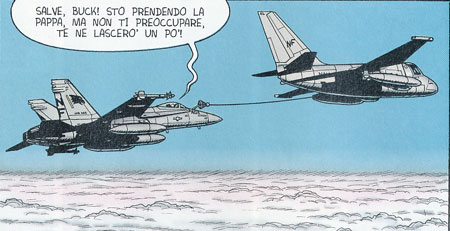 |
A S-3A Viking during air refueling operation is also represented in the story MYSTERE EN ANTARCTIQUE
|
The Lockheed S-3 Viking is a four-seat twin-engine jet aircraft that was used by the U.S. Navy to identify and track enemy submarines. In the late 1990s, the S-3B's mission focus shifted to surface warfare and aerial refueling. The Viking also provided electronic warfare and surface surveillance capabilities to the carrier battle group. A carrier-based, subsonic, all-weather, multi-mission aircraft with long range, it carried automated weapon systems, and was capable of extended missions with in-flight refueling. Because of the engines’ low-pitched sound, it was nicknamed the "Hoover" after the vacuum cleaner brand.
The S-3 was retired from front-line fleet service aboard aircraft carriers by the US Navy in January 2009, with its missions being assumed by other platforms such as the P-3C Orion, SH-60 Seahawk, and F/A-18E/F Super Hornet. Several examples continue to be flown by Air Test and Evaluation Squadron THREE ZERO (VX-30) at Naval Base Ventura County / NAS Point Mugu, California for range clearance and surveillance operations on the NAVAIR Point Mugu Range, and a single example is operated by the National Aeronautics and Space Administration (NASA) at the NASA Glenn Research Center.
|
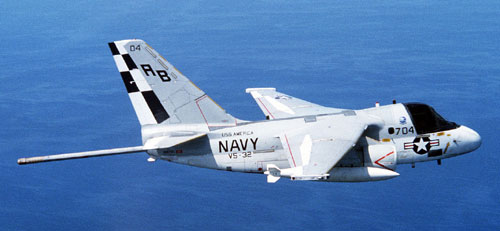 |
|
Northrop Grumman EA-6B Prowler |
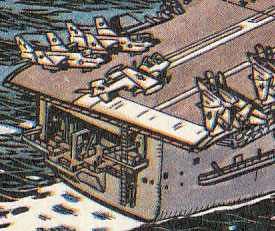 |
One EA-6B Prowler is visible on the flight deck of the USS John Kennedy in the story LE FEU DU CIEL. |
A EA-6B Prowler is also well represented in the story TONNERRE SUR LA CORDILLERE. |
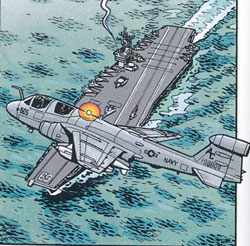 |
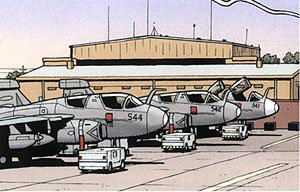 |
Some EA-6B Prowler are also depicted in the story PORTÈ DISPARU. |
The Northrop Grumman (formerly Grumman) EA-6B Prowler is a twin-engine, mid-wing electronic warfare aircraft derived from the A-6 Intruder airframe. The EA-6A was the initial electronic warfare version of the A-6 used by the United States Marine Corps in the 1960s. Development on the more advanced EA-6B began in in 1966. An EA-6B aircrew consists of one pilot and three Electronic Countermeasures Officers, though it is not uncommon for only two ECMOs to be used on missions. It is capable of carrying and firing anti-radiation missiles (ARM), such as the AGM-88 HARM missile.
The Prowler has been in service with the U.S. Armed Forces since 1971. It has carried out numerous missions for jamming enemy radar systems, and in gathering radio intelligence on those and other enemy air defense systems. From the 1998 retirement of the United States Air Force EF-111 Raven electronic warfare aircraft, the EA-6B was the only dedicated electronic warfare plane available for missions by the United States Navy, the United States Marine Corps, and the United States Air Force until the fielding of the Navy's EA-18G Growler in 2009.
|
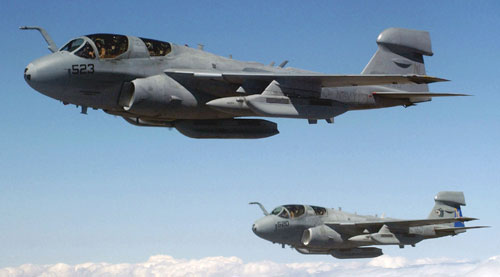 |
|
Mikoyan-Gourevitch MIG-23 "Flogger" |
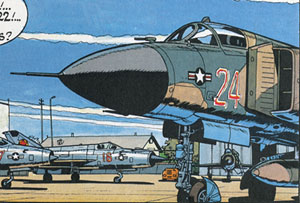 |
A Russian and an "Agressor" MIG-23 are shown in the story LES AGRESSEURS. |
A MIG-23 is also well represented in the story ZONE INTERDITE. |
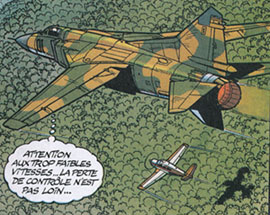 |
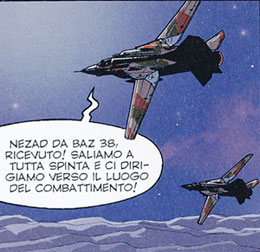 |
Some MIG-23 are also shown in the story COBRA NOIR. |
The Mikoyan-Gurevich MiG-23 (NATO reporting name: Flogger) is a variable-geometry fighter aircraft, designed by the Mikoyan-Gurevich design bureau in the Soviet Union. It is considered to belong to the Soviet third generation jet fighter category, along with similarly aged Soviet fighters such as the MiG-25 "Foxbat". It was the first attempt by the Soviet Union to design look-down/shoot-down radar and one of the first to be armed with beyond visual range missiles, and the first MiG production fighter aircraft to have intakes at the sides of the fuselage. Production started in 1970 and reached large numbers with over 5,000 aircraft built. Today the MiG-23 remains in limited service with various export customers.
The basic design was also used as the basis for the Mikoyan MiG-27, a dedicated ground-attack variant. Among many minor changes, the MiG-27 replaced the MiG-23's nose-mounted radar system with an optical panel holding a laser designator and a TV camera. Ground-attack variants of the MiG-23 were also produced, and these generally saw better export success, retaining more multi-mission capability.
|
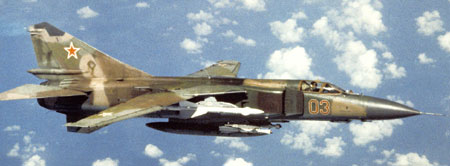 |
|
Mikoyan-Gourevitch MIG-27 "Flogger D/J" |
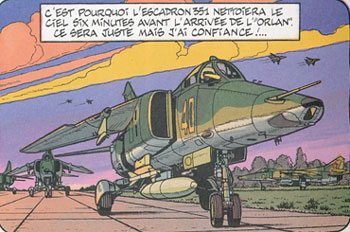 |
Some MIG-27 are shown in the story LES SECRETS DE LA MER NOIRE. |
The Mikoyan MiG-27 (NATO reporting name Flogger-D/J) is a variable-geometry ground-attack aircraft, originally built by the Mikoyan design bureau in the Soviet Union and later license-produced in India by Hindustan Aeronautics as the Bahadur (Valiant). It is based on the Mikoyan-Gurevich MiG-23 fighter aircraft, but optimized for air-to-ground attack. Unlike the MiG-23, the MiG-27 did not see widespread use outside Russia, as most countries opted for the MiG-23BN and Sukhoi Su-22 instead. It currently only remains in service with the Indian, Kazakh and Sri Lankan Air Forces in the ground attack role. All Russian and Ukrainian MiG-27s have been retired.
|
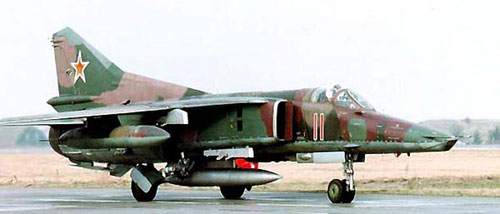 |
|
Mikoyan-Gourevitch MIG-25 "Foxbat E" |
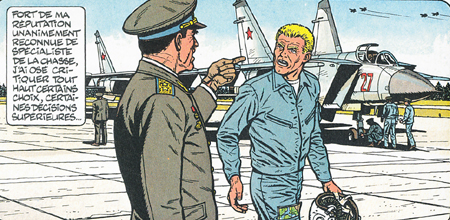 |
A MIG-25PD is well depicted by Bergese in the story LES AGRESSEURS. |
Some MIG-25 are also shown by Bergese and Le Bras in the story LES OISEAUX NOIRS. |
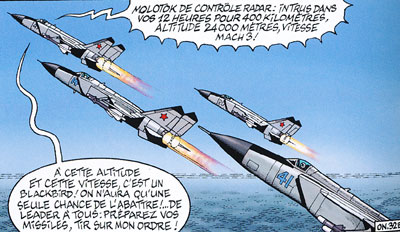 |
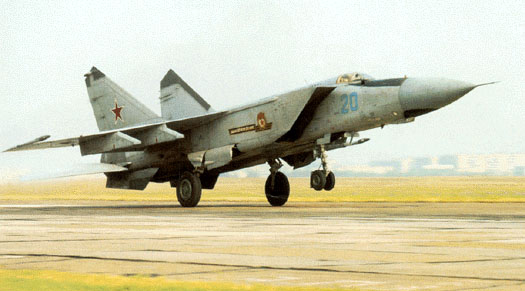 |
The Mikoyan-Gurevich MiG-25 (NATO reporting name: Foxbat) is a supersonic interceptor and reconnaissance aircraft that was among the fastest military aircraft to enter service. It was designed by the Soviet Union's Mikoyan-Gurevich bureau. The first prototype flew in 1964, and the aircraft entered service in 1970. It has an operational top speed of Mach 2.83 (Mach 3.2 is possible but at risk of significant damage to the engines), and features a powerful radar and four air-to-air missiles.
When first seen in reconnaissance photography, the large wing suggested an enormous and highly maneuverable fighter, at a time when U.S. design theories were also evolving towards higher maneuverability due to combat performance in the Vietnam War. The appearance of the MiG-25 sparked serious concern in the West and prompted dramatic increases in performance for the McDonnell Douglas F-15 Eagle then under development in the late 1960s. The capabilities of the MiG-25 were better understood in 1976 when Soviet pilot Viktor Belenko defected in a MiG-25 to the United States via Japan. It turned out that the aircraft's weight necessitated its large wings.
Production of the MiG-25 series ended in 1984 after completion of 1,190 aircraft. A symbol of the Cold War, the MiG-25 flew with Soviet allies and former Soviet republics, remaining in limited service in Russia and several other nations. It is one of the highest-flying military aircraft, and the second fastest after the SR-71 reconnaissance aircraft.
|
|
Fairchild A-10 Thunderbolt II |
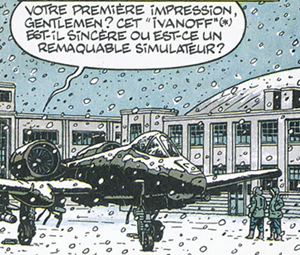 |
An A-10 is also depicted by Bergese in the story LES AGRESSEURS. |
An A-10 is again show by Bergese in the story SAGOTAGE AU TEXAS. |
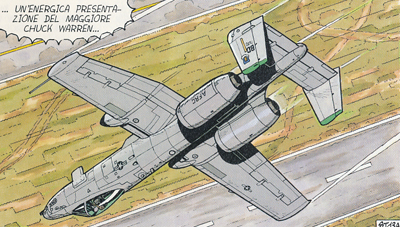 |
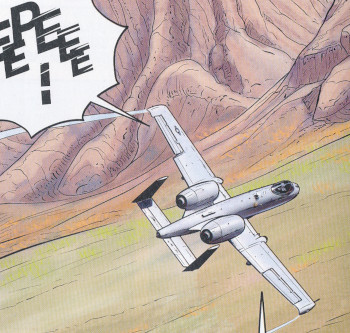 |
Sonny Tuckson is flying on an A-10 in the story LE PACTE!. |
The Fairchild Republic A-10 Thunderbolt II is an American twin-engine, straight wing jet aircraft developed by Fairchild-Republic in the early 1970s. It entered service in 1976, and is the only United States Air Force production aircraft designed solely for close air support, including attacking tanks, armored vehicles, and other ground targets.
The A-10 was designed around the 30 mm GAU-8 Avenger rotary cannon that is its primary armament. The A-10's airframe was designed for durability, with measures such as 1,200 pounds (540 kg) of titanium armor to protect the cockpit and aircraft systems, enabling it to absorb a significant amount of damage and continue flying. Its short takeoff and landing capability permits operation from airstrips close to the front lines, while its simple design enables maintenance at forward bases with limited facilities. The A-10A single-seat variant was the only version built, though one A-10A was converted to an A-10B twin-seat version. In 2005, a program was begun to upgrade remaining A-10A aircraft to the A-10C configuration.
The A-10's official name comes from the Republic P-47 Thunderbolt of World War II, a fighter that was particularly effective at close air support. The A-10 is more commonly known by its nicknames "Warthog" or "Hog". Its secondary mission is to provide forward air controller - airborne (FAC-A) support, by directing other aircraft in attacks on ground targets. Aircraft used primarily in this role are designated OA-10. With a variety of upgrades and wing replacements, the A-10's service life may be extended to 2028, though there are proposals to retire it sooner.
|
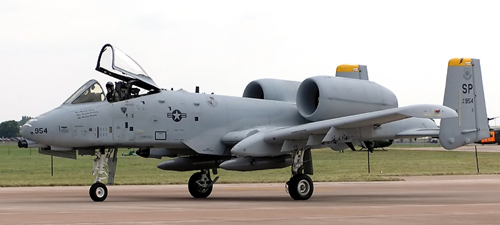 |
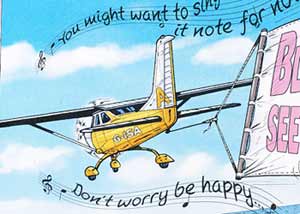 |
A Cesna 172 carring a publicity poster is represented by Formosa in the story LA NUIT DU SPECTRE. |
The Cessna 172 Skyhawk is a four-seat, single-engine, high wing, fixed-wing aircraft made by the Cessna Aircraft Company. First flown in 1955, more Cessna 172s have been built than any other aircraft.
Measured by its longevity and popularity, the Cessna 172 is the most successful aircraft in history. Cessna delivered the first production models in 1956. As of 2015, Cessna, and its partners, had built more than 43,000. The Skyhawk's main competitors have been the Beechcraft Musketeer and Grumman AA-5 series (neither currently in production), the Piper Cherokee, and, more recently, the Diamond DA40.
|
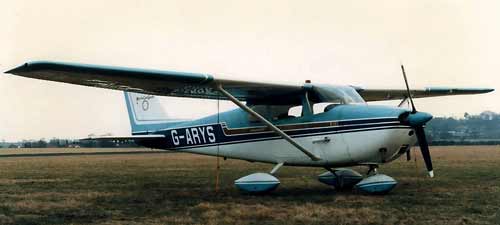 |
|
Boeing KC-135 Stratotanker |
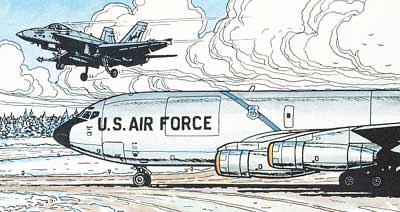 |
An USAF aerial refueling Boeing KC-135 Stratotanker is show by Bergese in the story LES AGRESSEURS |
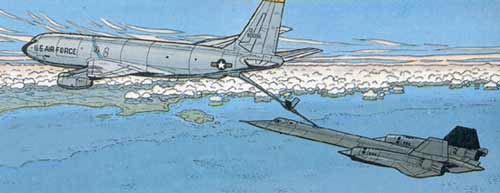 |
The aerial refueling Boeing KC-135 Stratotanker is again show by Bergese and Le Bras in the story LES OISEAUX NOIRS |
Some USAF aerial refueling Boeing KC-135 Stratotanker are also depicted by Bergese in the story L'ESCADRILLE FANTOME |
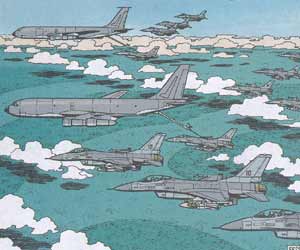 |
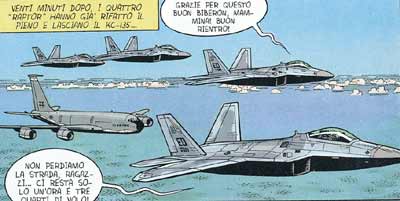 |
An USAF Boeing KC-135 Stratotanker is also refueling the F-22 of Buck Danny and friends in the story LA NUIT DU SERPENT |
An USAF aerial refueling Boeing KC-135 Stratotanker is represented in the story TRAQUE EN HAUTE ALTITUDE |
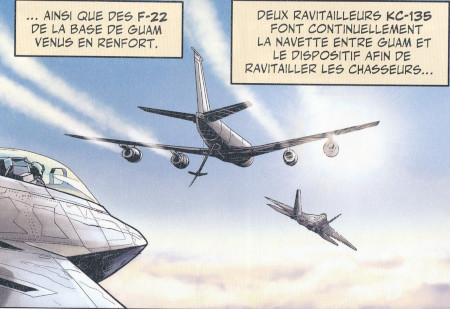 |
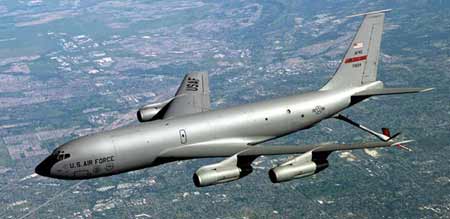 |
The Boeing KC-135 Stratotanker is a military aerial refueling aircraft. It and the Boeing 707 airliner were developed from the Boeing 367-80 prototype. The KC-135 was the US Air Force's first jet-powered refueling tanker and replaced the KC-97 Stratofreighter. The KC-135 was initially tasked with refueling strategic bombers, but was used extensively in the Vietnam War and later conflicts such as Operation Desert Storm to extend the range and endurance of US tactical fighters and bombers.
The KC-135 entered service with the United States Air Force (USAF) in 1957; it is one of six military fixed-wing aircraft with over 50 years of continuous service with its original operator. The KC-135 is supplemented by the larger KC-10. Studies have concluded that many of the aircraft could be flown until 2040, although maintenance costs have greatly increased. The aircraft will eventually be replaced by the Boeing KC-46 Pegasus.
|
 |
Some USAF T-38 are well depicted by Bergese in the story LES AGRESSEURS. |
The Northrop T-38 Talon is a two-seat, twin-engined supersonic jet trainer. It was the world's first supersonic trainer and is also the most produced. The T-38 remains in service as of 2015 in several air forces.
The United States Air Force (USAF) operates the most T-38s. In addition to training USAF pilots, the T-38 is used by NASA. The US Naval Test Pilot School is the principal US Navy operator (other T-38s were previously used as USN aggressor aircraft until replaced by the similar Northrop F-5 Tiger II). Pilots of other NATO nations fly the T-38 in joint training programs with USAF pilots.
As of 2015, the T-38 has been in service for over 50 years with its original operator, the United States Air Force.
|
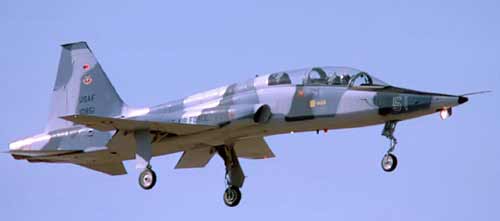 |
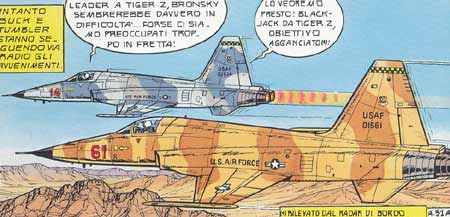 |
Some F-5 of the USAF Agressors Squadron of Nellis AFB are well represented by Bergese in the story LES AGRESSEURS. |
A Chilean Air Force F-5F Tiger III is well represented by Formosa in the story OPERATION VEKTOR. |
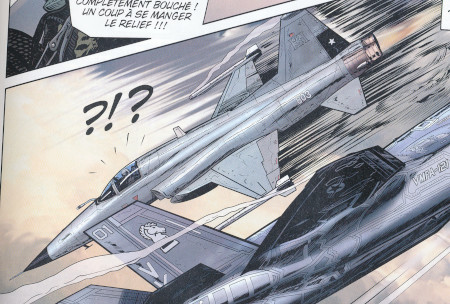 |
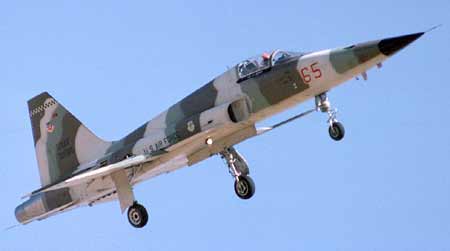 |
The Northrop F-5A and F-5B Freedom Fighter and the F-5E and F-5F Tiger II are part of a supersonic light fighter family, initially designed in the late 1950s by Northrop Corporation. Being smaller and simpler than contemporaries such as the McDonnell Douglas F-4 Phantom II, the F-5 cost less to both procure and operate, making it a popular export aircraft. The F-5 started life as a privately funded light fighter program by Northrop in the 1950s. The design team wrapped a small, highly aerodynamic fighter around two compact and high-thrust General Electric J85 engines, focusing on performance and low cost of maintenance. Though primarily designed for the day air superiority role, the aircraft is also a capable ground-attack platform. The F-5A entered service in the early 1960s. During the Cold War, over 800 were produced through 1972 for U.S. allies. Though the USAF had no acknowledged need for a light fighter, it did procure roughly 1,200 Northrop T-38 Talon trainer aircraft, which were directly based on the F-5A.
|
The Chilean upgrade of F-5F, called the F-5 Tiger III Plus, incorporated a new Elta EL/M-2032 radar and other improvements. |
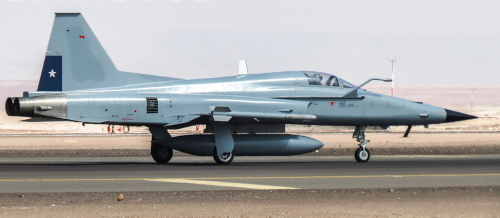 |
|
Republic F-105 Thunderchief |
 |
An USAF F-105 Thunderchief during the Vietnam war is well depicted by Bergese in the story LES AGRESSEURS. |
The Republic F-105 Thunderchief was a supersonic fighter-bomber used by the United States Air Force. The Mach 2 capable F-105 conducted the majority of strike bombing missions during the early years of the Vietnam War; it was the only U.S. aircraft to have been removed from combat due to high loss rates. Originally designed as a single-seat, nuclear-attack aircraft, a two-seat Wild Weasel version was later developed for the specialized Suppression of Enemy Air Defenses (SEAD) role against surface-to-air missile sites. The F-105 was commonly known as the "Thud" by its crews.
The Thunderchief was the largest single-seat, single-engine combat aircraft in history, weighing approximately 50,000 pounds (23,000 kg). It could exceed the speed of sound at sea level and reach Mach 2 at high altitude; the F-105 could carry up to 14,000 lb (6,400 kg) of bombs and missiles. The Thunderchief was later replaced as a strike aircraft over North Vietnam by both the McDonnell Douglas F-4 Phantom II and the swing-wing General Dynamics F-111 Aardvark. However, the "Wild Weasel" variants of the F-105 remained in service until 1984 after being replaced by the specialized F-4G "Wild Weasel V".
|
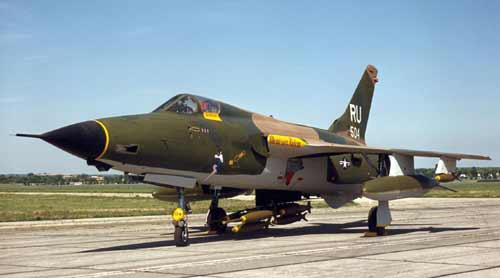 |
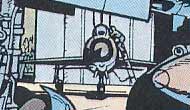 |
What is probably a Sukhoi Su-9 used by USAF Agressor Squadron in Nellis AFB is show in the story LES AGRESSEURS. |
The Sukhoi Su-9 (NATO reporting name: Fishpot) was a single-engine, all-weather, missile-armed interceptor aircraft developed by the Soviet Union.
Total production of the Su-9 was about 1,100 aircraft. It is believed that at least some Su-9s were upgraded to Su-11 'Fishpot-C' form. None were exported to any of the USSR's client states nor to the Warsaw Pact nations. Remaining Su-9s and later Su-11s were retired during the 1970s. Some were retained as test vehicles or converted to remote-piloted vehicles for use as unmanned aerial vehicles. It was replaced by the upgraded Su-11 and the much-superior Su-15 Flagon and MiG-25 Foxbat.
The combat record of the Fishpot, if any, is unknown. It is possible that it was involved in the interception (or even shoot-down) of reconnaissance missions whose details remain classified, but nothing is publicly admitted.
|
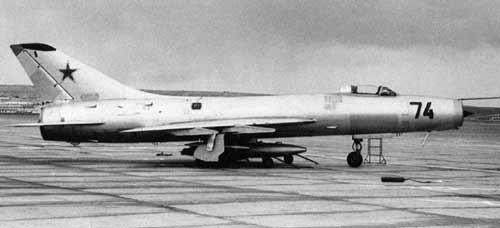 |
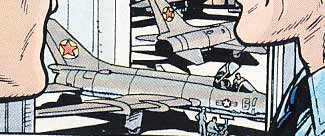 |
What is probably a Sukhoi Su-22 used by USAF Agressor Squadron in Nellis AFB is show in the story LES AGRESSEURS. |
The Sukhoi Su-17 (NATO reporting name: Fitter) is a Soviet variable-sweep wing fighter-bomber developed from the Sukhoi Su-7. It enjoyed a long career in Soviet, later Russian, service and was widely exported to Eastern Bloc, Arab air forces, Angola and Peru as the Su-20 and Su-22. It is the first variable-sweep wing of Russian/Soviet origin. The Su-17 set a number of world records.
|
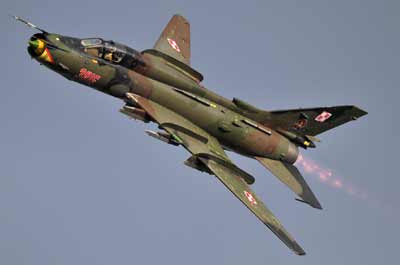 |
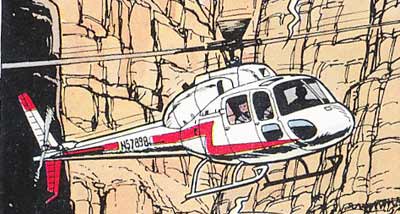 |
An helicopter AS 355 or Twin Star is shown by Bergese in the story LES AGRESSEURS. |
An Airbus Helicopter AS 355 is also shown by Bergese in the story SABOTAGE AU TEXAS
|
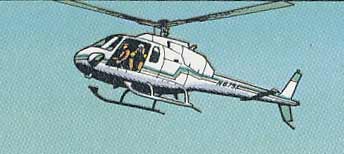 |
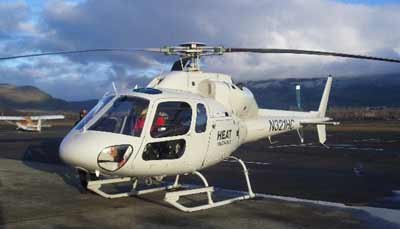 |
The Airbus Helicopters (formerly Eurocopter) AS355 Ecureuil 2 (Twin Squirrel) is a twin-engine light helicopter originally manufactured by Aérospatiale in France (later part of Eurocopter Group, now Airbus Helicopters). The AS355 is marketed in North America as the TwinStar.
|
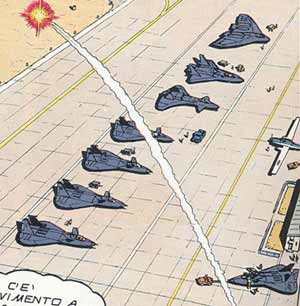 |
Some fantasy secret prototype of stealth aircraft are shown in the Tonopah AFB in the story LES AGRESSEURS. These representations are mainly based on the fantasy F-19 stealth aircraft models kit and generic flying wing design. |
Before was know the real aspect of the stealth aircraft F-117 and B-2 the F-19 models kit has been wrongly considered by several aviation enthusiasts as the real design of the secret stealth aircraft tested in the Groom Lake area.
|
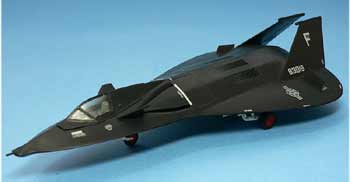 |
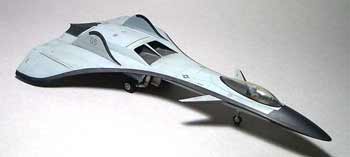 |
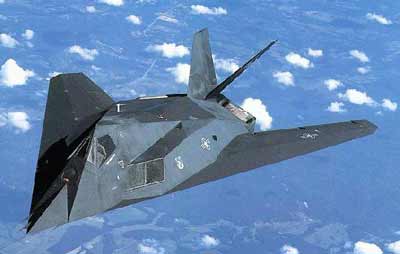 |
The Lockheed F-117 Nighthawk is a single-seat, twin-engine stealth attack aircraft that was developed by Lockheed's secretive Skunk Works division and operated by the United States Air Force (USAF). The F-117 was based on the Have Blue technology demonstrator, and was the first operational aircraft to be designed around stealth technology. The maiden flight of the Nighthawk happened in 1981 and the aircraft achieved initial operating capability status in 1983. The Nighthawk was shrouded in secrecy until it was revealed in 1988.
The F-117 was widely publicized for its role in the Gulf War of 1991. Although it was commonly referred to as the "Stealth Fighter", it was a strictly ground-attack aircraft. F-117s took part in the conflict in Yugoslavia where one was shot down by a surface-to-air missile (SAM) on 27 March 1999; it was the only Nighthawk to be lost in combat. The U.S. Air Force retired the F-117 on 22 April 2008, primarily due to the fielding of the F-22 Raptor. Sixty-four F-117s were built, 59 of which were production versions with the other five being demonstrators/prototypes.
|
The Northrop (later Northrop Grumman) B-2 Spirit, also known as the Stealth Bomber, is an American heavy penetration strategic bomber, featuring low observable stealth technology designed for penetrating dense anti-aircraft defenses; it is a flying wing design with a crew of two. The bomber can deploy both conventional and thermonuclear weapons, such as eighty 500 lb (230 kg)-class (Mk 82) JDAM Global Positioning System-guided bombs, or sixteen 2,400 lb (1,100 kg) B83 nuclear bombs. The B-2 is the only acknowledged aircraft that can carry large air-to-surface standoff weapons in a stealth configuration.
|
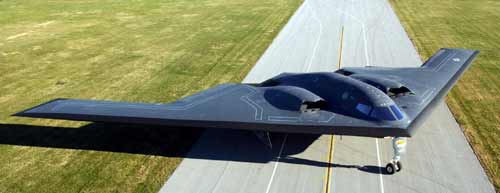 |
|
Russian R-7 Semyorka rocket |
 |
A Russian R-7 rocket is well represented by Le Bras in the second episode of the story LES OISEAUX NOIRS |
The R-7 family of rockets is a series of rockets, derived from the Soviet R-7 Semyorka, the world's first ICBM. More R-7 rockets have been launched than any other family of large rockets.
When Soviet nuclear warheads got lighter, the R-7 turned out to be impractical as a ballistic missile. It was not necessary to launch such heavy payloads in a military application. The rockets became useful in the Soviet, and later, Russian space programmes with long-term development. Their purpose shifted primarily to launching satellites, probes, manned and unmanned spacecraft, and other non-threatening payloads. The R-7 family consists of both missiles and orbital carrier rockets. Derivatives include the Vostok, Voskhod and Soyuz rockets, which as of 2017 have been used for all Soviet, and later Russian manned spaceflights. The type has a unique configuration where four break-away liquid-fueled engines surround a central core. The core acts as, in effect, a "second stage" after the other four engines are jettisoned.
Later modifications were standardised around the Soyuz design. The Soyuz-FG and Soyuz-2 are currently in use. The official Russian press announced that the Soyuz-FG is to be retired by 2019 or 2020 in favour of the Soyuz-2.1a. R-7 rockets are launched from the Baikonur Cosmodrome, Plesetsk Cosmodrome, Guiana Space Centre (since 2011, see Soyuz at the Guiana Space Centre), and the Vostochny Cosmodrome (first launch 2016).
After the R-7/Soyuz-U and the Thor and Delta rocket families, the Kosmos launch vehicle , the best known of which is the Kosmos-3M, holds the 3rd place record for number of successful orbital launch attempts, that is, of placing a satellite in orbit
|
 |
|
United Launch Alliance Delta II rocket |
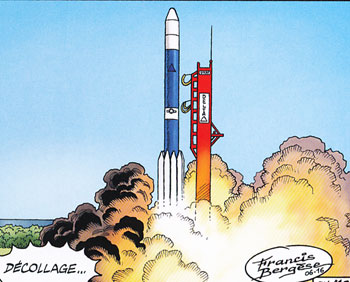 |
A Delta II rocket launched from Vandenberg AFB is well represented by Bergese in the story LES OISEAUX NOIRS |
Delta is an American versatile family of expendable launch systems that has provided space launch capability in the United States since 1960. There have been more than 300 Delta rockets launched, with a 95% success rate. Two Delta launch systems – Delta II and Delta IV – are still in use, though the Delta II will soon be retired. Delta rockets are currently manufactured and launched by the United Launch Alliance.
|
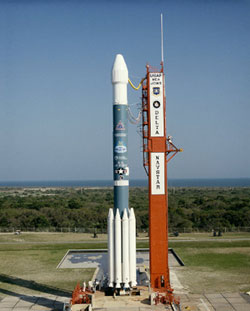 |
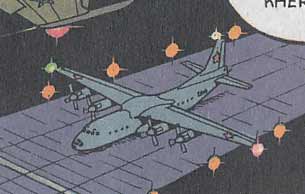 |
A possible Russian Air Force An-12 is represented in the story LES SECRETS DE LA MER NOIRE |
The Antonov An-12 is also well represented by Formosa in the adventure VOSTOK NE REPOND PLUS and OPERATION VEKTOR.
|
 |
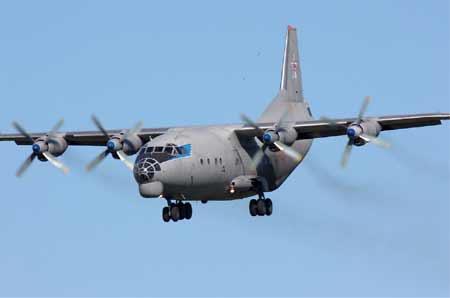 |
The Antonov An-12 (NATO reporting name: Cub) is a four-engined turboprop transport aircraft designed in the Soviet Union. It is the military version of the Antonov An-10 and has many variants.
The first prototype An-12 flew in December 1957. Over 900 had been built (both military and civilian versions) when Soviet production finally ended in 1973. The An-12BP entered Soviet military service in 1959. In terms of configuration, size, and capability, the aircraft is similar to the United States-built Lockheed C-130 Hercules. Soviet military and former-Soviet An-12s have a defensive tail gun turret.
|
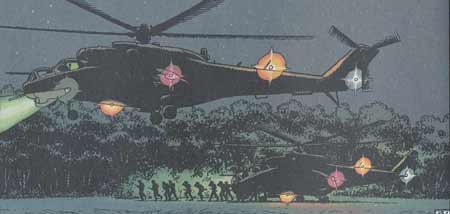 |
Some Russian Mil Mi-24 are shown by Bergese in the story LES SECRETS DE LA MER NOIRE |
Another Mil Mi-24 is also well depicted by Bergese in the adventures ZONE INTERDITE and TONNERRE SUR LA CORDILLERE
|
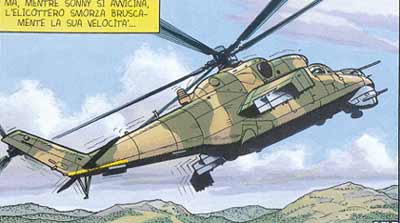 |
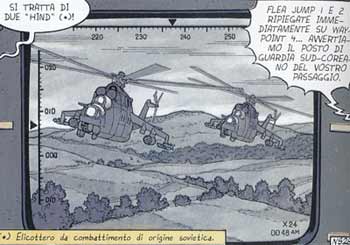 |
Two North Korean Mil Mi-24 are shown by Bergese in the story LA NUIT DU SERPENT |
| The Mil Mi-24 (NATO reporting name: Hind) is a large helicopter gunship, attack helicopter and low-capacity troop transport with room for eight passengers. It is produced by Mil Moscow Helicopter Plant and has been operated since 1972 by the Soviet Air Force and its successors, along with more than 30 other nations.
In NATO circles, the export versions, Mi-25 and Mi-35, are denoted with a letter suffix as "Hind D" and "Hind E". Soviet pilots called the Mi-24 the "flying tank" , a term used historically with the famous World War II Soviet Il-2 Shturmovik armored ground attack aircraft. More common unofficial nicknames were "Crocodile" , due to the helicopter's camouflage scheme and "Drinking Glass", because of the flat glass plates that surround the Mi-24's cockpit.
|
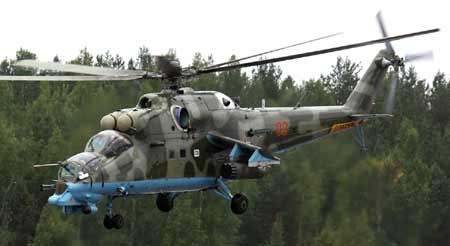 |
 |
A Russian Navy Kamov Ka-25 is well represented by Bergese in the story LES SECRETS DE LA MER NOIRE |
The Kamov Ka-25 (NATO reporting name "Hormone") is a soviet antisubmarine helicopter developed to be carried on ships. It has been the first Soviet helicopter designed for a specic military operation and thus the first USSR combat helicopter. To the initial design Ka-25 several modification have been made in order to adapt the projet for other specific purpose and different rules.
The Ka-25 was developed by the OKB Kamov under the direction of the designer Nikolaj Kamov, its production started in 1965 and it become operative the 2nd of dicember 1971
|
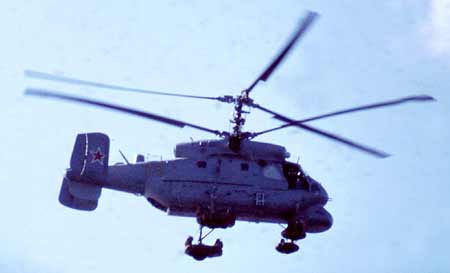 |
 |
Two Russian Navy Yakovlev Yak-38 single seat (Yak-38 "Forger A") and two seats (Yak-38U "Forger B") are also well represented by Bergese in the story LES SECRETS DE LA MER NOIRE |
The Yakovlev Yak-38 (NATO reporting name: "Forger") was Soviet Naval Aviation's only operational VTOL strike fighter aircraft, in addition to being its first operational carrier-based fixed-wing aircraft. It was developed specifically for and served almost exclusively on the Kiev-class aircraft carriers.
The Yak-38's limited useful payload was always its Achilles' heel, but the high ambient temperatures that had been encountered in the Black Sea during the summer 1976 trials frequently prevented the aircraft from carrying any external stores at all, despite a reduced fuel load. Similar problems were then encountered when Minsk sailed off the coast of West Africa and then in the Indian Ocean; in these instances the lift jets proved unwilling to start under hot and humid conditions. An oxygen-boosting intake system[clarification needed] helped alleviate the problem, and was installed from September 1979 during routine overhauls. In July 1979, Minsk arrived in the Sea of Japan, where the vessel was home-ported at Strelok Bay, the Yak-38 component of its air wing thereafter being provided by the 311 OKShAP subordinate to the Pacific Fleet
|
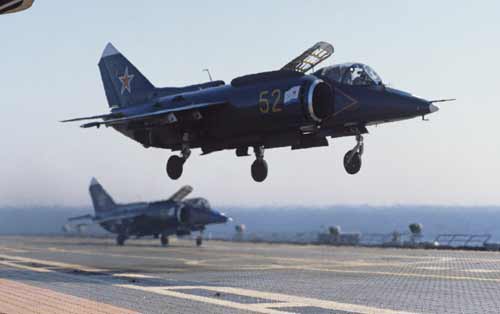 |
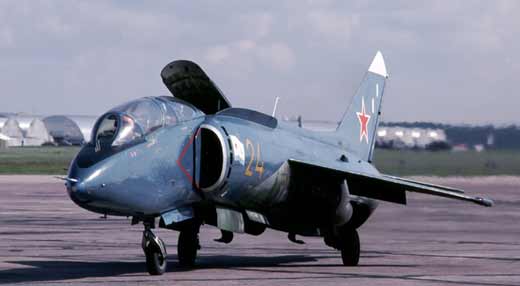 |
During April and May 1980, four Yak-38s and four AV-MF pilots were deployed to Afghanistan as part of a 50-day trial codenamed Romb-1, although the "hot and high" conditions prevented any meaningful combat missions from being undertaken – in total, 12 combat sorties were made, but only two 100 kg (220 lb) bombs could be carried.
In September 1982, Novorossiysk - the third Kiev-class carrier - was commissioned. By now the V/STOL technique had been well practised, and the resulting increase in the Yak-38’s overall performance and capability was exploited during the passage of Novorossiysk from Severomorsk to join the Pacific Fleet. In a maritime context, the Yak-38 was not limited to the decks of Kievs. In September 1983, AV-MF pilots operated from the civilian Ro-Ro vessel Agostinio Neto, and NII-VVS pilots conducted further tests from another "Ro-Ro", Nikolai Cherkasov. In both cases, use was made of a heat-resistant landing platform; further land-based trials tested the practicality of dispersed landing platforms, in a similar concept to the RAF’s Harrier operations in West Germany.
|
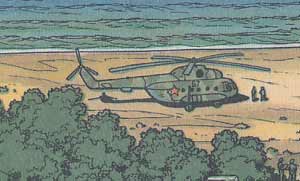 |
A Russian military transoprt helicopter Mil Mi-8 is represented by Bergese in the story LES SECRETS DE LA MER NOIRE |
A civilian Mil Mi-8 is also shown by Bergese in the adventures ZONE INTERDITE and TONNERRE SUR LA CORDILLERE
|
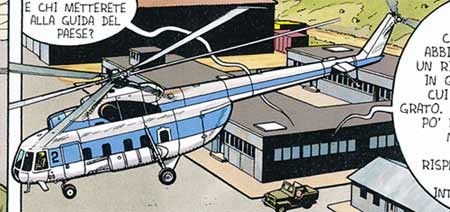 |
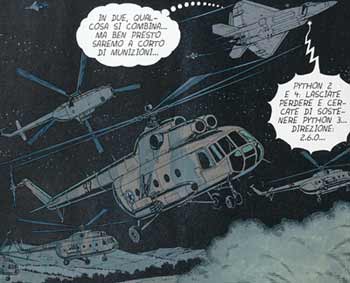 |
Some North Korean Mil Mi-8 are depicted by Bergese in the story LA NUIT DU SERPENT
|
A Mil Mi-8T used by a criminal mercenary group is shown by Bergese in the adventures MYSTERE EN ANTARCTIQUE
|
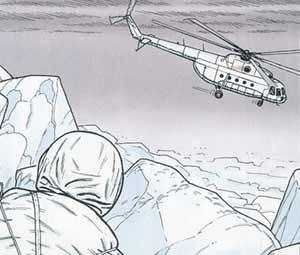 |
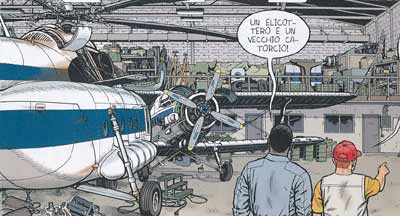 |
A Mil Mi-8 is also visible in the story PORTÈ DISPARU
|
A Mil Mi-8 is also used by Lady X in the adventure DEFCON ONE
|
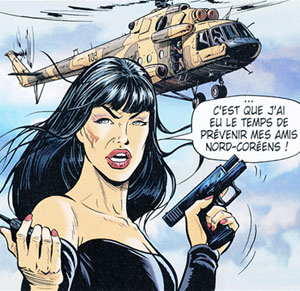 |
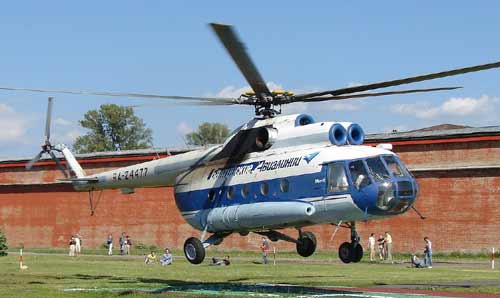 |
The Mil Mi-8 (NATO reporting name: Hip) is a medium twin-turbine helicopter, originally designed by the Soviet Union, and now produced by Russia. In addition to its most common role as a transport helicopter, the Mi-8 is also used as an airborne command post, armed gunship, and reconnaissance platform. Along with the related, more powerful Mil Mi-17, the Mi-8 is among the world's most-produced helicopters, used by over 50 countries. As of 2015, it is the third most common operational military aircraft in the world.
|
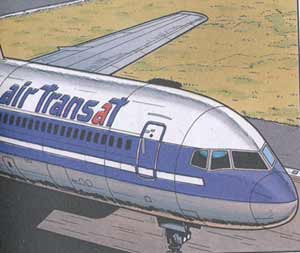 |
A possible Boeing 757 is represented by Bergese in the story ZONE INTERDITE |
The Boeing 757 is a mid-size, narrow-body twin-engine jet airliner that was designed and built by Boeing Commercial Airplanes. It is the manufacturer's largest single-aisle passenger aircraft and was produced from 1981 to 2004. The twinjet has a two-crew member glass cockpit, turbofan engines of sufficient power to allow takeoffs from relatively short runways and higher altitudes, a conventional tail and, for reduced aerodynamic drag, a supercritical wing design. Intended to replace the smaller three-engine 727 on short and medium routes, the 757 can carry 200 to 295 passengers for a maximum of 3,150 to 4,100 nautical miles (5,830 to 7,590 km), depending on variant. The 757 was designed concurrently with a wide-body twinjet, the 767, and owing to shared features pilots can obtain a common type rating that allows them to operate both aircraft.
The 757 was produced in two fuselage lengths. The original 757-200 entered service in 1983; the 757-200PF, a package freighter (PF) variant, and the 757-200M, a passenger-freighter combi model, debuted in the late 1980s. The stretched 757-300, the longest narrow-body twinjet ever produced,[2] began service in 1999. Passenger 757-200s have been modified to special freighter (SF) specification for cargo use, while military derivatives include the C-32 transport, VIP carriers, and other multi-purpose aircraft. Private and government operators have also customized the 757 for research and transport roles. All 757s are powered by Rolls-Royce RB211 or Pratt & Whitney PW2000 series turbofans.
|
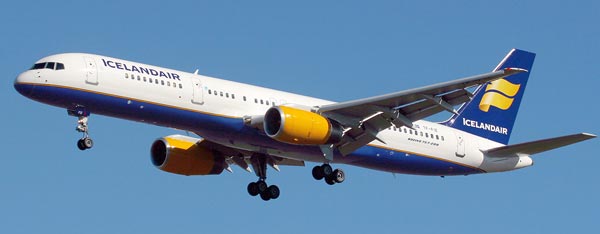 |
A Boeing 767-300 of the Continental Airlines is represented by Bergese in the story PORTÈ DISPARU |
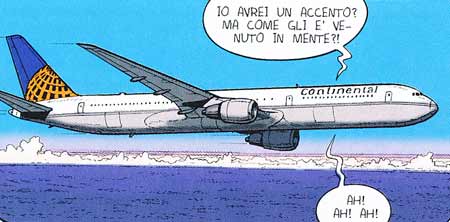 |
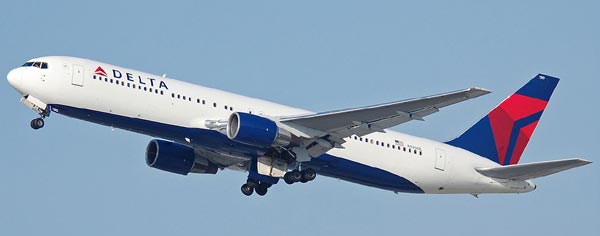 |
The Boeing 767 is a mid- to large-size, mid- to long-range, wide-body twin-engine jet airliner built by Boeing Commercial Airplanes. It was Boeing's first wide-body twinjet and its first airliner with a two-crew glass cockpit. The aircraft has two turbofan engines, a conventional tail, and, for reduced aerodynamic drag, a supercritical wing design. Designed as a smaller wide-body airliner than earlier aircraft such as the 747, the 767 has seating capacity for 181 to 375 people, and a design range of 3,850 to 6,385 nautical miles (7,130 to 11,825 km), depending on variant. Development of the 767 occurred in tandem with a narrow-body twinjet, the 757, resulting in shared design features which allow pilots to obtain a common type rating to operate both aircraft.
The 767 is produced in three fuselage lengths. The original 767-200 entered service in 1982, followed by the 767-300 in 1986 and the 767-400ER, an extended-range (ER) variant, in 2000. The extended-range 767-200ER and 767-300ER models entered service in 1984 and 1988, respectively, while a production freighter version, the 767-300F, debuted in 1995. Conversion programs have modified passenger 767-200 and 767-300 series aircraft for cargo use, while military derivatives include the E-767 surveillance aircraft, the KC-767 and KC-46 aerial tankers, and VIP transports. Engines featured on the 767 include the General Electric CF6, Pratt & Whitney JT9D and PW4000, and Rolls-Royce RB211 turbofans.
|
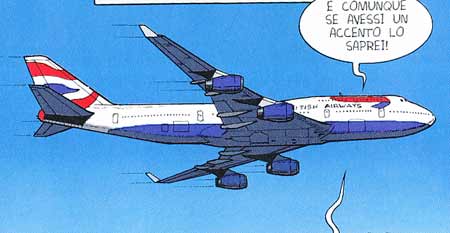 |
A Boeing 747-400 of the British Airways is represented by Bergese in the story PORTÈ DISPARU |
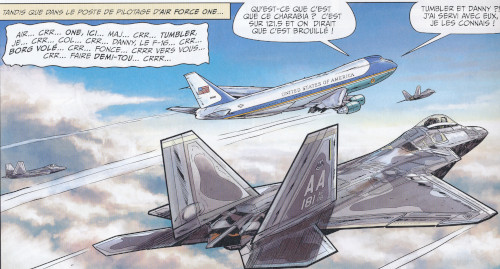 |
The 747 Air Force One is represented by Formosa in the story AIR FORCE ONE |
The Boeing 747 is a wide-body commercial jet airliner and cargo aircraft, often referred to by its original nickname, Jumbo Jet, or Queen of the Skies. Its distinctive "hump" upper deck along the forward part of the aircraft makes it among the world's most recognizable aircraft, and it was the first wide-body produced. Manufactured by Boeing's Commercial Airplane unit in the United States, the original version of the 747 had two and a half times greater capacity than the Boeing 707, one of the common large commercial aircraft of the 1960s. First flown commercially in 1970, the 747 held the passenger capacity record for 37 years.
The four-engine 747 uses a double deck configuration for part of its length. It is available in passenger, freighter and other versions. Boeing designed the 747's hump-like upper deck to serve as a first class lounge or extra seating, and to allow the aircraft to be easily converted to a cargo carrier by removing seats and installing a front cargo door. Boeing did so because the company expected supersonic airliners (development of which was announced in the early 1960s) to render the 747 and other subsonic airliners obsolete, while the demand for subsonic cargo aircraft would be robust well into the future. The 747 was expected to become obsolete after 400 were sold, but it exceeded critics' expectations with production passing the 1,000 mark in 1993. By January 2016, 1,520 aircraft had been built, with 19 of the 747-8 variants remaining on order.
The 747-400, the most common passenger version in service, has a high-subsonic cruise speed of Mach 0.85–0.855 (up to 570 mph or 920 km/h) with an intercontinental range of 7,260 nautical miles (8,350 mi or 13,450 km). The 747-400 passenger version can accommodate 416 passengers in a typical three-class layout, 524 passengers in a typical two-class layout, or 660 passengers in a high density one-class configuration. The newest version of the aircraft, the 747-8, is in production and received certification in 2011. Deliveries of the 747-8F freighter version to launch customer Cargolux began in October 2011; deliveries of the 747-8I passenger version to Lufthansa began in May 2012.
|
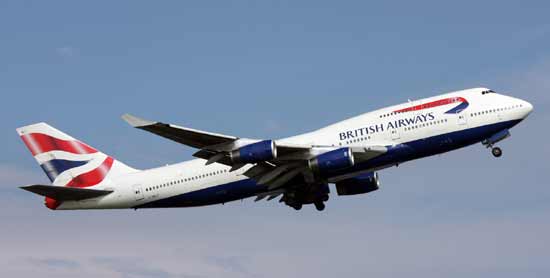 |
|
de Havilland Canada DHC-5 (C-8) Buffalo |
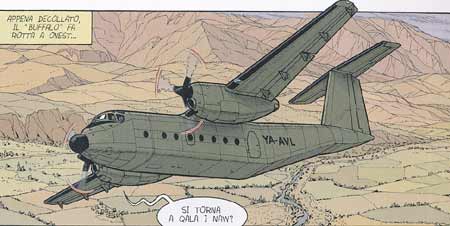 |
A de Havilland Canada DHC-5 Buffalo is well represented by Bergese in the story PORTÈ DISPARU |
The de Havilland Canada DHC-5 Buffalo is a short takeoff and landing (STOL) utility transport, a turboprop aircraft developed from the earlier piston-powered DHC-4 Caribou. The aircraft has extraordinary STOL performance and is able to take off in distances much shorter than even light aircraft can manage.
On February 24, 2006, Viking Air of Victoria, British Columbia, a manufacturer of replacement parts for all out-of-production de Havilland Canada aircraft, purchased the type certificates from Bombardier Aerospace for all versions of the DHC-1 through DHC-7 series aircraft, giving Viking exclusive rights to manufacture and sell new aircraft of those types. In December 2008, Viking Air indicated their intention to put the Buffalo series back into production at their home factory in Victoria, British Columbia or in Calgary, Alberta. The new production Buffalo features Pratt & Whitney Canada PW150 turboprops, a glass cockpit, enhanced vision and night vision goggle capability. The company intends to propose the aircraft as a replacement for the Royal Canadian Air Force fleet of existing DHC-5As, and says it has received extensive interest in the type, including several letters of intent for the DHC-5NG
|
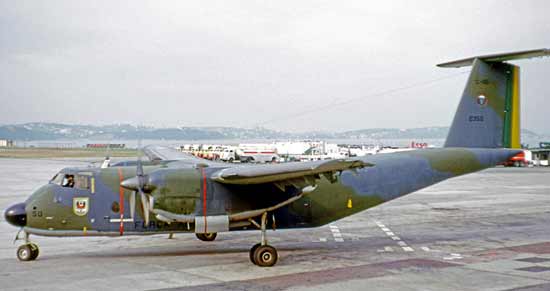 |
 |
A An Antonov An-26 is also represented by Bergese in the story PORTÈ DISPARU |
The Antonov An-26 (NATO reporting name: Curl) is a twin-engined turboprop civilian and military transport aircraft, designed and produced in the Soviet Union from 1969 to 1985.
After successful operations of the An-24T tactical transport in austere locations, interest in a version with a retractable cargo ramp increased. Initial studies for the retractable ramp were carried out as part of the projected An-40 medium transport. When given the go-ahead for the An-26 in March 1968 the Antonov OKB adapted the ramp design of the An-40 to the An-24 fuselage, thus was born the An-26. Particular attention was given to the military mission and the majority of early An-26 production was delivered to the VTA (voyenno-transportnoy aviatsii).
Using the majority of the An-24 airframe, with its high-set cantilevered wings, twin turboprops and stalky main undercarriage, the An-26 included military equipment, such as tip-up paratroop canvas seats, overhead traveling hoist, bulged observation windows and parachute static line attachment cables. The An-26 made its public debut at the 27th Paris Air Show at Le Bourget where the second prototype, CCCP-26184 (c/n00202), was shown in the static aircraft park.
The An-26 is also manufactured without a license agreement in China by Xian Aircraft Factory as the Y-14, later changed to be included in the Xian Y7 series.
|
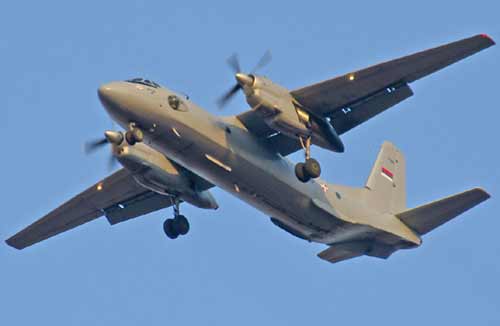 |
|
Piper PA-28 Cherokee, Warrior, Archer, Dakota, Arrow |
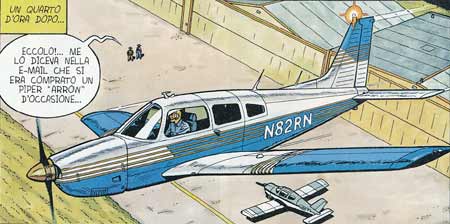 |
A Piper PA-28 Arrow is well represented by Bergese in the story SABOTAGE AU TEXAS |
The Piper PA-28 Cherokee is a family of light aircraft built by Piper Aircraft and designed for flight training, air taxi, and personal use. The PA-28 family of aircraft are all-metal, unpressurized, single-engine, piston-powered airplanes with low-mounted wings and tricycle landing gear. They have a single door on the copilot side, which is entered by stepping on the wing.
The first PA-28 received its type certificate from the Federal Aviation Administration in 1960, and the series remains in production to this day. Current models are the Arrow and the Archer TX and LX. The Archer was discontinued in 2009, but with investment from new company ownership, the model was put back into production in 2010.
The PA-28 series competes with the Cessna 172, the Grumman American AA-5 series, and the Beechcraft Musketeer.
Piper has created variations within the Cherokee family by installing engines ranging from 140 to 300 hp (105-220 kW), offering turbocharging, retractable landing gear, constant speed propeller, and stretching the fuselage to accommodate six people. The Piper PA-32 (initially known as "Cherokee Six") is a larger, six-seat variant of the PA-28. The PA-32 Saratoga variant was in production until 2009.
|
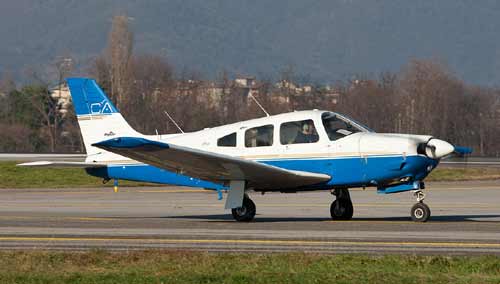 |
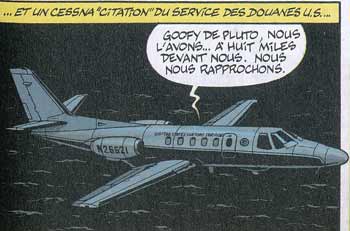 |
A Cessna Citation is show by Bergese at the beginning of the story ZONE INTERDITE |
The Cessna Citation is a market brand-name used by American manufacturer Cessna for its line of business jets. Rather than one particular model of aircraft, the name applies to several "families" of turbofan-powered aircraft that have been produced over the years. Within each of the six distinct families, aircraft design improvements, market pressures and re-branding efforts have resulted in a number of variants, so that the Citation lineage has become quite complex. Military variants include the T-47 and UC-35 series aircraft.
More than 6,750 Citations have been delivered, forming the largest business jet fleet. The first Citation was put into service in 1972, more than 31 million flight hours have been logged since.
|
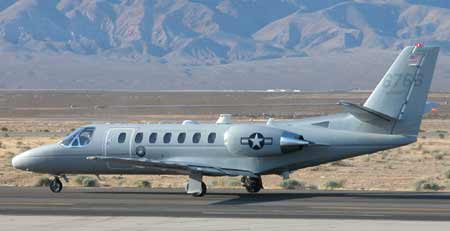 |
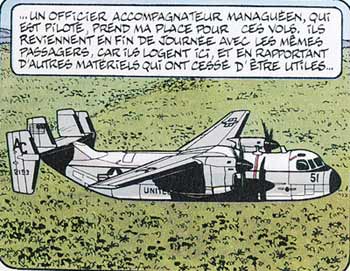 |
A C-2 Greyhound is well represented by Bergese in the adventure ZONE INTERDITE and TONNERRE SUR LA CORDILLERE |
Another C-2 Greyhound is always show by Bergese in the story MYSTERE EN ANTARCTIQUE
|
 |
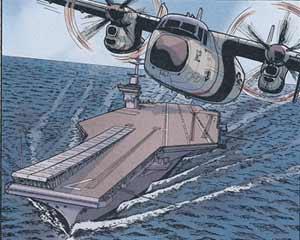 |
A C-2 Greyhound is also represented by Winis in the adventure COBRA NOIR |
A C-2 Greyhound drawn by Formosa is also visible in the story LA NUIT DU SPECTRE
|
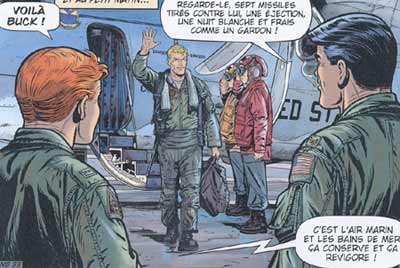 |
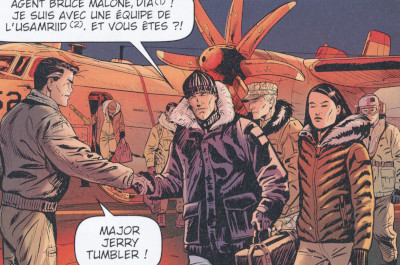 |
A C-2A Greyhound is also represented by Formosa in the adventure VOSTOK NE REPOND PLUS |
A C-2 Greyhound drawn by Philippe is also visible in the story TRAQUE EN HAUTE ALTITUDE
|
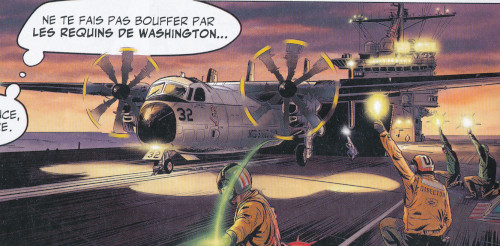 |
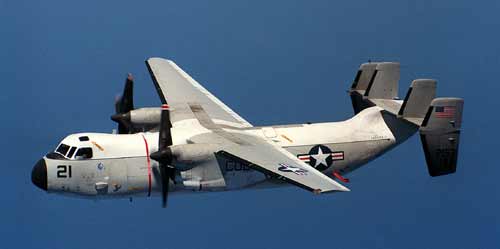 |
The Grumman C-2 Greyhound is a twin-engine, high-wing cargo aircraft, designed to carry supplies, mail, and passengers to and from aircraft carriers of the United States Navy. Its primary mission is carrier onboard delivery (COD). The aircraft provides critical logistics support to carrier strike groups. The aircraft is mainly used to transport high-priority cargo, mail and passengers between carriers and shore bases, and can also deliver cargo like jet engines and special stores.
Prototype C-2s first flew in 1964 and production followed the next year. The initial Greyhound aircraft were overhauled in 1973. In 1984, more C-2As were ordered under the name Reprocured C-2A or C-2A(R). The C-2As received updated propellers (from four to eight blades) and navigation.
|
|
Cessna A-37 Dragonfly and T-37 Tweet |
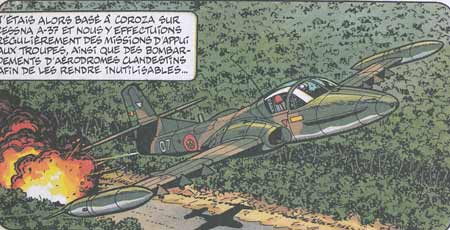 |
A Cessna A-37 Dragonfly of the Manguan Air Force is show by Bergese in the story ZONE INTERDITE |
A Cessna T-37 Tweet USAF trainer is show by Bergese in the story SABOTAGE AU TEXAS |
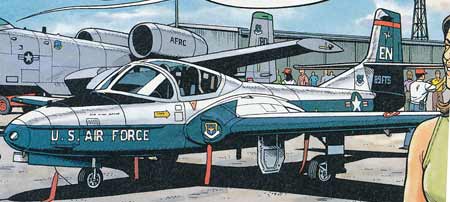 |
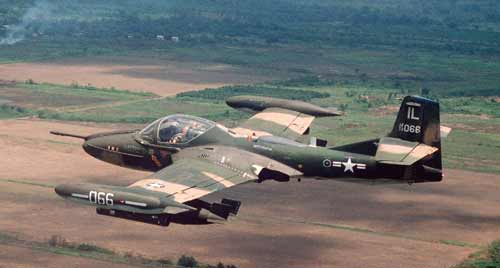 |
The Cessna A-37 Dragonfly, or Super Tweet, is an American light attack aircraft developed from the T-37 Tweet basic trainer in the 1960s and 1970s by Cessna of Wichita, Kansas. The A-37 was introduced during the Vietnam War and remained in peacetime service afterward.
A total of 577 A-37Bs were built, with 254 delivered to the South Vietnamese Air Force. At war's end, the A-37 had flown over 160,000 combat sorties with only 22 USAF losses. Approximately 187 A-37Bs were in South Vietnamese service when the country fell. Ninety-two were recovered by the US, while the other 95 were later used by the Communist Vietnamese in missions over Cambodia and during the China conflict in 1979. These "renegade" aircraft were phased out of service in the late 1970s or early 1980s, in all probability due to lack of spares. Some of the aircraft were shipped to Vietnam's then-Communist allies such as Czechoslovakia, Poland, the Soviet Union and East Germany. Others were sold to private foreign owners. Six examples of the A-37B became property of American warbird fans, while four A-37Bs are now privately owned in Australia and New Zealand.
After the war, the USAF passed their A-37Bs from the USAF Tactical Air Command (TAC) to TAC-gained units in the Air National Guard and Air Force Reserve. In the early 1980s these aircraft were assigned to the FAC (Forward Air Control) role and given the designation OA-37B. The OA-37Bs were eventually phased out in the 1980s and 1990s and replaced in the FAC mission by the much more formidable Fairchild Republic A-10 Thunderbolt II in Regular Air Force, Air National Guard and Air Force Reserve service.
OA-37s from the 24th Composite Wing's (later 24th Wing's) 24th Tactical Air Support Squadron (24 TASS) also saw service during Operation Just Cause.
|
The Cessna T-37 Tweet (designated Model 318 by Cessna) is a small, economical twin-engined jet trainer-attack type aircraft which flew for decades as a primary trainer for the United States Air Force (USAF) and in the air forces of several other nations. The A-37 Dragonfly variant served in the light attack role during the Vietnam War and continues to serve in the air forces of several South American nations.[1][2]
The T-37 served as the U.S. Air Force's primary pilot training vehicle for over 52 years after its first flight. After completing Primary in the Tweet, students moved on to other advanced Air Force, Navy, Marine Corps or Allied trainers. With a total of 1,269 Cessna T-37s built, the USAF retired its last T-37 in 2009.
|
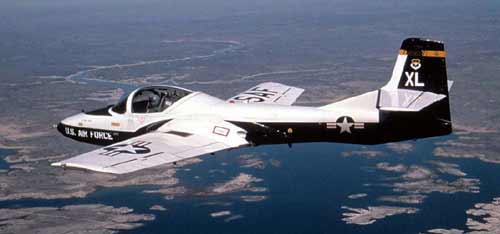 |
|
North American T-39 Sabreliner |
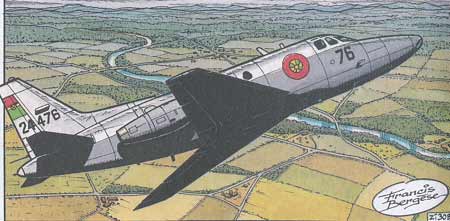 |
A North American T-39 Sabreliner of the Manguan Air Force is show by Bergese in the stories ZONE INTERDITE and TONNERRE SUR LA CORDILLERE |
The North American Sabreliner, later sold as the Rockwell Sabreliner, is a mid-sized business jet developed by North American Aviation. It was offered to the U.S. Air Force in response to their Utility Trainer Experimental (UTX) program. It was named "Sabreliner" due to the similarity of the wing and tail to North American's F-86 Sabre jet fighter." Military variants, designated T-39 Sabreliner, were used by the U.S Air Force, U.S. Navy and U.S. Marine Corps after the Air Force placed an initial order in 1959. The Sabreliner was also developed into a commercial variant.
|
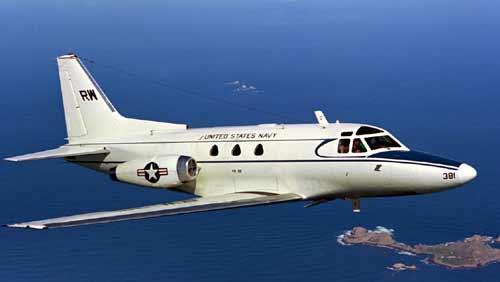 |
 |
Some US Marines Bell AH-1 SuperCobra areshow by Bergese in the story TONNERRE SUR LA CORDILLERE |
The Bell AH-1 SuperCobra is a twin-engine attack helicopter based on the United States Army's AH-1 Cobra. The twin Cobra family includes the AH-1J SeaCobra, the AH-1T Improved SeaCobra, and the AH-1W SuperCobra. The AH-1W is the backbone of the United States Marine Corps's attack helicopter fleet, but is being replaced in service by the Bell AH-1Z Viper.
|
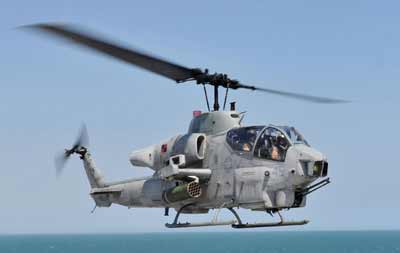 |
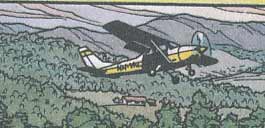 |
A Cessna 205 or 206 seems represented by Bergese in the story ZONE INTERDITE |
The Cessna 205, 206, and 207, known variously as the Super Skywagon, Skywagon, Stationair, and Super Skylane are a family of single-engined, general aviation aircraft with fixed landing gear, used in commercial air service and also for personal use. The family was originally developed from the popular retractable-gear Cessna 210 and is produced by Cessna.
The line's combination of a powerful engine, rugged construction and a large cabin has made these aircraft popular bush planes. Cessna describes the 206 as "the sport-utility vehicle of the air." These airplanes are also used for aerial photography, skydiving and other utility purposes. They can also be equipped with floats, amphibious floats and skis. Alternatively, they can be fitted with luxury appointments for use as a personal air transport.
From 1962 to 2006 Cessna produced 8,509 aircraft in the 205, 206 and 207 variants
|
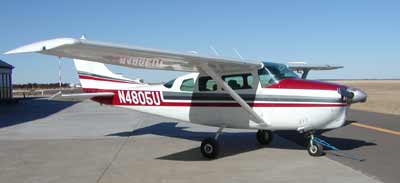 |
|
Dassault-Breguet Super Étendard |
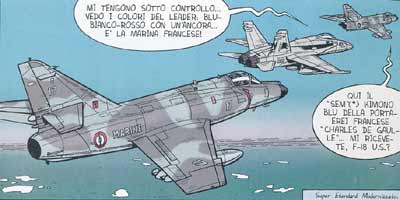 |
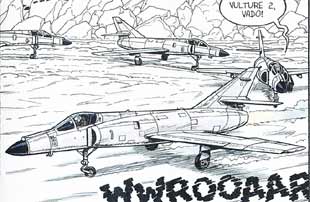 |
Some French Navy Super Etendard Modernise of the aircraft carrier Charles de Gaule and some Super Etendard belong to a mercenary criminal organization are well represented by Bergese in the story MYSTERE EN ANTARCTIQUE |
The Dassault-Breguet Super Étendard (Étendard is French for "battle flag") is a French carrier-borne strike fighter aircraft designed by Dassault-Breguet for service with the French Navy. The aircraft is an advanced development of the Étendard IVM. The Super Étendard first flew in October 1974 and entered French service in June 1978. French Super Étendards have served in several conflicts such as the Kosovo War, the War in Afghanistan and the military intervention in Libya.
The Super Étendard was also operated by Iraq and Argentina, who both deployed the aircraft during wartime. The Super Étendard was used by Iraq to attack oil tankers and merchant shipping in the Persian Gulf during the Iraq-Iran War. Argentina's use of the Super Étendard and the Exocet missile during the 1982 Falklands War led to the aircraft gaining considerable popular recognition. In French service, the Super Étendard is to be replaced by the Dassault Rafale by roughly 2016.
The aircraft undertook its final carrier launch with the French Navy on 17 March 2016, ahead of its withdrawal from service on 12 July 2016
|
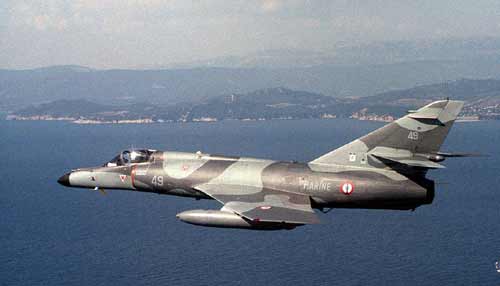 |
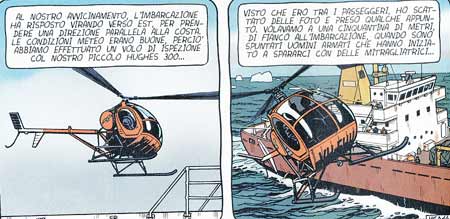 |
A light utility helicopter Sikorsky S-300 is also represented by Bergese in the story MYSTERE EN ANTARCTIQUE |
The Sikorsky S-300 (formerly Hughes 300 and Schweizer 300) family of light utility helicopters was originally produced by Hughes Helicopters, as a development of the Hughes 269. Later manufactured by Schweizer Aircraft, the basic design has been in production for almost 50 years. The single, three-bladed main rotor and piston-powered S-300 is mostly used as a cost-effective platform for training and agriculture.
The Hughes 269 was created with a fully articulated, counter-clockwise rotating, three-bladed main rotor, and a two-bladed tail rotor that would remain as distinctive characteristics of all its variants. It also has shock absorber-dampened, skid-type landing gear. The flight controls are directly linked to the control surfaces of the helicopter so there are no hydraulics in the 269. There are generally two sets of controls, although this was optional on the civil 269A. For three-seat aircraft, the middle collective control stick is removable and a seat cushion can be put in its place for the third passenger. In the 300CB and 300CBi, the collective control can be repositioned to left-handed configuration for the Pilot In Command position (right seat).
|
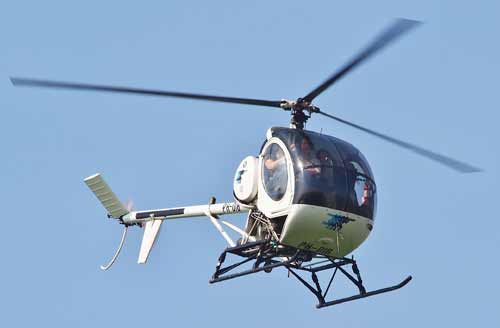 |
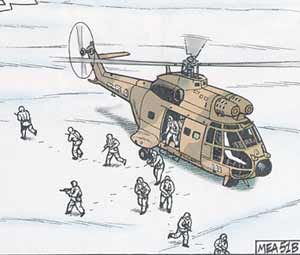 |
A French army transport/utility helicopter SA 330 Puma is represented by Bergese in the story MYSTERE EN ANTARCTIQUE |
The Aérospatiale SA 330 Puma is a four-bladed, twin-engined medium transport/utility helicopter. The Puma was originally built by Sud Aviation of France, and continued to be made by Aérospatiale. It was also license-built in Romania as the IAR 330; an advanced, unlicensed derivative, the Atlas Oryx, was made in South Africa. The Puma was a commercial success and was quickly developed into more advanced models such as the AS332 Super Puma and AS532 Cougar, manufactured by Eurocopter since the early 1990s. These descendants of the Puma remain in production in the 21st century.
The Puma has seen combat in a range of theatres by a number of different operators; significant operations include the Gulf War, the South African Border War, the Portuguese Colonial War, the Yugoslav Wars, the Iraq War, and the Falklands War. The type also saw popular use in the civilian field and has been operated by a number of civil operators.
|
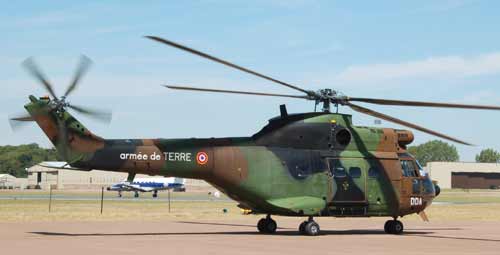 |
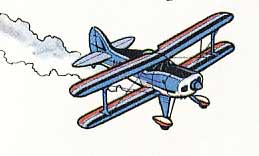 |
An aerobatic biplane Pitts Special is represented by Bergese in the story SABOTAGE AU TEXAS |
The Pitts Special (company designations S1 and S2) is a series of light aerobatic biplanes designed by Curtis Pitts. It has accumulated many competition wins since its first flight in 1944. The Pitts biplanes dominated world aerobatic competition in the 1960s and 1970s and, even today, remain a potent competition aircraft in the lower categories.
|
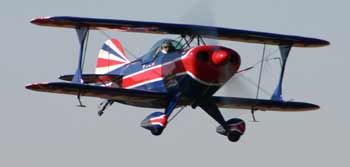 |
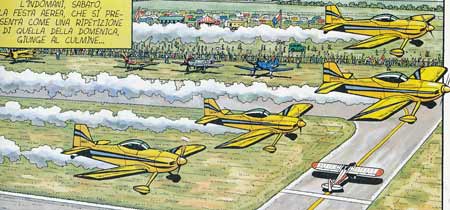 |
An aerobatic team with RV-3 is well represented by Bergese in the story SABOTAGE AU TEXAS |
The Van's RV-3 is a single-seat, single-engine, low-wing kit aircraft sold by Van's Aircraft. Unlike many other aircraft in the RV line the RV-3 is only available as a tail-wheel equipped aircraft, although it is possible that some may have been completed by builders as nose-wheel versions. The RV-3 is the genesis design for the rest of the RV series, all which strongly resemble the RV-3. The RV-4 was originally developed as a two-seat RV-3.
|
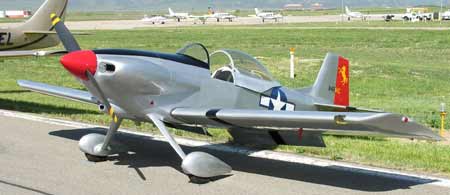 |
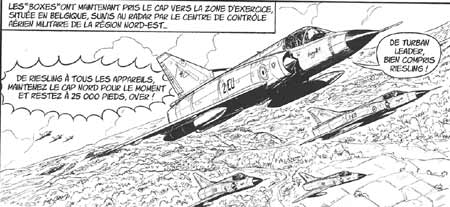 |
Some Mirage IIIC of the French Squadron "Les Cigognes" based in the Dijon Air Base are shown by Philippe in the short crossover adventure LA RENCONTRE |
A Mirage IIIC of the private company Black Jet is fown by Buck Danny in the story AIR FORCE ONE |
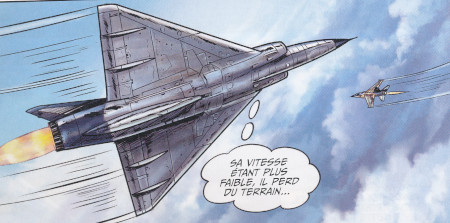 |
The Dassault Mirage III is a family of single-seat, single-engine, fighter aircraft produced by Dassault Aviation for the French Air Force and widely exported. Prominent operators included Australia, Argentina, South Africa, Pakistan and Israel, as well as a number of nonaligned nations. Though an older design, the second generation fighter is still a fairly maneuverable aircraft and an effective opponent in close range dogfighting. In French service it was armed with air-to-ground ordnance or R.550 Magic air-to-air missiles.
The versatility of the design enabled production of trainer, reconnaissance and ground-attack versions as well as the Dassault Mirage 5, Dassault Mirage IIIV and Atlas Cheetah variants. A Mirage III was the first Western European combat aircraft to exceed Mach 2 in horizontal flight.
|
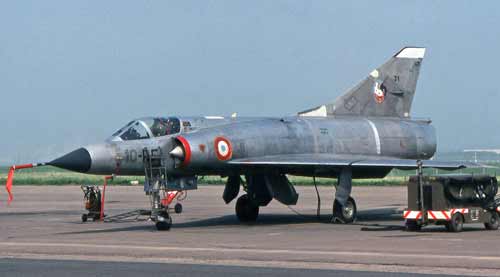 |
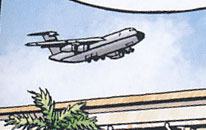 |
An USAF C-5 Galaxy is visible on a frame of the story LES OISEAUX NOIRS |
The Lockheed C-5 Galaxy is a large military transport aircraft originally designed and built by Lockheed, and now maintained and upgraded by its successor, Lockheed Martin. It provides the United States Air Force (USAF) with a heavy intercontinental-range strategic airlift capability, one that can carry outsize and oversize loads, including all air-certifiable cargo. The Galaxy has many similarities to its smaller Lockheed C-141 Starlifter predecessor, and the later Boeing C-17 Globemaster III. The C-5 is among the largest military aircraft in the world.
The C-5 Galaxy's development was complicated, including significant cost overruns, and Lockheed suffered significant financial difficulties. Shortly after entering service, cracks in the wings of many aircraft were discovered and the C-5 fleet was restricted in capability until corrective work was completed. The C-5M Super Galaxy is an upgraded version with new engines and modernized avionics designed to extend its service life beyond 2040.
The USAF has operated the C-5 since 1969. In that time, the airlifter supported US military operations in all major conflicts including Vietnam, Iraq, Yugoslavia and Afghanistan, as well as allied support, such as Israel during the Yom Kippur War and operations in the Gulf War. The Galaxy has also been used to distribute humanitarian aid and disaster relief, and supported the US Space Shuttle program.
|
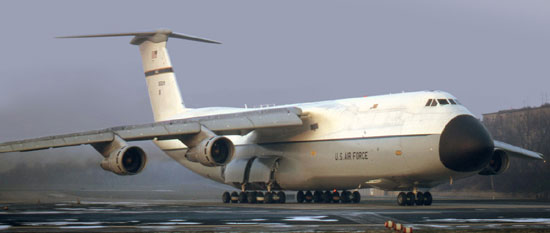 |
 |
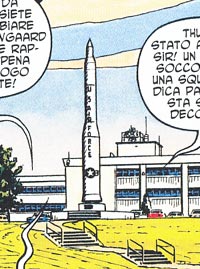 |
A Minuteman II as gate guardian at SAC AFB Offutt AFB near Omaha in Nebraska is depicted by Bergese in the story MISSION APOCALYPSE |
The LGM-30 Minuteman is a U.S. land-based intercontinental ballistic missile (ICBM), in service with the Air Force Global Strike Command. As of 2017, the LGM-30G Minuteman III version is the only land-based ICBM in service in the United States.
Development of the Minuteman began in the mid-1950s as the outgrowth of basic research into solid fuel rocket motors which indicated an ICBM based on solids was possible. Such a missile could stand ready for extended periods of time with little maintenance, and then launch on command. In comparison, existing U.S. missile designs using liquid rocket propellant required a lengthy fueling process immediately before launch, which left them open to the possibility of surprise attack. This potential for immediate launch gave the missile its name; like the Revolutionary War's Minutemen, the Minuteman was designed to be launched on a moment's notice.
Minuteman entered service in 1962 as a weapon tasked primarily with the deterrence role, threatening Soviet cities with a second strike countervalue counterattack if the U.S. was attacked. However, the development of the U.S. Navy's Polaris missile, which addressed the same role, allowed the Air Force to modify Minuteman into a weapon with much greater accuracy with the specific intent of allowing it to attack hardened military targets, including Soviet missile silos. The Minuteman-II entered service in 1965 with a host of upgrades to improve its accuracy and survivability in the face of an anti-ballistic missile (ABM) system the Soviets were known to be developing. Minuteman-III followed in 1970, using three smaller warheads instead of one large one, which made it difficult to attack because the ABMs would have to hit all three widely separated warheads to be effective. Minuteman-III was the first multiple independently targetable reentry vehicle (MIRV) ICBM to be deployed. Each missile can carry up to three thermonuclear weapons, and were initially armed with the W62 warhead with a yield of 170 kilotons.
|
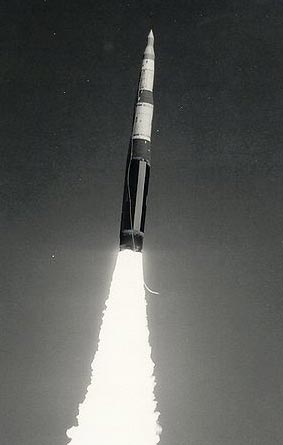 |
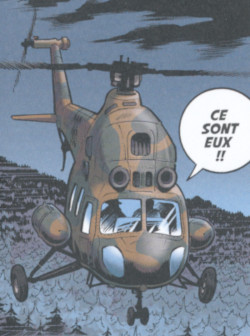 |
Some East German Mil Mi-2 (NATO reporting name Hoplite) is represented by Arroyo in the Buck Danny classic # 5 and #6 OPERATION RIDEAU DE FER and ALERTE ROUGE |
The Mil Mi-2 (NATO reporting name Hoplite) is a small, lightly armored turbine-powered transport helicopter that could also provide close air support when armed with 57 mm rockets and a 23 mm cannon.
The Mi-2 was first introduced into the Soviet Air Force in 1965. The Mi-2 is used by mainly former Soviet and Eastern Bloc countries, although it was also purchased by Mexico and Myanmar armed forces.
Most of the armed Mi-2 variants were used by Poland. Some were also used by the former East Germany (with machine gun and unguided rocket armament only).
North Korea still maintains a large active fleet of Mi-2s.
|
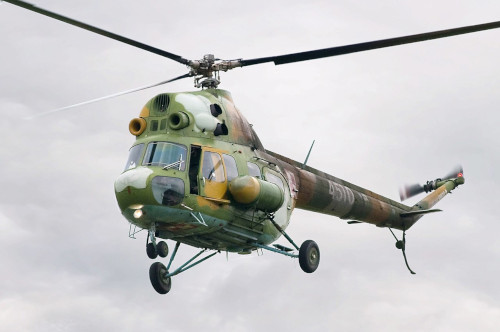 |
|
Otto Lilienthal style gliders |
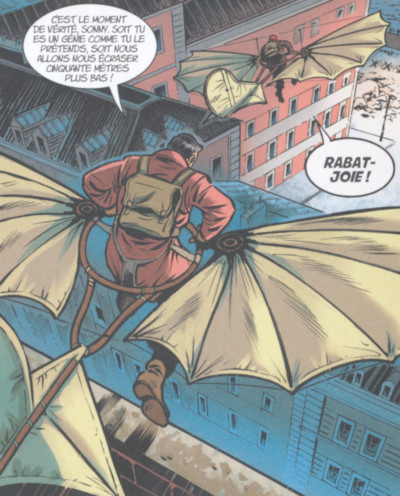 |
Sonny Tuckson and Jerry Tumbler escape from the East Berlin using two Otto Lilienthal style glaiders in the classic story #6 ALERTE ROUGE |
Karl Wilhelm Otto Lilienthal (23 May 1848 – 10 August 1896) was a German pioneer of aviation who became known as the "flying man". He was the first person to make well-documented, repeated, successful flights with gliders. Newspapers and magazines published photographs of Lilienthal gliding, favorably influencing public and scientific opinion about the possibility of flying machines becoming practical. On 9 August 1896, his glider stalled and he was unable to regain control. Falling from about 15 m (50 ft), he broke his neck and died the next day, 10 August 1896.
|
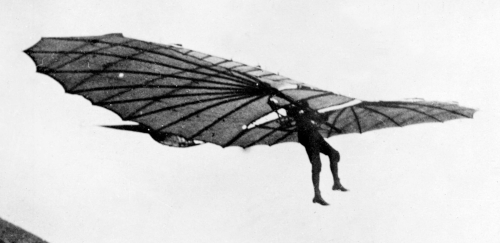 |
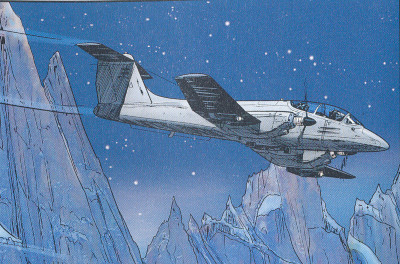 |
A Pucarà is represented by Formosa in the story OPERATION VEKTOR |
The FMA IA 58 Pucará (Quechua: Fortress) is an Argentine ground-attack and counter-insurgency (COIN) aircraft manufactured by the Fábrica Militar de Aviones. It is a low-wing twin-turboprop all-metal monoplane with retractable landing gear, capable of operating from unprepared strips when operationally required. The type saw action during the Falklands War and the Sri Lankan Civil War.
Fixed armament of the Pucará is about comparable with WWII era aircraft, directly comparable with the layout used in the German Bf 110. It consists of two Hispano 804 20 mm cannons mounted under the cockpit with 270 rounds each and four 7.62 mm Browning FN machine guns mounted on the sides of the fuselage with 900 rounds each. Three hardpoints are fitted for carrying external stores single or in clusters (as example up to six bombs under the fuselage or two rockets under each wing) such as bombs, rockets or external fuel tanks, with one of 1,000 kg (2,200 lb) capacity mounted under the fuselage and the remaining two, of 500 kg (1,100 lb) capacity beneath the wings. Total external weapons load is limited to 1,620 kg (3,570 lb). Onboard armaments are aimed by a simple reflector sight.
|
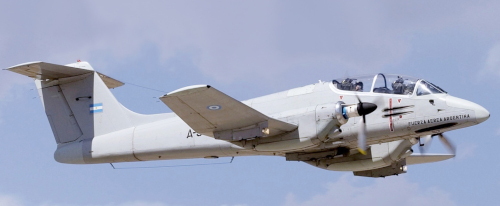 |
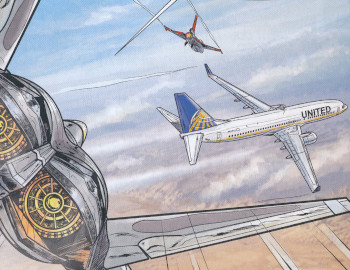 |
a Boeing 737 is represented Formosa in the story PROGRAMME SKYBORG |
The Boeing 737 is a narrow-body aircraft produced by Boeing at its Renton Factory in Washington. Developed to supplement the Boeing 727 on short and thin routes, the twinjet retains the 707 fuselage cross-section and nose with two underwing turbofans. Envisioned in 1964, the initial 737-100 made its first flight in April 1967 and entered service in February 1968 with Lufthansa. The lengthened 737-200 entered service in April 1968. It evolved through four generations, offering several variants for 85 to 215 passengers.
|
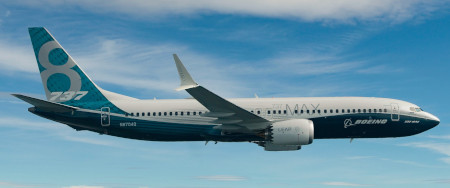 |
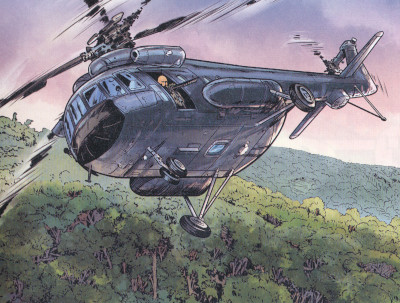 |
A MIL MI-17 used by Sato's organization is represented by Formosa in the story AIR FORCE ONE |
The Mil Mi-17 (NATO reporting name: Hip) is a Soviet-designed Russian military helicopter family introduced in 1975 (Mi-8M), continuing in production as of 2021 at two factories, in Kazan and Ulan-Ude. It is known as the Mi-8M series in Russian service. The helicopter is mostly used as a medium twin-turbine transport helicopter, as well as an armed gunship version.
|
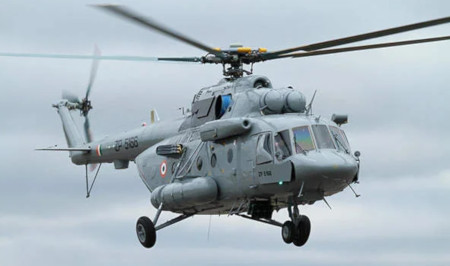 |
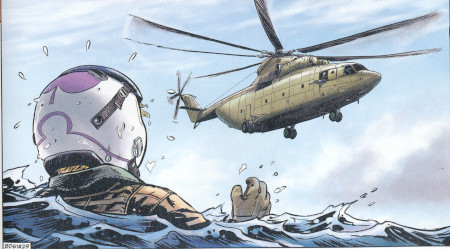 |
A MIL MI-26 is represented by Philippe in the story TRAQUE EN HAUTE ALTITUDE |
The Mil Mi-26 (NATO reporting name: Halo) is a Soviet/Russian heavy transport helicopter. Its product code is Izdeliye 90. Operated by both military and civilian operators, it is the largest helicopter to have gone into serial production.
|
 |
|
|